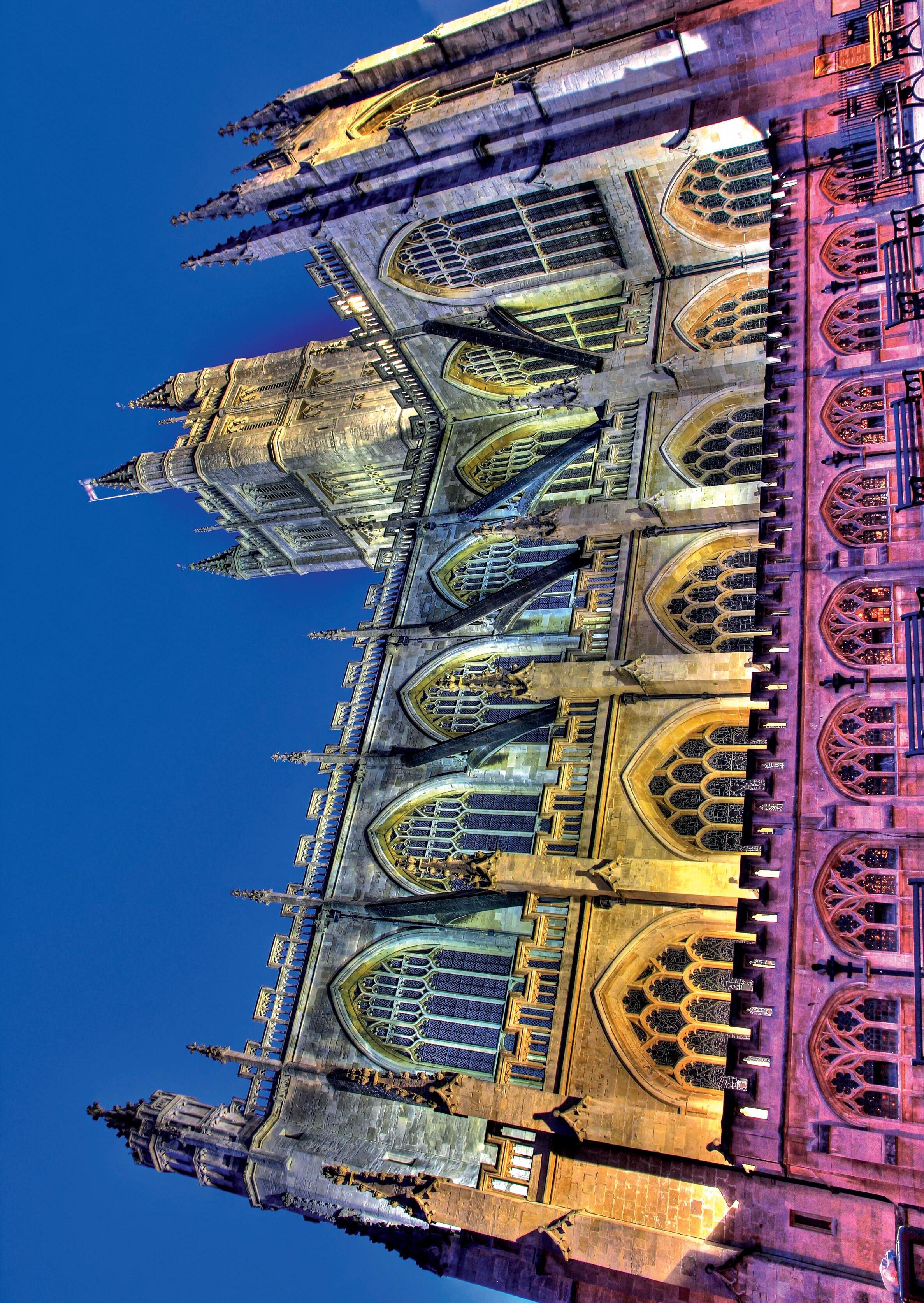CATHEDRAL MUSIC
















We offer four brands of organ each with their own identity, sounds, appearance, technology and style. All our brands share valuable characteristics such as technological innovation and the best sound quality, which is never a compromise. All provide the player with a unique playing experience. A great heritage and tradition are our starting points; innovation creates the organ of your dreams.
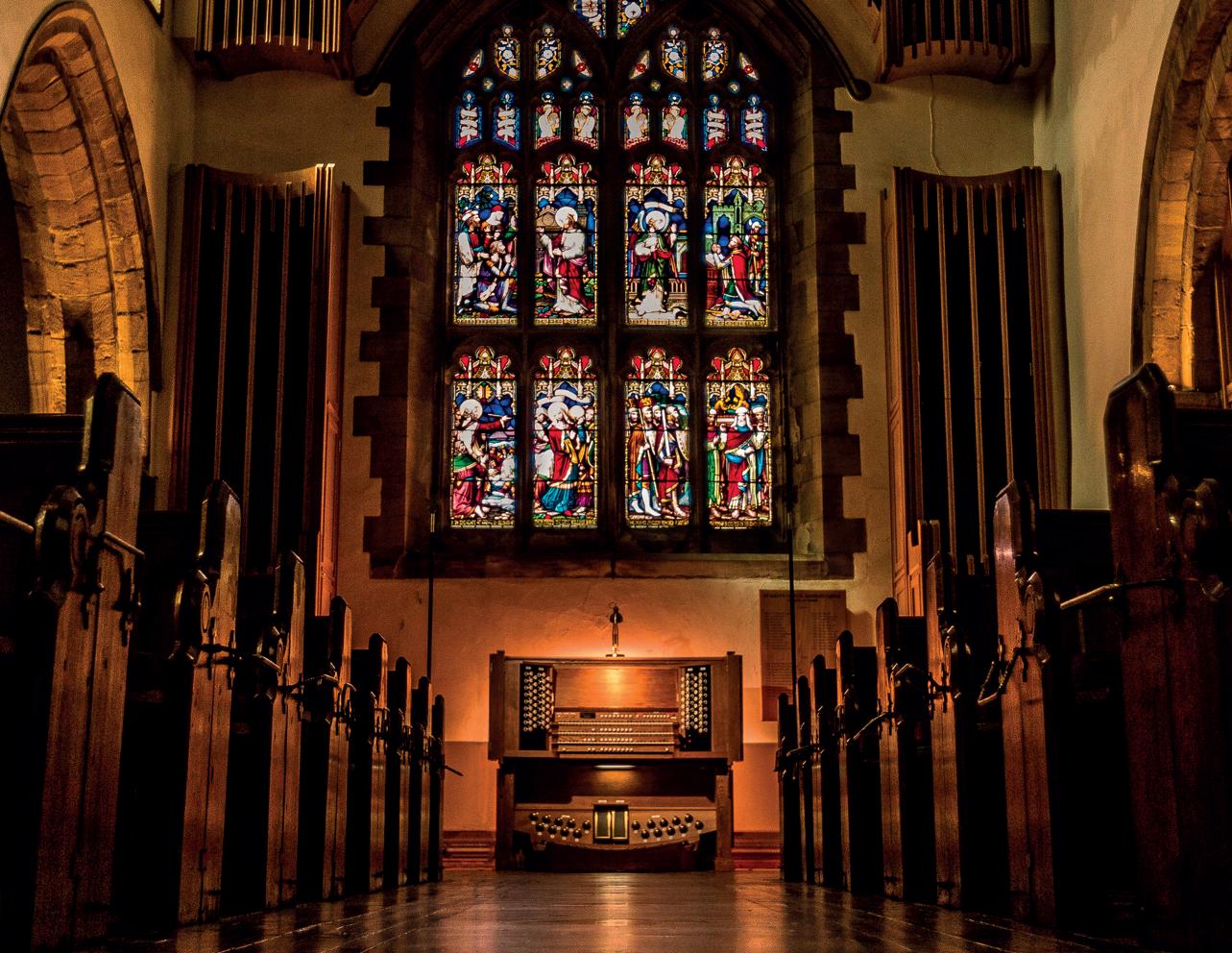
CATHEDRAL MUSIC is published twice a year, in May and November.
ISSN 1363-6960 201
Editor
Mrs Sooty Asquith, 8 Colinette Road, London SW15 6QQ
Editorial Advisers
David Flood & Matthew Owens
Production Manager Graham Hermon
FCM Email info@fcm.org.uk
Website www.fcm.org.uk
The views expressed in articles are those of the contributor and do not necessarily represent any official policy of Friends of Cathedral Music. Likewise, advertisements are printed in good faith. Their inclusion does not imply endorsement by FCM.
All communications regarding advertising should be addressed to: Tatton Media Solutions, 9 St Lawrence Way, Tallington, Stamford PE9 4RH 01780 740866 / 07738 632215 wesley.tatton@btinternet.com
All communications regarding membership should be addressed to: FCM Membership, 27 Old Gloucester Street, London WC1N 3AX
Tel: 020 3637 2172
International: (+44) 1727-856087 info@fcm.org.uk
Every effort has been made to determine copyright on illustrations used. We apologise for any mistakes we may have made. The Editor would be glad to correct any omissions.
Designed and produced by: DT Design, 1 St Wilfrids Road, Ripon HG4 2AF 07828 851458 d.trewhitt@sky.com
Cover photographs
Front Cover Christ Church Cathedral
Back Cover
Bath Abbey
51
52
56
Receive your first year membership of the Royal College of Organists FREE, with your home practice organ purchase

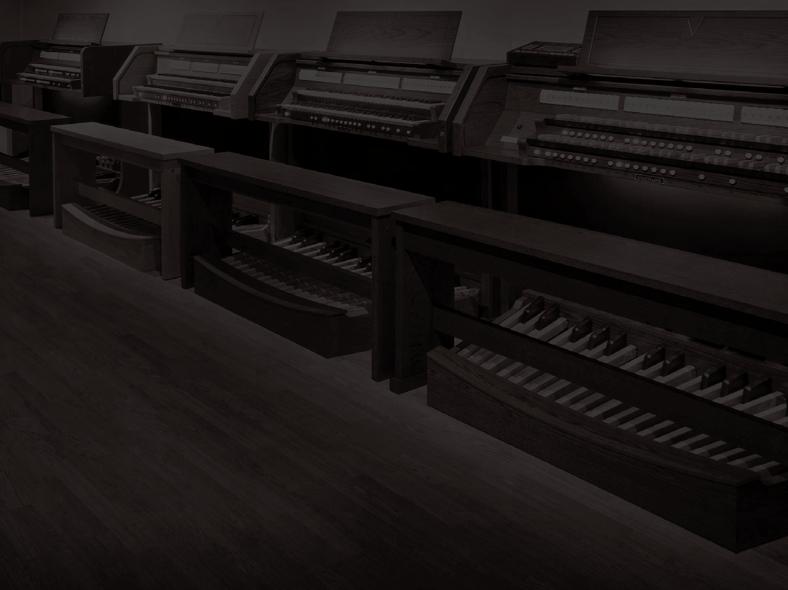

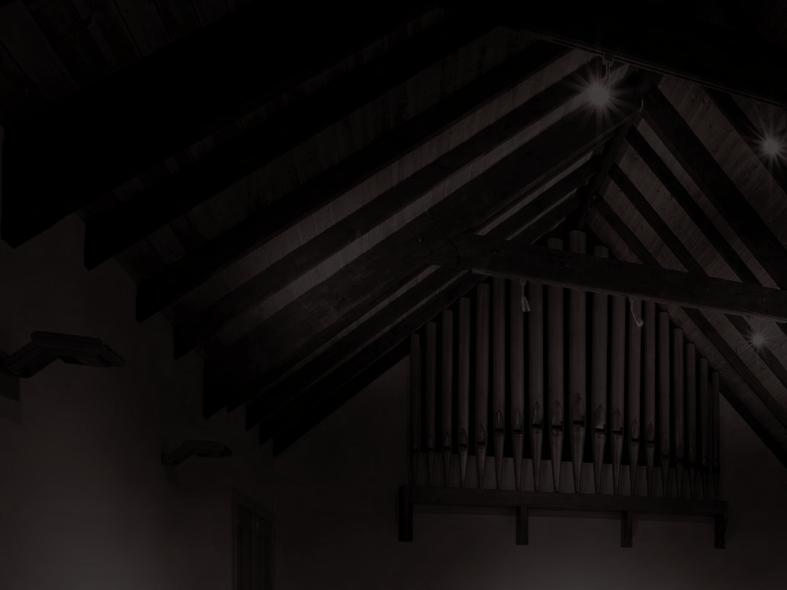
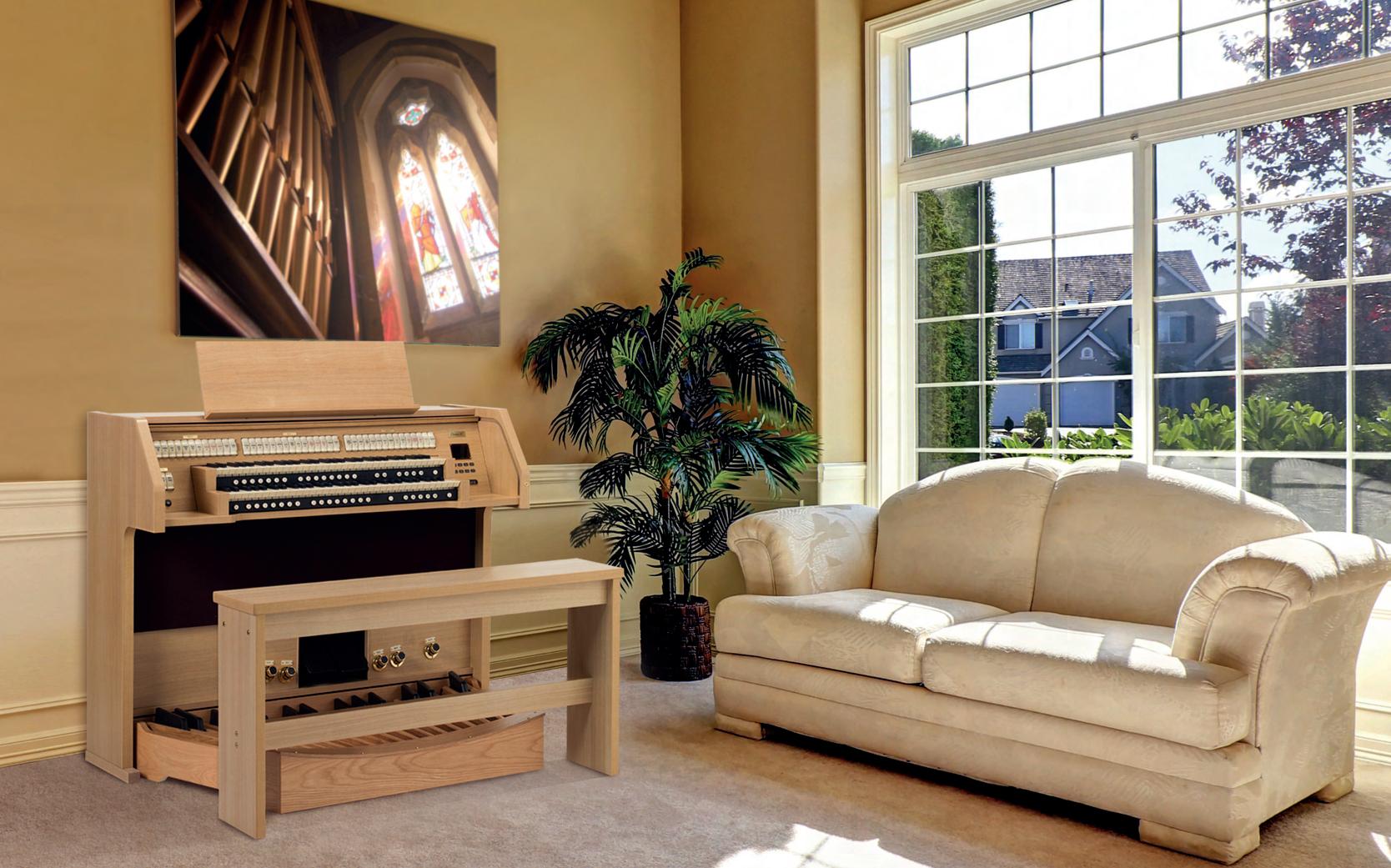

Our new range of sampled sound instruments offer: More internal speakers More detailed sampling with a greater number of sample points Internal solid state recording facility
See and play the new range in Bicester or at regional dealers

Irvine ......................Soundtec Organs
Orchestral voices on all models A full range of models starts from £6000

To learn more or book an appointment to play, contact us on
01869 247 333
Edinburgh ..............Key Player
Morecambe ...........Promenade Music
Porthmadog ...........Pianos Cymru
Leigh ......................A Bogdan Organs
Swansea ................Music Station
Norwich .................Cookes Pianos
Bandon ..................Jeffers Music
Exeter ....................Music Unlimited
Ballymena ..............Nicholl Brothers
Londonderry ............Henderson Music
Belfast ......................Keynote Organs
Just before the May edition of this magazine was printed, the new FCM website went live (www.fcm.org.uk). Take a look: it is worth your time and attention, with a more contemporary feel, frequently updated information pages, and a list of all Gatherings taking place round the country. Christmas cards and other FCM merchandise (pens, tote bags, notelets, ties, CDs etc) may also be purchased without hassle, and there are easy links for those wishing to join or donate.
Many FCM members will have already bought copies of the Jubilate CD for their friends. Those who have not, please do so if you can, either through the website or at a Gathering or via the insert that comes with this magazine. Alternatively, you can type ‘Jubilate 500’ into Google, which will bring up various alternatives. The CD is currently No. 2 in the classical music bestseller albums and has sold over 10,000 copies worldwide. We would very much like to sell many more copies, however, since some of the royalties will help to swell the coffers of FCM and the Diamond Fund for Choristers, and also because the disc is a perfect example of the music we exist to support. If you Google ‘Jubilate 500 YouTube’ you can watch the excellent promotional video.
Many people, if asked to name a work by John Joubert, will mention his immaculate carol There is no rose, or perhaps Torches (both in the Carols for Choirs series). Not so many are aware of his other works (two symphonies, four concertos, four oratorios, seven operas, and more). The recording of his most recent opera, Jane Eyre, was released on his 90th birthday earlier this year, and he is still composing. Howard Friend, his long-time publisher, writes of Joubert’s life and musical
development, both in South Africa (where he was born and grew up) and then in the UK; Joubert’s style has many echoes of the Anglican choral tradition in which he immersed himself as a young man, but his voice is decidedly his own and his works greatly repay further listening.
Another composer, another celebration: Francis Jackson was 100 in October 2017. Through the pages of his autobiography, Music for a Long While, and through his organ works, Andrew McCrea examines the influences on Jackson (amongst others Sir Edward Bairstow, his predecessor, mentor and teacher) and his evolution as a composer, in particular of organ sonatas, a genre which survives in Britain in no small part thanks to Professor Jackson’s contribution.
What would music in cathedrals have been like when FCM was in its infancy? Timothy Storey on FCM’s behalf has researched many old recordings to find out. If you follow his guidance you can hear much of what he has been listening to, and may be amused to note the differences between then and now, not least, of course, in terms of pronunciation. As with HM Queen, so with choirboys: ‘handmaiden’ is no longer pronounced ‘hendmaiden’! And, presumably, no longer do Masters of the Choristers interpret their titles literally and decline to rehearse the ‘back row’.
An offer: the Institute of British Organ Building is offering at a reduced price to FCM members (10% off the list price of £10 or £12) past copies of its signature magazine, Organ Building, the highly acclaimed publication written by organ-builders, consultants and players. Order through ‘administrator@ibo.co.uk’, having looked at (but not ordered through) their website, www.ibo.co.uk/webStore/index.php.
And if magazines don’t appeal as a Christmas present, why not hand to a fortunate recipient an FCM membership gift voucher, available through the website?
Sooty AsquithLog onto www.fcm.org.uk and fill in the form, or write to/email the address given on p3.
Member benefits include:
•welcome pack
•twice-yearly colour magazine and twice-yearly colour newsletter
•‘Singing in Cathedrals’: a pocket-sized guide to useful information on cathedrals in England, Ireland, Scotland and Wales
Opportunities to:
•attend gatherings in magnificent cathedrals
•meet others with a shared interest in cathedral music •enjoy talks, master-classes, choral and organ performances etc.
Subscription
UK members are asked to contribute at least £20 per year (£25 sterling for European members and £35 sterling for overseas members). UK choristers and full-time UK students under 21 qualify for a reduced rate of £10. New members subscribing at least £30 (standing order) or £50 (single payment) will receive a free fulllength CD of cathedral music, specially compiled for FCM members.
FCM’s purpose is to safeguard our priceless heritage of cathedral music and support this living tradition. We strive to increase public awareness and appreciation of cathedral music, and encourage high standards in choral and organ music. Money is raised by subscriptions, donations and legacies for choirs in need.
Since 1956 we have given over £ million to Anglican and Roman Catholic cathedral, church and collegiate chapel choirs in the UK and overseas; endowed many choristerships; ensured the continued existence of a choir school, and worked to maintain the cathedral tradition. Please join now and help us to keep up this excellent work.

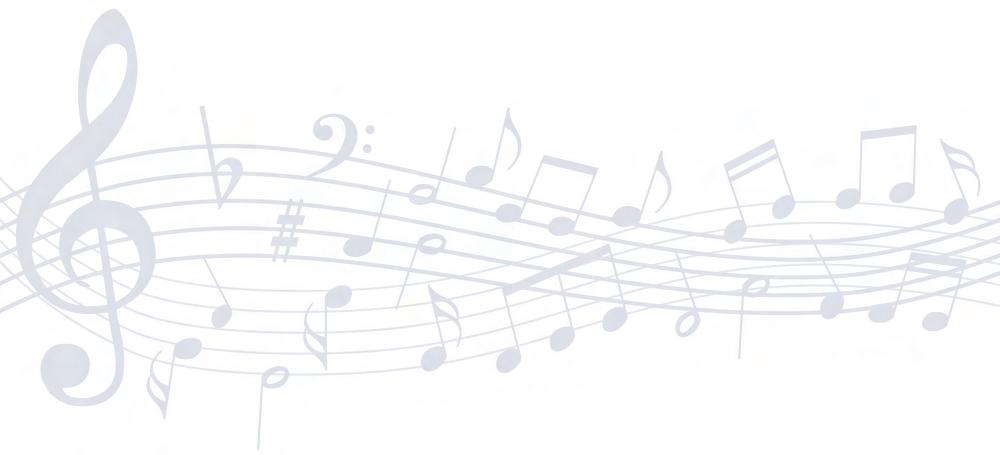

me through the key inspirational moments: his early desire to follow in the footsteps of his father, who was a gifted artist and draughtsman, and then his interest in music, which came later. His mother, a talented pianist and student of Harriet Cohen, played duets with him, a useful but limited early introduction to classical music. There was little or no exposure to chamber music or opera in South Africa before and during the war years. This was an interest pursued during evenings of sitting around the gramophone at a music club, with John being 13 or 14 years old at the time. These gatherings of enthusiasts, which inspired in him the urge to write, were conducted by Austrian émigrés in Cape Town. There were other epiphanies: I felt a moment of recognition when he described how thrilling it was to see a page of full score, whatever the work was, an illustration in Arthur Mee’s The Children’s Encyclopaedia, the multi-volume book that for half a century influenced generations of sons and daughters of the Empire with its extraordinary images. These made an understandably deep impression on the junior Joubert, even in distant Cape Province.
Returning to meet John Joubert in his Birmingham home of the past 54 years was in itself an experience for me, having last crossed that threshold as an undergraduate in the early 1970s. To students of the rebellious sit-in years, John always seemed an elder statesman, his discussion calm and succinctly expressed. Never one to race to a remark not fully considered, that part of his personality remains unchanged in this year of his 90th birthday. Mobility may be more limited (so that he no longer trails clouds of silent glory for us as he once did around the Barber Institute Music Department), but there is no mistaking the man, his appearance, his speech. Not only are Mary and he long settled in Moseley, but they have been together for over 60 years. Their two children are both in the arts, his daughter, Anna, a cellist, very much in evidence, also living in the West Midlands. Such stability is hardly the standard image of a professional composer who can number almost 200 works in his output. But one so outwardly internalised may simply carry reserve into all aspects of his life, preferring to express himself through his musical creations.
During our meeting, he was willing to talk to me about his early life and formative years in Cape Town and after. He took
As so often, separation from fellow youngsters was a catalyst for creativity; thus, six weeks of quarantine confinement at home with a younger sister who had caught scarlet fever encouraged in him a need both to listen to more music and to write, himself, in more concentrated fashion. The disadvantage was that he had to rule his own manuscript paper, even for the resultant orchestral work. Duly impressed with the endeavour, however, his mother took the score to W H Bell, a composition teacher whom she had known in London before 1914, the year he had emigrated to South Africa. Without commenting on the musical content, Bell was sufficiently convinced of a talent, by the sheer creative urge in the teenager, to recommend a more formal study of music at school. The price to pay was the doubtless welcome dropping of mathematics in favour of what was to be his vocational subject.
Joubert’s compositional gift matured fast and he heard his works performed even before leaving Cape Town after the War. Following his PRS scholarship to the Royal Academy, he arrived in London, memorably for him, aboard SS Winchester Castle, still then tricked out as a troop ship. His composition teachers included Howard Ferguson and Alan Bush, the latter he recalls more for his powerful instruction than his radical politics.
His first string quartet was heard by Basil Ramsey at Novello, to which publisher Joubert was subsequently signed, as he is to this day (their longest surviving relationship with a composer). That was in 1950, in their grand Edwardian offices in Wardour Street, the atmosphere of which at the time he described as being that of a high-class undertaker!
John’s early compositional background is surprisingly diverse, even stretching to one or two film scores from the 1950s: a public information documentary on the Orange River District of South Africa, and another about the materials needed for making furniture. Joubert relates such things with his customary detachment, while allowing pregnant pauses.
It seems that a distinguished but little explored conducting career began with his appointment to a lectureship at Hull University in 1950, with the provision of a choir all to himself. He was not, however, entirely new to the game, having conducted in a less regular way at the Royal Academy. A generation of undergraduates, myself included, at Birmingham University will recall the weekly, more or less obligatory Motet Choir rehearsals, not, as I look back over four years, conducted by anyone but Mr Joubert – it wouldn’t have worked! – though occasionally there would be a distinguished eavesdropper: a youthful Gordon Crosse sat in on our Laetabundus exsultet. Eclectic indeed, we sang not only his own succession of new choral works (‘an occupational hazard’, as he put it) but anything from Handel to Vaughan Williams, Poulenc, Copland, Hindemith, Britten, Tippett, Maxwell Davies, Richard Rodney Bennett, Williamson… Fellow composer Peter Dickinson has commented on the fact that the Birmingham Motet Choir sang his The Dry Heart as proof of what a high-quality choral conductor Joubert must have been, working with an unauditioned undergraduate choir, something that is clear also in that choir’s performance on record of Joubert’s Four Latin Motets.
What about his music? Joubert’s reputation rests largely upon his output of small-scale choral settings, through which the reach of his popularity is considerable, even international. But I feel that the soul of Joubert is found in his less-often performed, more sustained works. As a result, as with many other composers (think of Bruckner or Schubert), he applies a symphonic-scale sensibility to his choral miniatures. He is a composer of considerable range. Rather than the miniature choral gems we should look to the larger-scale works for a more personal statement. There is a predominantly angry feel in works like South of the Line (see the review on p59), as
you would expect for settings of Thomas Hardy’s (essentially) war poems with a strong link to the Anglo-Boer War. But it is there, too, in the symphonies: the relentless, driving rhythms, the motifs repeated over and over across the orchestra, to an almost obsessive degree, even in the accompanied choral works, an organ part that seems often to contradict rather than support the chorus, an added layer to an already involved vocal counterpoint. This comes across at odds with the softspoken, gentle giant whom we meet, almost a dichotomy in his personality that lends it a fearsome authority.
Of great interest are his stage works, including five fulllength operas. His response to questions on his choice of work tends to the professional rather than strictly intellectual – perhaps he is too much the essential musician and man of the theatre, more a Richard Strauss than a Wagner. Or perhaps it is the noticeable reserve and unwillingness to leave clues or to explain. Certainly, his themes display a catholic and heavyweight choice for opera, taken from Conrad and Charlotte Bronte, George Eliot, even Tolstoy, or an old friend in that denizen of the TLS, Adolf Wood.

Interestingly, one opera that never made it was an intended setting of Alan Paton’s Cry, the Beloved Country, the distinguished
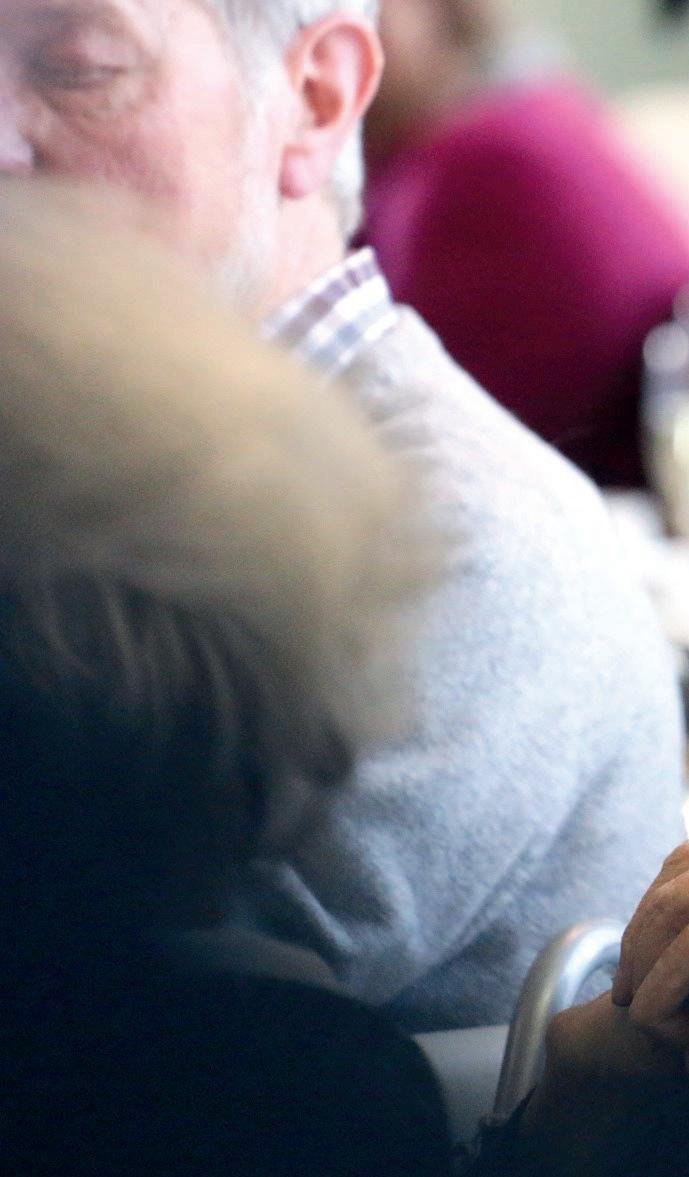
He took me through the key inspirational moments: his early desire to follow in the footsteps of his father, who was a gifted artist and draughtsman, and then his interest in music, which came later.
novel set in South Africa, which foreshadowed many of the dramas later to become manifest in the apartheid years. Joubert had long ago approached the author for his consent to write it but he was pipped at the post by Kurt Weill, who created Lost in the Stars from it within a year of its publication. Paton’s novel eventually found expression for Joubert in his Second Symphony of 1971, along with outrage at other iniquities of the era in South Africa, not least the infamous Pass Laws. If its political message attracted little attention in the UK, it was certainly noted by the authorities in Pretoria.
Despite the once red-hot topic of South Africa and apartheid which dominated the headlines for much of his life, Joubert could not be considered a political commentator. If there is rage or indignation, it is only occasionally spelt out. Even the overtly South African theme of his short opera, In the Drought (1955, libretto by Adolf Wood), has a more universal message. Joubert would most likely argue that Under Western Eyes, though written half a century ago, with its themes of uprising, betrayal and human weakness in the face of a hostile regime, is a work which still has resonance today. He does suggest that it was inspired by the situation in his home country in the 1960s: subversion under the spotlight. Tangentially, he adds that he first got to know of it, and consider his own setting, through
a French film version (Sous les yeux d’Occident) with a score by Georges Auric, which he saw in Cape Town in 1936. And yet, diffuse though the sources may be, there are common themes in Under Western Eyes, Silas Marner, In the Drought, even Jane Eyre, less apparent in Antigone, his first opera. The unwritten Joubert Cry, the Beloved Country may hold the key: it could be broadly summarised as decency and sacrifice being both destructive and redemptive in a hostile or irrational society. Only someone with a love for their country in crisis could grasp the full meaning of such concepts.
There is no doubting the importance for him of a lifetime of teaching and supervision. Of his many years of university teaching, he comments: “It is an excellent way of learning”. The range was considerable as was the requirement of degree courses of the period: I recall his enthusiastic lectures on the likes of Bellini, Rossini, Lassus and Mahler. With his seemingly insouciant delivery of dictums, things tended to stick in the mind: for example, Joubert was greatly surprised by the Austrian/Italian composer Luigi Dallapiccola (1904-1975), who dismissed late Stravinsky serialism as ‘rule-breaking’.
Joubert is no advocate of serialism. His anthem Let there be light starts with all 12 notes of the chromatic scale spread over
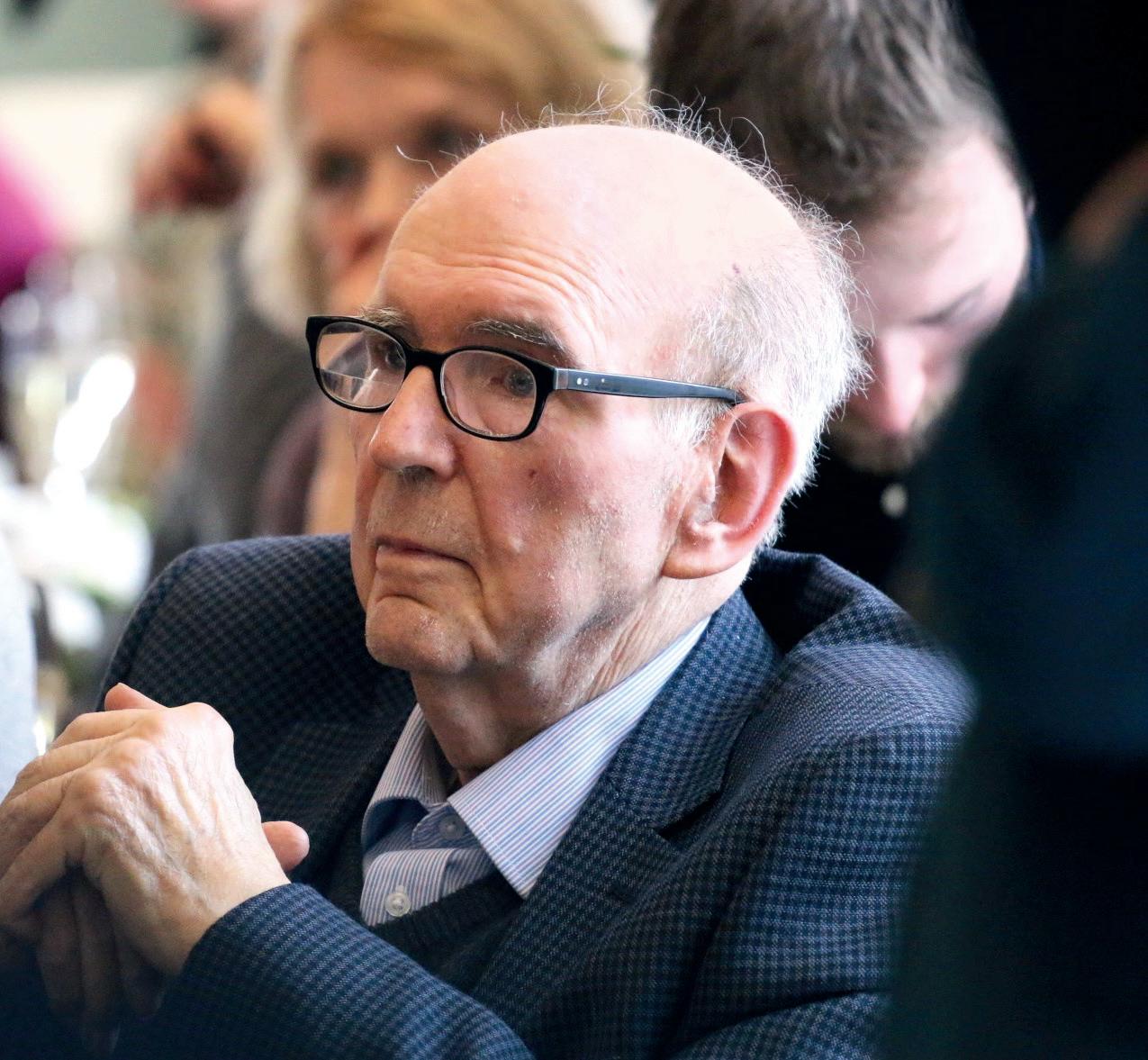
SATB, but that is as far as it goes. Twelve-note music is not so much the shibboleth today that it was in the less pluralistic academic music world of 50 years ago, but Joubert has called it ‘a reach-me-down technique devised by someone who wanted to suppress tonality…but you can’t’. It is, he says, ‘the opposite of creativity’. For a composer of the same generation as Berio, Boulez, Feldman, Henze, Kurtág, Ligeti, Nono and Stockhausen, it is hardly surprising, then, that, among such attention grabbers, Joubert, beavering away far from Darmstadt and Donaueschingen, has had to be patient in order be heard or appreciated generally.
Yet nothing is that simple. He gives me a salutary lesson about William Glock, who, from the late 1950s to early ’70s as the BBC music supremo and Controller of the Proms, gained a reputation for excluding a generation or two of home-grown composers in preference for the European avant-garde or representatives of a radical younger generation, like Birtwistle and Maxwell Davies: “All I can say is that, during the Glock years, I had more broadcasts on the BBC than ever before or since”.
When, in 2007, marking an earlier milestone birthday, a string of new pieces, performances and commemorative interviews took place, Joubert observed that turning 80 was one of his best career moves. Well, a 90th birthday year that has seen the issue of five CDs of hitherto unrecorded work, a third symphony, several choral commissions and a presence in the celebrations of the Hull UK City of Culture 2017 feels neither
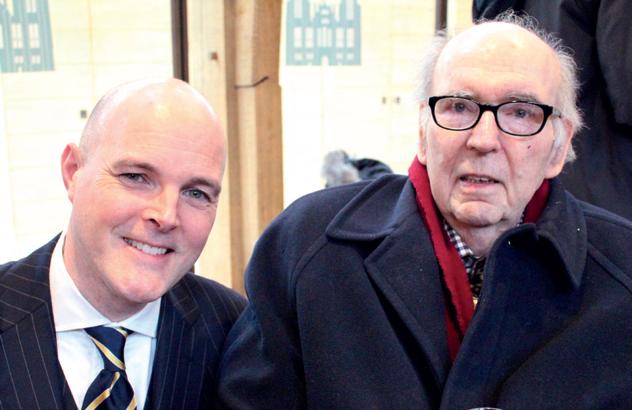

Ifirst had the privilege of working with John Joubert in 2012 when I approached him about commissioning two works from him through our ‘Cathedral Commissions’ scheme. He readily agreed to an unaccompanied Latin Mass (Missa Wellensis) and, after some deliberation, to an unaccompanied setting of Locus iste – the shadow of Bruckner’s beautiful setting initially making him hesitant.
The following year Joubert was our featured composer during our festival new music wells 73-13, and was present for the premieres of Missa Wellensis and Locus iste. These works are incredibly demanding to sing, being almost symphonic in scale, but very welcome additions to the repertoire. Joubert also attended a concert featuring his chamber music (he was interviewed by Howard Skempton in our ‘Composer Conversations’ series), and he gave a composition masterclass at Wells Cathedral School. His modest, warm, and generous presence left a deep impression on all those who met and heard him.
The success of this led me to commission another work from him, a setting of the St Mark Passion. This followed on from Bob Chilcott’s St John Passion which we had
like a falling off of inspiration or public neglect. How enviable he is amongst men!
John Joubertpremiered in 2013 and subsequently recorded. Joubert’s setting is a dramatic and very moving one, using traditional Passiontide hymns from the English Hymnal – in contrast to Chilcott’s setting which incorporated familiar hymn texts with new tunes – and is scored for soloists (including two very extensive and demanding parts for the Narrator and Christ), solo cello, organ, and choir. The contributions required from the choir are relatively modest but most effective. The St Mark Passion was premiered on Palm Sunday in 2016, which also happened to be the composer’s 89th birthday. It is an easily programmable work that deserves to be in the repertoires of cathedral and collegiate choirs, and I hope that our recording of it will encourage choir directors to explore this Passion setting of one of the UK’s most significant composers, and perhaps the other works as well.
Ifounded Siglo de Oro while I was a student at King’s College London. At the start it was really just a group of friends, most of whom were choral scholars in the college’s chapel choir. We were inspired by the experience of singing Renaissance polyphony under the choir’s director, the late David Trendell, to the extent that we wanted to rehearse and perform even more of this repertoire – in our own time! In recent years we have moved from being a student group to becoming a fully-fledged ensemble: in 2014 we made our professional debut at the Spitalfields Festival (the Financial Times said that we ‘performed with vivacity and poise’). We’ve since been invited to give concerts at festivals across the UK, as well as further afield, in Finland and Malta, and have sung live several times on BBC Radio 3’s In Tune. Occasionally we take on other, more unusual projects: in 2016 we worked with composer Emily Hall on her opera-installation ‘Lost and Found’, at the Corinthia Hotel in London. We were praised for our role in the production as ‘the superb a cappella chorus’ by the Observer
Over time, the identity of the singers in the group has gradually changed – although we still have four former King’s College London choral scholars singing regularly in the group – and we now have quite a mix of backgrounds, from singers who have come to us via collegiate choirs or choral schemes, such as the Genesis Sixteen, to those who are simultaneously pursuing vocal training as soloists at one of the London conservatoires.
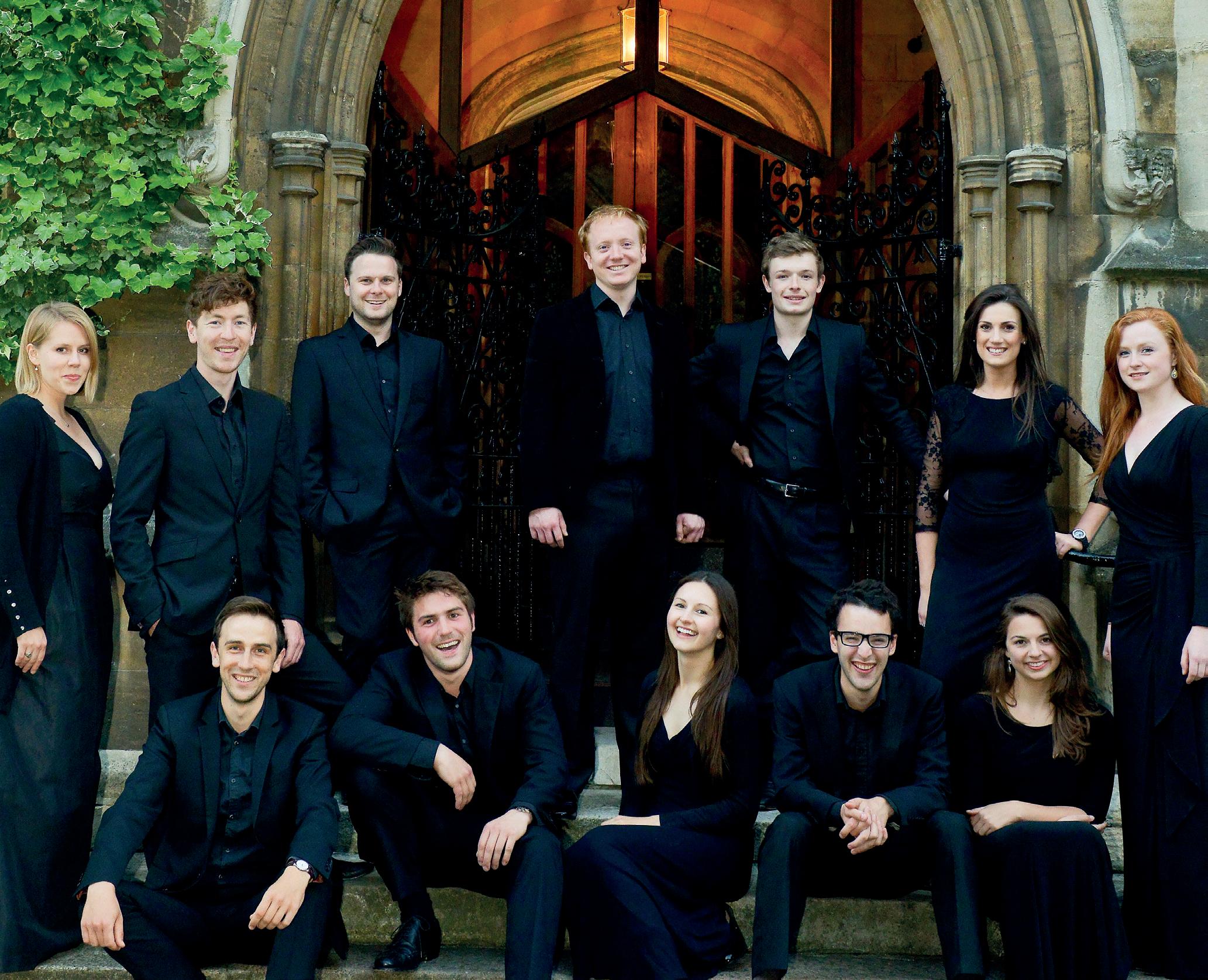
Drop Down, Ye Heavens is our debut CD, and is the result of an ongoing collaboration with classical saxophonist Sam Corkin. It features new settings of the eight Advent antiphons that we commissioned from eight different composers, alongside Renaissance and contemporary pieces that share a sense of mystery and expectation. BBC Music magazine made it a ‘Christmas Choice’ and called it ‘a debut with a difference… a novel, ungimmicky project, vividly executed’, while Gramophone described it as ‘so invigorating... this one hits you with its character and depth’.
In September 2017 we recorded our second disc, again with Delphian Records. This time we focused entirely on early music, and in particular the world premiere recording of Hieronymus Praetorius’ Missa Tulerunt Dominum meum. It’s an exceptionally colourful setting of the Mass, written at the end of the Renaissance and influenced by the very best music emanating from the Low Countries, Northern Germany, and above all, Venice. We’re hugely looking forward to introducing this exciting repertoire into the world in March next year.
In 2018 we have lots of other exciting plans, including two performances at the Barber Institute in Birmingham, our French debut, and a special concert at the Royal Society of Physicians to mark their 500th anniversary.
The pipe organ sits right at the heart of liturgical music in cathedrals, churches and chapels around the world but, like all complex mechanical instruments, over time many thousands of individual components wear out, leather perishes and mechanical defects occur.
When work is required it tends to be an expensive, once-ina-generation operation, and it is generally to a professional organ-builder that any delicate and exacting work is entrusted. It is easy, by checking internet and social media, to follow those companies who photograph and film aspects of their craft and post them online, but who knows where the people behind the specialist craft of organ-building come from, and how does a person interested in a career in this unique craft get started?
The education system today is one that encourages further education, and it seems that fewer people leaving school after GCSEs are actively looking for a job. Many people who graduate with a degree have no job to go to, or perhaps are unsure as to what career they want to pursue. I have long thought that one of the best ways to encourage people into organ-building is to catch them when they are young.
Thanks to the Industrial Revolution during the 19th century, religious feeling in Britain grew as the Church of England
regained energy and many churches were built. These churches required new organs to lead the singing, with the result that there was a huge boom in organ-building. An 1851 survey showed that about 40% of the population went to church, which in a similar survey 30 years later had declined to 33%, and by the late 19th century this had sunk even further. Come the late 20th century, and only a small minority of the population attended church regularly. Now church attendance in the UK stands at 6%, and it is predicted that by 2020 attendance will be down to around 4%. This decline has forced a large number of churches to close, and many fine pipe organs are therefore being left to face an uncertain future (should they be rehomed? Demolished?). And although there is now a steady increase in cathedral attendance, the closure of churches impacts particularly on parish church musicians, many of whom no longer have the volume of people joining their church choirs. This has an obvious knock-on effect, as the children who form the front row of church choirs today would normally -- in the past -- have gone on to form the back row of the future, with their children becoming tomorrow’s front row, and so on. What was once a self-perpetuating circle is now fragmented. This is evident from travelling around the world whilst working on organs: in the various choir photographs that adorn vestry walls there are fewer people in evidence year upon year. Of course some parish churches do buck this trend, but these tend to be the more established
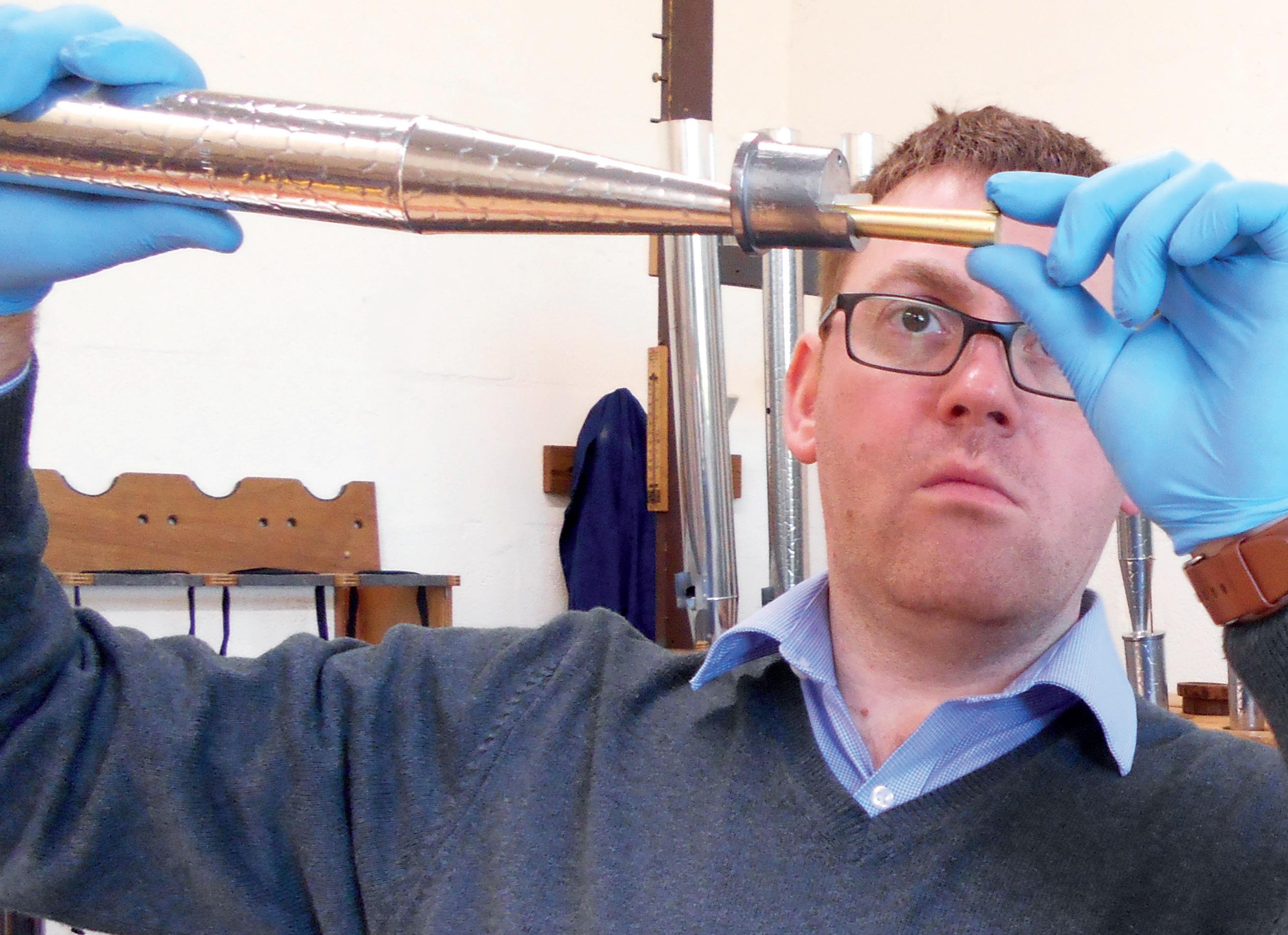
civic churches which perhaps have more financial resources with which to employ musicians.
A similar trait is perhaps also evident in organ-building. Many people active in the trade today initially took an interest through exposure to the instrument as choristers, or through having been pointed towards a career in organ-building by a schoolteacher who knew of a local company and the many different skills involved. Some came into the trade by following in the footsteps of their own family members (we have an organ-builder at Harrison & Harrison (H&H) who is the third generation of his family to work there). But whichever way people came into the trade past and present, general knowledge of the art of organ-building has undoubtedly diminished. A new or restored pipe organ is perhaps now considered to be an expensive luxury. Indeed, a pipe organ is to many an unknown instrument.
Gareth Malone, the charismatic TV choirmaster, has revolutionised the number of people who sing in secular choirs throughout the country. He – of course – is not alone in so doing, but the number of people who commit to singing in sacred church choirs does not increase, and thus exposure to the pipe organ also diminishes further. Today, people only really come into contact with ‘the king of instruments’ in their school chapel (if they are fortunate to have an organ

at school), or at weddings, funerals or town/concert halls. Exposure is perhaps most often through a holiday visit to a cathedral where the organist or choir may be practising, and this is not sufficient to draw someone towards wanting to learn to play the organ, or to find out how the instrument works, and then ultimately to discover that there is an exciting and varied career to be had.
I was introduced to the electronic organ at a young age by my father, who had a Hammond organ at home (he still has it), and on this I learnt. It was through learning to play the electronic organ in a wholly secular environment that an interest in music was generated which ultimately was the catalyst to my joining the local parish choir at the invitation of a school friend. I was already 12 by then, and therefore hugely late to the game as a chorister, but it was there that I was to find my love for the organ. This led quickly to a desire to understand instruments with pipes and wind, and to the discovery of a more classical repertoire. Shortly after joining the choir, the encouragement of the Director of Music and Newcastle diocesan organ adviser, Russell Missin (Organist of St Nicholas Cathedral, 1967-1987) began to rub off on me. I accompanied Russell to the H&H workshop for an open day in 1992 where I first met the Chairman and then Managing Director, Mark Venning, and decided then, at the age of 14, that a career in organ-building was what I wanted to pursue.
“In my eyes and ears the organ will ever be the king of instruments.”
Wolfgang Amadeus Mozart 1756-1791
I was never an academic, and the thought of further study after school was unappealing. Aged 15, I wanted to apply to H&H for an apprenticeship, but my parents insisted that I should first apply for a position with our local firm in Tynemouth – H&H being some 25 miles away in Durham. Only after something closer to home was not available was I allowed to write to H&H asking to be considered. At the time, this was a complete punt on my part as H&H were not actively looking for apprentices, but I got a favourable response to my letter and was interviewed on a cold January morning in 1994, in the old workshop in Hawthorn Terrace where, having done a written test, woodwork test and sit-down interview (scary stuff for a 15-year-old), I secured a four-year apprenticeship to begin straight after leaving school.
to highlight someone who may have a flair for a certain skill; having served their time as general apprentice, that person may then specialise within the larger team picture. As an organist, I was always very interested in tuning and voicing, but these two specialist aspects formed the last year of an apprenticeship, although I still thought it worthwhile to let my boss know that I was interested. Mark Venning had a word with then Head Voicer, Peter Hopps, and I was taken into the voicing room, where alongside continuing with all other aspects of my training on the bench I was fully immersed into the ‘dark art’ of tuning and voicing.
Training at H&H gives the apprentice a wide exposure to all aspects of the craft, such as woodwork, metalwork and leatherwork. This holistic approach allows for the development of good all-round knowledge, and it also helps


By the age of 18 I was being sent out to local tuning and maintenance visits, often taking another younger apprentice with me to hold notes. The frequency of local tuning gradually increased to covering tuning rounds while more established tuners were on holiday. An apprenticeship in organ-building is infinite but, having served my time, I became a qualified organ-builder in September 1998 and was offered a full-time job. As I had already spent a lot of time in the voicing room I made a very natural move to full-time voicing, where alongside workshop voicing I would find myself onsite, finishing jobs with Peter and Duncan, and also continuing to assist with tuning visits. After a few more years, at the age of 22, I moved to London to succeed David Chapman as London Tuner. For the next 12 years, around my tuning commitments, I continued to play an active role in the voicing team, and upon Peter Hopps’ retirement in 2012 I was appointed Head Voicer. I combined this with my role as London Tuner, but in order to give my full attention to the increasing voicing programme, after 16 years as London Tuner I handed over to a colleague who was running a smaller round in Bristol. He pretty much learnt on the job with no previous bench experience.
Back in the 1970s, around 5% of the workforce at H&H could play the organ. Today we have a much larger proportion of
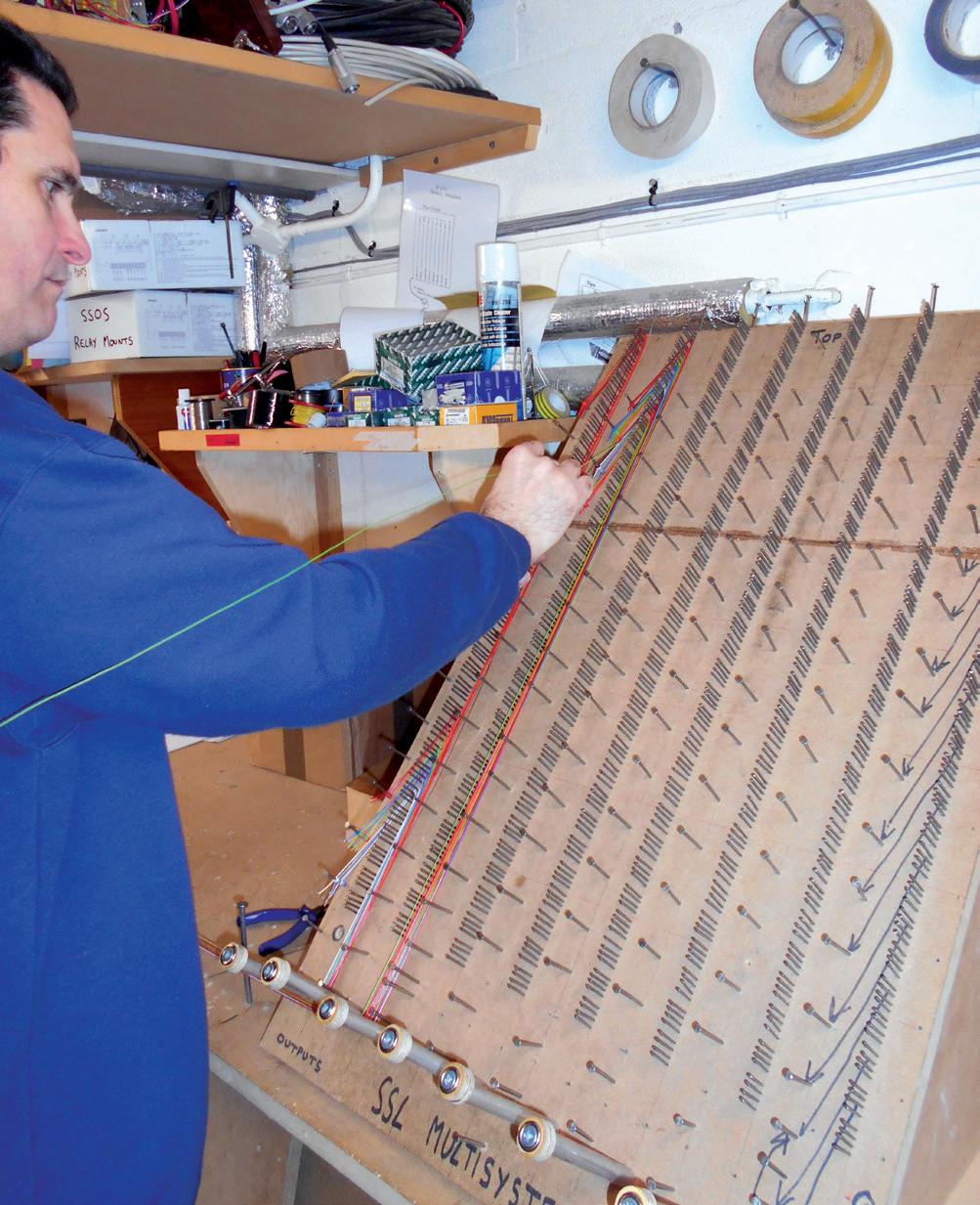
organists, including seven of our nine nationwide tuners, totalling 35% of the workforce. Although many people think that organ-builders are a dying breed, there are more opportunities for people to get involved than one might first think. Being a casual keyholder for a local tuner may lead to discovering someone who can tune, or work experience in a workshop can lead to a continuing interest. Organs are more than just pipes and wind: there are many elements and different skills which people bring together as a team to build an organ. These range from general woodworking and cabinet-making to leatherwork, metalwork, electrical systems, mechanics, design, tuning and voicing. For those who want to know more about what goes on ‘under the bonnet’, it is likely that your local organ-builder would be delighted to offer advice on where to find such opportunities if they are unable to offer them themselves.

The Institute of British Organ Building (IBO) publishes a fascinating annual journal, Organ Building, which features pipe organs built, rebuilt or restored throughout the year. It is an excellent, full-colour publication, where amongst articles on topics relating to the pipe organ there is an invaluable map and directory of accredited members and their contact details. Visit the IBO website for more details: www.ibo.co.uk
Having been an organ builder for 23 years, I can say with hand on heart that every day is different and you never stop learning. My job has taken me all around the world and given me access to many amazing places where I have met some fascinating people. I still have to pinch myself that amongst the many instruments I have been privileged to work on, to date I can include 26 UK cathedral organs, and 32 cathedral organs worldwide.
Andrew Scott joined H&H as an apprentice in 1994. In 2000 at the age of 22 he succeeded David Chapman as London Tuner. Andrew was appointed Head Voicer in April 2012, and since taking up the role he has been responsible for leading the voicing on many projects, including the Royal Festival Hall, Exeter Cathedral and King’s College Cambridge, alongside new organs for Edington Priory, Hakadal Kirke (Norway) and Bedford, St Andrew. He serves as a board member for the International Society of Organbuilders, and in addition to his work at H&H he is an accomplished organist and choir trainer, currently holding the posts of Director of Music at St Michael & All Angels, Croydon, and director of the chamber choir Amici Coro.
Parts of this article were first published in the quarterly newsletter of the Institute of British Organ Building (No.74, June 2014) and in Organists’ Review (June 2015) and are reproduced here with kind permission.

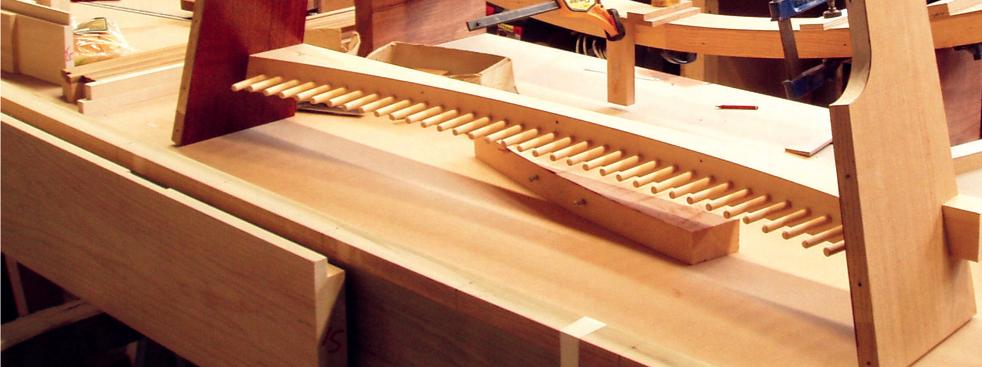

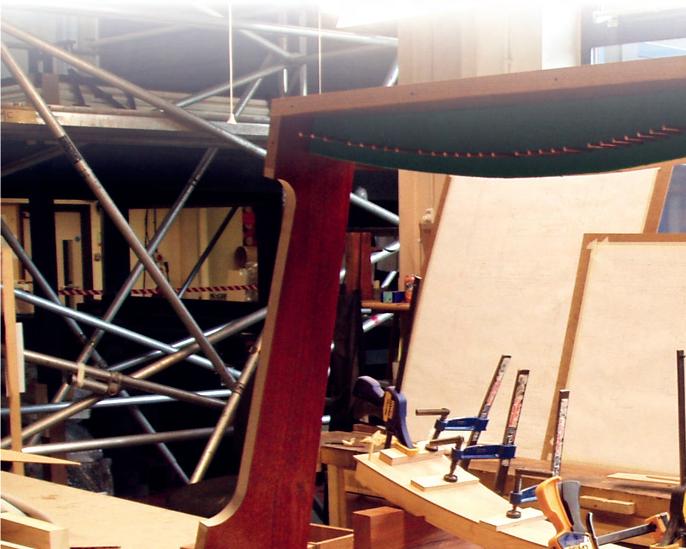
To borrow a description first applied to Charles James Blomfield, Bishop of London 1828-56, the Revd Ronald Sibthorp had ‘an ungovernable passion for business’ which might unkindly be characterised as a penchant for doing other people’s work. At Peterborough and Truro, the first two cathedrals at which FCM’s revered founder served as a minor canon, he was glad to obtain from the organist a complete list of the choir’s repertoire, and thereafter to take over from him the complete responsibility for choosing the music to be sung by the cathedral choir in the daily services. At Lichfield, his third and last minor canonry, he administered the Friends of the Cathedral, and in all three he ran the bookstall.
Sibthorp was a dedicated and single-minded lover of cathedral music and worship, and it was quite in character that in 1949 he should found an Association of Cathedral Minor Canons which he ran single-handed for well over a decade. It was this body which became alarmed by a (perceived) threat posed to cathedral choirs by the implementation of the 1944 Education Act which, it was feared, might restrict the amount of time choristers would have available for services and rehearsals. The real heart of the problem, however, seemed to lie not with the Act, but that it seemed to be no one’s business to
ensure that wartime reductions in the number of choral services were made good, and also that the new generation of deans and canons perhaps had not been brought up in a tradition that valued and enjoyed daily choral services. Most of the ‘parish church cathedrals’ had been content with at most a couple of weekday choral services and were not greatly affected, though Birmingham’s five weekday Evensongs had dwindled to only two.
The near-extinction of weekday choral Mattins was deplored, but it was sadly unrealistic to hope for the revival of the prewar conditions when this office was sung on at least a couple of weekdays in most ancient cathedrals. Exceptionally, at Lichfield and Wells it had been sung on every weekday, but in neither place did this provision survive the war. Only at St Paul’s was a daily morning service resumed, in the special circumstances of a large and fully professional choir with a school solely devoted to the needs of the choristers; and even then two of these ‘morning services’ had been replaced by a ‘hymn-sandwich’ at 12:30.
In any case, the days of the tiny choir school which took no pupils other than the cathedral choristers seemed to be numbered. At Ely and Worcester the boys could join the

as a minorPeterborough Cathedral Photo: Hans Davis Photography Truro Cathedral Photo: Brian Snelson Lichfield Cathedral Photo: Michael O’Donnell
King’s School as junior pupils, but at Durham, Lichfield and York the choir school eventually became a much-expanded preparatory school which included non-singing pupils as well as the choristers. Conversely, at Lincoln and Ripon new choir and preparatory schools were founded because an ancient grammar school was no longer willing or able to accommodate the special demands of the choristers’ routine. Other examples might be adduced, if only to illustrate the point that there was no typical solution to the problem of housing and educating a cathedral’s choristers. Another consideration was that cathedrals could no longer regard their adult singers as full-time employees and pay them to sing weekday morning services. The cathedral might find additional work for some in the chapter office or works department or choir school, but such sympathetic employers did not always exist. At Durham, where Mattins was sung on Tuesdays and Thursdays until the late 1960s, one of the lay clerks was a highly qualified engineer who had taken a menial job as a college handyman in order to be free to sing in the choir. Such enthusiasm and dedication were by no means uncommon.
As a response to these concerns, the Association of Minor Canons proposed that five of their number should join with
five each from the Cathedral Organists’ Conference, the Church Music Society and the Royal School of Church Music to form a committee of 20 that would act as a kind of OFSTED, visiting cathedrals to report on the state of the music and to take deans, canons and organists to task for any shortcomings that might be found. Unsurprisingly, the idea was dropped as being potentially embarrassing and probably ineffective. What cathedral music really needed was Friends, those who loved to worship at cathedral services, who could spread the word to those who did not know what they were missing and needed more information. If such Friends became sufficiently numerous they would constitute a body of opinion which could not be ignored if a cathedral’s music were to come under threat; but they could assume a positive role both by their presence at services and by their help with publicity and fundraising. So in 1956 the Friends of Cathedral Music came into being.
What is the purpose of a cathedral choir? It is to assist a cathedral’s clergy in their obligation to recite the whole psalter each month in more or less equal portions each day, both morning and evening; and to recite the canticles at Morning and Evening Prayer daily. Over the centuries a


distinctly Anglican repertoire of chant has evolved, and a rich treasure-house of music for the Morning Prayer (Mattins) canticles Te Deum, Benedicite, Benedictus and Jubilate, and for Magnificat and Nunc Dimittis at Evening Prayer (Evensong). The anthem is almost an optional extra, there being no proper texts provided in the Book of Common Prayer (BCP). A worshipper at Mattins or Evensong 60 years ago would have heard the complete introduction: ‘Dearly beloved brethren...’ in full, with the general confession and absolution perhaps intoned rather than spoken. The Preces and Responses would be sung to a home-grown setting, or perhaps ‘Tallis’s Festal’ or, on special occasions, Byrd, Smith or Tomkins. The creed would have been intoned, and in some places even the state prayers after the anthem. The organist would have been for the most part invisible, only emerging from his loft to conduct unaccompanied music, while the psalms, canticles and anthem were led by a skilfully played organ accompaniment. The assistant organist was someone who played on the organist’s day off.
There was a stable and immutable repertoire of anthems common to most cathedrals, though some favoured the Tudors and Stuarts and others the Georgians. The works of the best Victorians, such as Goss, Mendelssohn, Walmisley and S S Wesley, were universally sung, but Gounod and Stainer seemed to have had their day. The music of Bairstow, Stanford, Wood and their pupils was greatly admired and was sung everywhere. So settled was the repertoire that many establishments had thought it worthwhile to provide the congregation with a book containing the words of all the anthems in regular use, with a translation of Latin texts. A ‘Rolls-Royce’ of such books was compiled for King’s College Cambridge and subsequently adopted for Gloucester, Salisbury and York, with substantial additions to suit the particular requirements of those cathedrals. Novello’s Words of Anthems was rather more of a Morris Minor, but useful enough to be specially printed and bound for Lichfield Cathedral with a number of additional texts.
At many cathedrals a choral celebration of the Holy Communion was a relatively infrequent event, replacing or following Sunday Mattins once a month or on great festivals. It would have been sung complete by the choir, creed and all. The singing of Latin Masses was virtually unknown, but in a few places one might hear Byrd, Palestrina or Schubert in English by way of a change from Harwood, Stanford and Whitlock. A choral celebration on a saint’s day would take place in the morning, never (well, hardly ever) replacing Evensong.
FCM’s founder was a single-minded if perhaps uncritical enthusiast for his cause, and he longed to share his enthusiasm with others. But what was the quality of the product he was selling around 1956 and the subsequent ten years? Drs James Bowman, Harry Bramma and Francis Jackson have been generous in sharing their recollections, and the memoirs of Lionel Dakers, David Gedge, Frederic Hodgson, Michael Howard, Dennis Townhill and Arthur Wills may also be regarded as primary sources. Archive recordings of the choirs of Magdalen College Oxford, Salisbury Cathedral and York Minster have been reissued on CD in recent years, and an exciting reservoir of material is to be found on the internet. Type in, for example, Evensong, Worcester, Willcocks, and up will come someone’s recording of a radio broadcast. This is an actual example, and you will be rewarded by part of a 1955
Evensong in which the Worcester boys’ singing of The souls of the righteous (Nares) is most beautiful, just as one would expect from choristers trained by the legendary David Willcocks in the years immediately preceding his return to King’s. Harry Bramma confirmed that Worcester had some very talented choristers at this time.
In 1956 a number of cathedral organists had been in office since before the war; their attitudes and methods inevitably were of their generation, but with rare exceptions they were musicians of quality and dedication. Conrad Eden’s choristers at Durham were aware and proud of the skill in sight-reading which he imparted to them; and at Lichfield Ambrose Porter (soon to retire) was a noted trainer of boys’ voices and was famed for his accompaniment of the cathedral service; John Dykes Bower (St Paul’s) was immensely respected as a player and choirmaster. Heathcote Statham had been at Norwich since 1928; James Bowman, an Ely chorister, encountered the Norwich choir at joint Evensongs and was distinctly unimpressed; and a tale is told of a disastrous performance of a Byrd anthem at Lincoln, of which the organist (Gordon Slater) is said to have remarked to a visitor that he would ‘not often hear a performance like that’. The visitor felt compelled to agree! In a class of his own was the famously eccentric Guillaume Ormond, immortalised by A L Rowse as the Disorganist of Truro Cathedral.
The post-war generation included such luminaries as Sidney Campbell, (Ely, Southwark, Canterbury and Windsor), Douglas Guest (Salisbury, Worcester and Westminster Abbey), Francis Jackson (York), Alwyn Surplice (Bristol and Winchester), Stanley Vann (Peterborough), David Willcocks (Salisbury, Worcester and King’s) and Arthur Wills (Ely). Yet to come were John Birch (Chichester) and Christopher Dearnley (Salisbury and St Paul’s). And we should not forget
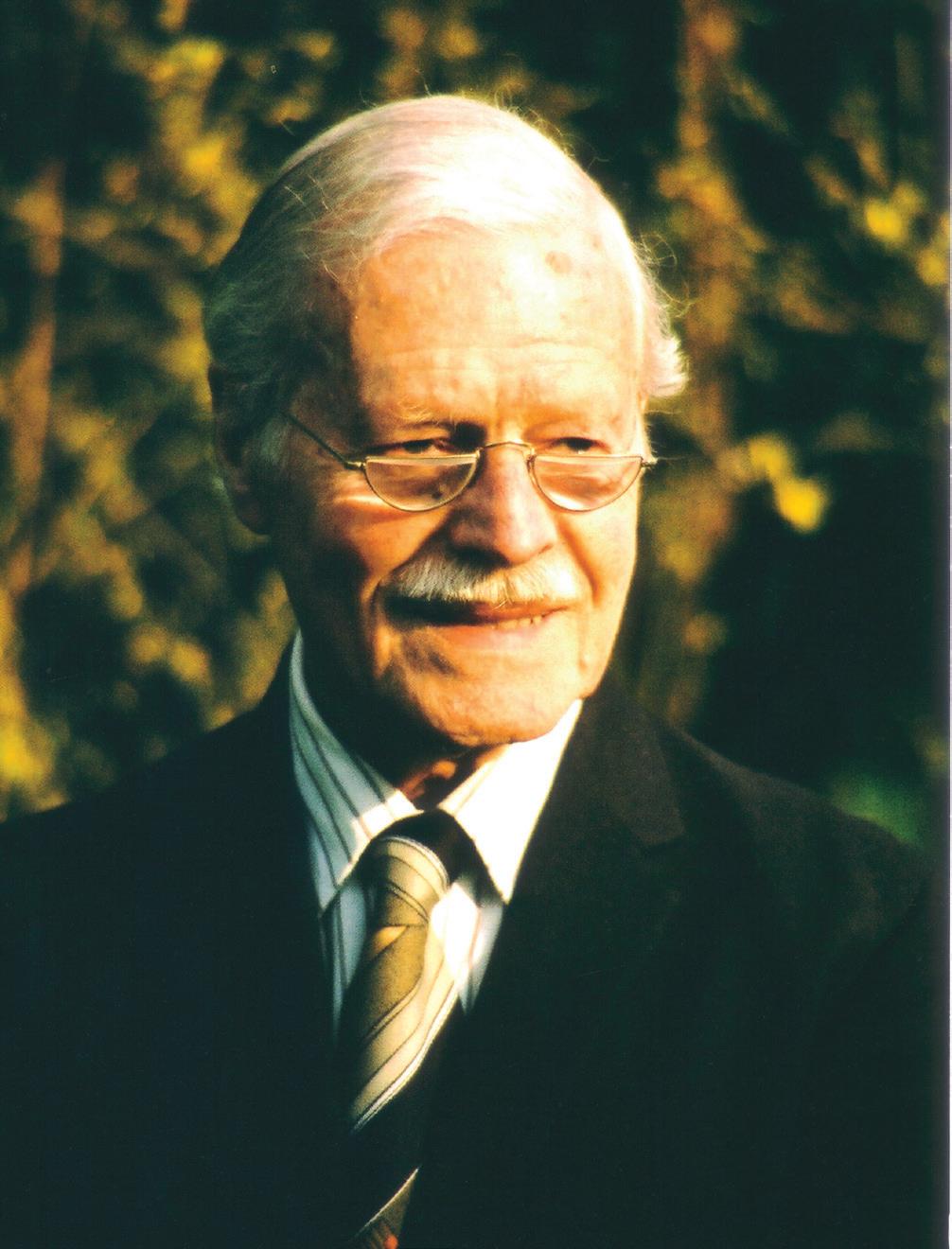
the organists of the Oxford and Cambridge colleges, George Guest, Meredith Davies, Boris Ord, Bernard Rose and others. For further recordings by many of the above, type in (say) Evensong King’s Ord; in this case you will be rewarded with a very fine performance of Howells’s St Paul’s Service, broadcast in 1956. You might try Evensong, Durham, Eden, or Evensong, New College, Davies, or Evensong, Wells, Pouncey; i.e. Evensong + place + organist. We are rightly proud of the standard attained by our best choirs nowadays, but there are lessons to be learned from these primitive old recordings. What is immediately obvious is that everywhere the boys were well trained to sing beautifully and freely, sometimes without absolute precision of ensemble but always confidently and clearly, with every word audible. Would that this were always true of today’s professional singers! The vowel sounds now seem somewhat dated, with the much-derided ‘megnify’, ‘end heth’, ‘hendmaiden’ etc. by no means unique to King’s! Francis Jackson used to make his boys practise saying, ‘That bad lad has had an accident’. The only examples of anything approaching ‘continental tone’ were provided by King’s (1956) and Ely; try Evensong, Ely, Howard 1958
Evensong, Salisbury, Guest shows what a good choir Douglas Guest bequeathed to his successor Christopher Dearnley, but we hear rather too much of an alto soloist who may have been good by the standards of the day but would hardly pass muster in even the least of today’s choirs.
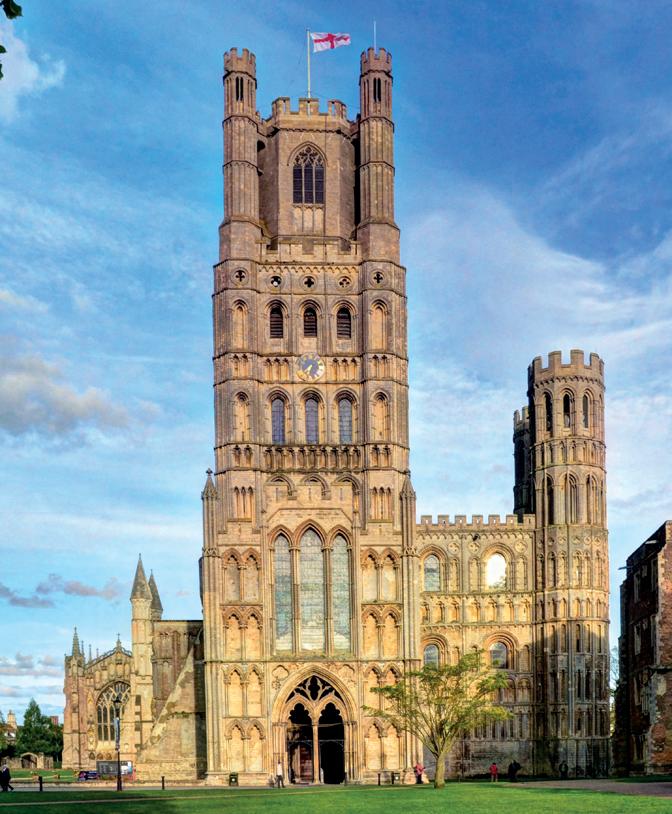
Some choirmen had grown very old but could not be forced to retire, having been appointed before the Cathedrals Measure of 1931 abolished freeholds for all singers who came thereafter. Freddy Hodgson’s delightful Choirs and Cloisters records that a number of his friends sang most beautifully into their eighties, as they were fully entitled. Freddy himself went on to a ripe old age at the Chapels Royal of St James’s and Hampton Court Palaces. A St Paul’s chorister recalls how ‘in 1962 I was … on Decani, positioned in front of three altos who seemed, to my young eyes and ears, to have already made it to the departure lounge but not quite to the gate!’ Evensong, St Paul’s, Dykes Bower is illuminating!
In a class of their own are the broadcasts from Peterborough, where Stanley Vann (Organist since 1953) raised an ordinary provincial choir to a standard fit to be compared with the best in the land. Even as a chorister, James Bowman thought that his own choir at Ely, good though it was, suffered in the comparison. In his words, ‘the secret was that Stanley persuaded the men to blend’. Unfortunately, it has to be admitted that only in the chapels of King’s and St John’s Colleges in Cambridge did the men sing as to the same standard as the boys. If you track down Evensong, Durham, 1960 you will hear a verse anthem by Wise in which the alto, tenor and bass soloists seem only concerned to outdo each other in volume. Evensong, Chichester, Birch 1965 proves that although the boys sang extremely well, it was taking John Birch some time to bring the men up to the same standard!
In some places, relations between organist and choir were less than harmonious. When Ambrose Porter arrived at Lichfield, the organist was also technically a lay vicar. He naturally assumed that as organist he would take the chair at a lay vicars’ meeting; but he was bluntly informed that he was the junior person present and had no right to do so. He had nothing more to do with them until he retired. One of the lay clerks at Durham, having no great opinion of Conrad Eden’s abilities, kept in his stall a notebook in which he recorded the organist’s every mistake. The atmosphere at Windsor was notoriously unpleasant. Not a few organists interpreted literally their title of Organist and Master of the Choristers, with no specific obligation to rehearse the men, whom they regarded as a necessary evil about whom nothing much could be done. In any case, there was often only one rehearsal of the full choir each week, and it is a tribute to the thorough training of the boys, and the professionalism of the men, that in most cathedrals the services were decently, even well, sung. The old ways persisted until the 1960s and beyond, but a new generation of organists, many of them formerly organ scholars in the ancient universities, was now applying a rigorous training to the whole choir, not just the boys. A leaflet issued in 1966 by the Church Music Society reveals that this was something of a Golden Age for cathedral and collegiate choirs, with Evensong on at least five weekdays in the ancient cathedrals, and even a few weekday Mattinses. It warns that ‘at some cathedrals, services are not sung during August’, for it was still quite usual for the choir to remain in residence for a number of days after Christmas and Easter, the men perhaps singing on their own for a few more days. Look for Evensong, Durham, Eden 1965, a live broadcast on 29 December, no less!
FCM’s founder built better than he knew. In 1956 and the following decade, or even 20 years later, the world of cathedral music was in better shape than he had feared, but by the 1980s the Friends were growing into a body powerful and wealthy enough to help the nation’s choirs face a whole host of new challenges, social, ecclesiastical and financial. Not that one was ungrateful for the more modest help of the Friends’ earlier days. In the writer’s years at Birmingham Cathedral (1979-84) the copies of Purcell in G minor, skilfully bound into cardboard covers by Sibthorp’s own fair hand, were a tangible reminder of the Friends’ existence and generosity. Long may it continue.




With his late-Romantic, bombastic sound, Gustav Mahler is a composer known for his ability to write for huge instrumental forces. He’s also known for being uniquely able to build those forces up to key musical moments, shape a denouement that is never sudden, and allow a contemplation that washes over listeners in an often profound manner. But the Herculean efforts required for most Mahlerian symphonies have made it next to impossible to imagine an effective staging of the symphonies in intimate venues or anything less than a grand hall. What instrument and single player could possibly invoke and create the effect of a massive orchestra?
of reproduction was fairly rudimentary. The playing of orchestral transcriptions in organ concerts therefore gave the general public virtually their only regular opportunity to experience the great orchestral and operatic repertoire, firsthand.

Because I have always been rather obsessed by the great corpus of orchestral music from the 19th and 20th centuries, it has been refreshing to observe the pendulum swinging more towards the mid-point in terms of programming for organ concerts and recordings over the last three decades or so. At the beginning of the 20th century it was not difficult to find recital programmes consisting almost entirely of orchestral transcriptions. Players such as E H Lemare and W T Best brought great skill and integrity to the playing of this repertoire and, in that very different sociological era, audiences were often huge. At the Alexandra Palace in the 1930s so many people came to recitals by Harry Goss Custard that he was obliged to have two sessions every Sunday afternoon. The choice of repertoire was, of course, also related to the evolution of the recording industry. 78 rpm records were the order of the day – and inevitably the quality
In the 1950s and 1960s, the Organ Reform Movement (which sought to recapture the baroque instrument over the then current trend for ‘Romantic’ organs) arrived and the playing of transcriptions and arrangements went completely out of fashion. The rationale suddenly became centred on historic performance practice and trends in organ-building mirrored the movement (although this could have been the other way round!). Audiences could expect to hear a very different type of recital – invariably Bach, a plentiful supply of early repertoire and then, bypassing the 19th century, works by Messiaen or one of his contemporaries. There was a definite tendency towards specialisation, and as a result members of the general public, who were often entirely unfamiliar with this repertoire, became perplexed and to some extent ostracised.
The current trend towards recapturing both the enthusiasm and the size of the audience is very refreshing. There is no doubt that organists have benefited from the increased breadth of historical knowledge inherited from the reform movement in terms of touch, fingering, articulation and rhetoric, but now there is an increasing realisation amongst many players that the crucial thing is not to play for oneself but, principally, for the enjoyment of others. Louis Vierne at Notre-Dame, in describing his attitude towards performance, said: ‘Il faut rigoler les gens’ [You must entertain people].
Of course, the idea of presenting music in transcription is a very old one – indeed, transcriptions have been made throughout musical history. J S Bach frequently made arrangements of both his own and other composers’ music, crossing instrumental boundaries. The 1746 Schübler chorales and the arrangements of the Vivaldi concertos are obvious cases in point. Bach’s frequent use of the word Klavier in his keyboard music implies that his attitude towards specific keyboard instruments was quite liberal – the music was made to be played on whatever instrument was to hand. There is no doubt that really great music speaks for itself and can be effective in different guises. Many other great composers have also made transcriptions of their own music (e.g. Ravel’s La Valse, and The Rite of Spring by Stravinsky, which exist in piano duet form). Liszt made transcriptions of Beethoven’s symphonies for piano solo and Maurice Ravel famously orchestrated Mussorgsky’s Pictures at an Exhibition, a work that was originally written for piano. Having said that, of course, a transcription is by its very nature something of an illusion and must be made to sound effective in its new guise. A poor transcription, or a good transcription badly played, can easily turn into a travesty of the original. However, a good transcription, interpreted well, can heighten our awareness of the message behind the music – we can listen with new ears. A new artistic dimension is given to the original. Perhaps it’s rather like seeing a painting in a new frame in a different gallery and under different lighting conditions. It is basically the same concept but the variation in approach can affect the observer in an entirely different way.

Over the past couple of decades, a number of very largescale organ transcriptions have been made and recorded. At the reopening of the organ in Notre-Dame de Paris, Olivier Latry played his brilliant transcription of Stravinsky’s Rite of Spring. Lionel Rogg has transcribed and recorded Anton Bruckner’s Symphony No. 8 on the new Van den Heuvel organ at Victoria Hall, Geneva. Pierre Pincemaille has made staggering arrangements of two other Stravinsky ballet scores, The Firebird and Petroushka and recorded them on the Gonzalez/Dargassies organ of Radio France in Paris. My own transcription and recording (for Priory in 1997) of Mahler’s Symphony No. 5 became Priory’s best-selling organ disc, emphasising that transcriptions are very much coming
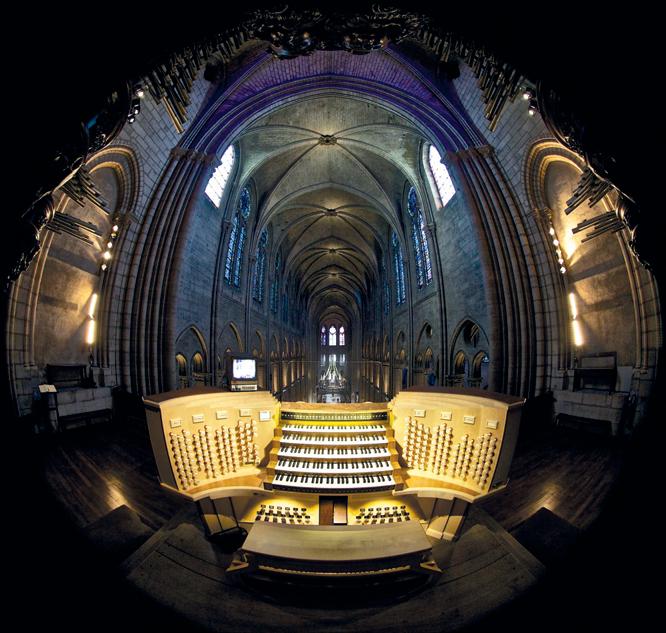
back into fashion. Interestingly, none of the above composers left any original music for organ. Neither, sadly, did Debussy, Ravel, Bartok, Prokofiev or Rachmaninov. Maybe this is due to the technological evolution of the instrument. Today’s computerised control of registration offers the player much more possibility for rapid changes of colour, timbre and dynamic. Is it not likely that to Debussy, for whom colour was paramount, the instruments of the time seemed somewhat intractable?
Transcribing major orchestral works like Mahler symphonies is an extremely stimulating, if somewhat lengthy, experience. Because the organ is rather like a self-contained orchestra, the transcription could be, at best, rather like presenting an object in an entirely new light. I have been very much in love with Mahler No. 5 since playing it as a 15-year-old violist in the National Youth Orchestra under Sir Charles Groves. Inevitably, in making an arrangement for organ, one is obliged to make many choices – principally for those passages where there is simply so much going on in the orchestra that it is impossible to play it all with two hands and two feet. Working out exactly what is essential and what can remain ‘implied’ is a delicate procedure. In some ways, streamlining the orchestral texture doesn’t necessarily mean impoverishment of the musical content. The advantage of inputting the transcription directly into the excellent ‘Sibelius 7’ software is that it is possible to make modifications very easily after trying the music out on an organ, (in this case, the organ of Gloucester Cathedral
huge Mahlerian climaxes have an even more awesome quality. Since then I have also transcribed and recorded Mahler’s Sixth, Second, Eighth and Fourth symphonies.
where I was Director of Music from 1994-2002). These changes were generally registrational but sometimes involved structural reorganisation of counterpoint, including making octave transpositions etc. in order to make the music lie more comfortably under the fingers. Very many passages were completely reworked until the final result became convincing as an organ piece. If the transcription is too complicated, too difficult, the musical content will suffer anyway because the performance will sound awkward. That means that it is important to reach a clear and natural transcription of as many passages as possible. Registrational integrity and smoothness is essential in this symphonic repertoire. When I recorded Mahler Five I made extensive use of registrational ‘camouflage’ in order to try and cover up the stop changes. The generous Gloucester Cathedral acoustic helped, too! The transcription I made does not attempt to be a slavish imitation of the original Mahler orchestration, rather more of an adaptation. My aim was to give the organ the sonic character of a large orchestra. The organ, moreover, has a unique ability to sustain, particularly fortissimo, and thus the
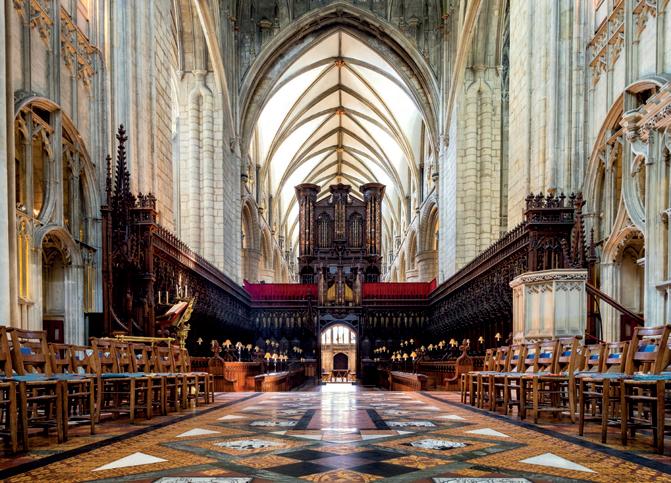
Several important ingredients go into both the making and the performance of successful organ transcriptions. I always start from the full orchestral score and not a piano reduction. It’s perhaps surprising that, with Mahler’s symphonies, it’s not necessary to reduce too much, or to leave too much out. If you look at the sketches, things are often quite clear (and written for piano over three staves). The magic with Mahler comes, of course, from the subtlety of the orchestral colour, but with modern organ console technology and a degree of imagination it’s possible to replicate (or more accurately translate) this in a new medium. It’s important, too, not to make the transcription unplayable. I tend to find ways, through octave transpositions, reorganising of the voicing of the harmony, and so on, to make the music lie well under the hands and both feet.
Processing each note is a very time-consuming (and rather therapeutic) exercise – each bar requires a large amount of thought and this is a perfect way to get to know a score very intimately. The organist, of course, has four main advantages over the pianist, when it comes to performing orchestral transcriptions: a) the ability to incorporate either single or double pedal parts; b) more expressive potential through registrational colour and swell boxes; c) more possibility for sustaining intense orchestral crescendos; and d) very often performing in great cathedrals, where the acoustic and aesthetic ambience can add so much to the emotional impact of this music. Playing the last movement of Mahler Three at York Minster a while back, the effect of that matchless building on the music was breathtaking.
In making the transcriptions, I’m quite disciplined about including the composers’ original intentions for phrasing, articulations, and dynamic parameters. More than that, though, I leave to the integrity and free will of the performer. From the performance point of view, I always endeavour to adopt a registration scheme that has as much colour and vivacity as the orchestra, but not necessarily the same explicit colours. There are certain instruments we just don’t have, but I think with care it’s possible to create registrations that have the same emotional ambience, clarity, and contrast. One should try to imagine what Mahler would say if he were looking over your shoulder as you played.
My profound hope is that people will enjoy playing and hearing these re-castings of Mahler’s originals. This is highly
Processing each note is a very time-consuming (and rather therapeutic) exercise – each bar requires a large amount of thought and this is a perfect way to get to know a score very intimately.The quire and organ of Gloucester Cathedral
charged, emotional music that shows Mahler’s complete genius for creating a completely original soundscape, one which is instantly recognisable and completely inimitable –but still translatable.
The CDs of David’s transcriptions of Mahler’s Symphony No. 2 and Symphony No. 8 are available from www.david-briggs.org


David Briggs obtained his FRCO (Fellow of the Royal College of Organists) diploma at the age of 17, winning all the prizes and the Silver Medal of the Worshipful Company of Musicians. From 1981-84 he was Organ Scholar at King’s College Cambridge, during which time he studied organ with Jean Langlais in Paris. The first British winner of the Tournemire Prize at the St Albans International Improvisation Competition, he also won the first prize in the International Improvisation Competition at Paisley. Subsequently David held positions at Hereford, Truro and Gloucester Cathedrals. He is currently Artist-inResidence at St James Cathedral, Toronto.
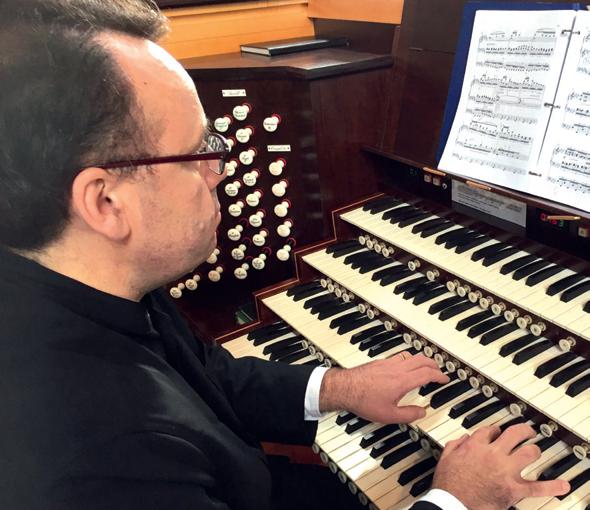


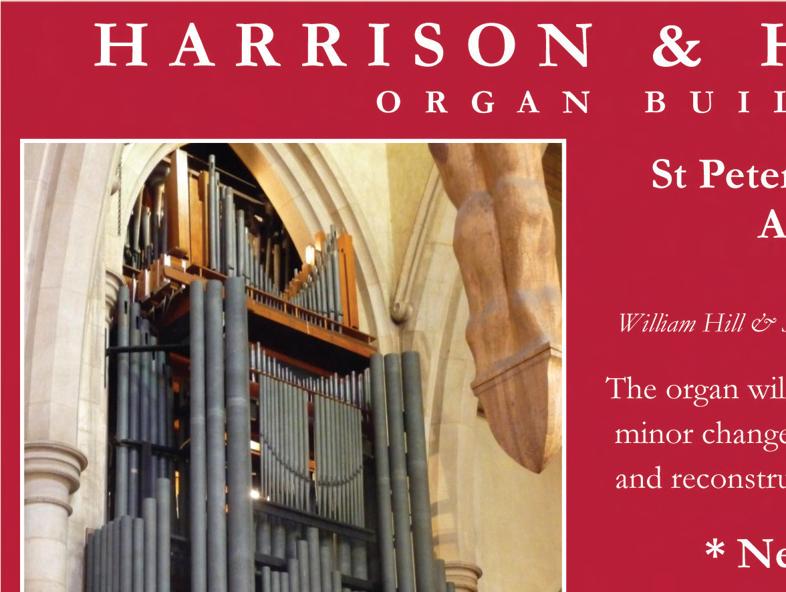
St Asaph is the smallest medieval cathedral in the UK, located in one of the six dioceses of the Church in Wales. More than 200 Anglican churches make up the family of the diocese of St Asaph – Teulu Asaph – which covers a large area of the North Wales coast, meeting the diocese of Bangor to the west, Chester and Hereford to the east and reaching south to mid-Wales and the diocese of Swansea and Brecon.
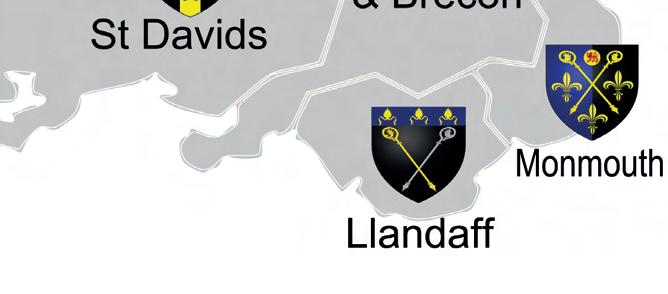

Saint Kentigern built his church here in AD560, returning to Strathclyde in AD573, leaving Asaph as his successor. Since that time the cathedral and diocese have been thus dedicated. With a population of around 3400, it was an honour for St Asaph to be awarded city status as part of the Queen’s Diamond Jubilee celebrations in 2012. The present cathedral building, begun in the 13th century, is home to the William Morgan bible and has record of a cathedral choir as far back as the late 13th century. The roll call of organists begins in 1620 and for those who like a statistic or two, the current Bishop of St Asaph is the 76th Bishop, while I am the 26th cathedral organist. I have been based in Wales since 1999, serving first as Assistant Organist for five years and as Organist and Director of Music from 2004.


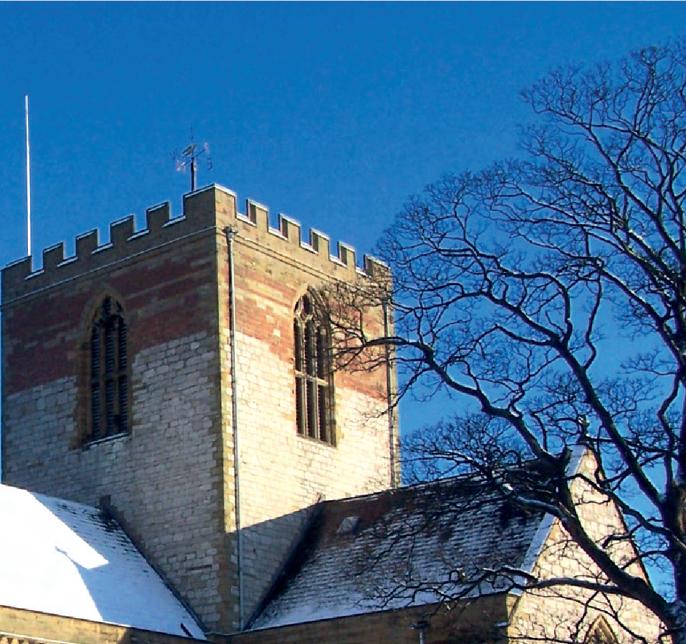
My time at St Asaph has been varied and creative, not least because I have striven to sustain and develop our musical
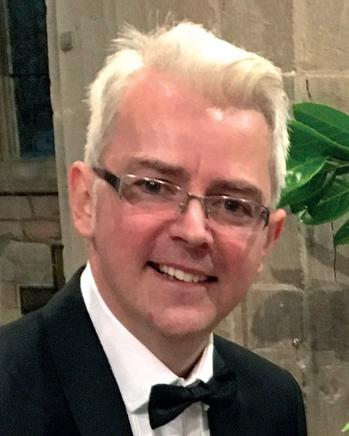
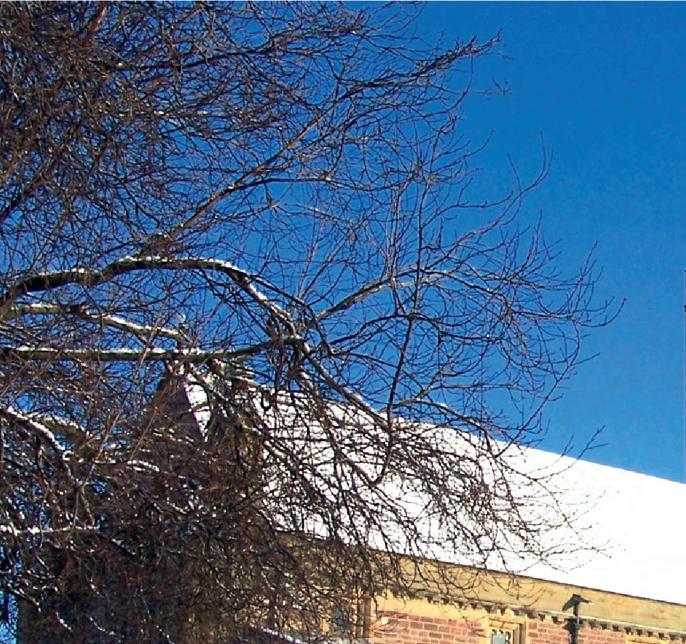
offering in what has been and continues to be a challenging time for the wider church. When I first arrived here as a parttime assistant organist, fresh from an organ scholarship at Liverpool’s iconic Metropolitan Cathedral, there was a choir of boys and men and the cathedral’s 4-manual Hill organ had just undergone a £250,000 major rebuild by David Wood of Huddersfield.
The dean and chapter at that time were bold in their keenness to offer the same musical opportunity to girls and so, as Assistant Organist, it fell to me to establish a cathedral girls’ choir. It has been fulfilling to see this project evolve and flourish over successive years, not least when one of our girls, who has subsequently returned recently to sing regularly as an alto lay clerk, reached the 2008 finals stage of BBC Radio 2’s Young Chorister of the Year held at St Paul’s.
I’m sure that I’m not alone among my fellows in saying that the most affirming part of being Director of Music is to witness the many talented boy and girl choristers achieve so much during their time in the choir stalls, seeing them grow musically and spiritually as individuals. In April 2016 one of our girl choristers, Hannah, thoroughly enjoyed her time representing St Asaph as part of the Diamond Choir in concert at St Paul’s and also taking part in the 2017 Decca recording.
Many of our choristers have gone on to further studies at university, achieving places on music degree courses at the Royal Academy of Music, Royal Northern College of Music and Royal Welsh College of Music and Drama.
I am often asked, “What have been the musical highlights experienced in your time at St Asaph so far?” and of course there have been many. Surprisingly, these high points can be often be when you least expect them, during a weekday Evensong in the depths of winter with a small congregation, for example, when they can occur quite spontaneously. These distinctive glimpses truly affirm the words of St Augustine: “Those who sing pray twice”, and encourage a renewed freshness in our roles.
My job description as Director of Music is broad, but in real terms I have always viewed it as ‘enabler and encourager’. To see our cathedral choirs involved in commercial CD recording ventures, live and recorded broadcasts for BBC national radio, as well as appearing in two televised broadcasts for BBC TV’s Songs of Praise from St Asaph, has been a real cause for celebration. Whilst helping the choir to reach a broader listening base, these occasions have applauded the gifts of our musicians and have been exciting, unforgettable experiences for each of our singers.
Reaching a wider community, whilst retaining a positive choir profile, has been vital for our continual recruitment of singers. It has been wonderful to see the choir relish concert opportunities to appear with The King’s Singers as part of the North Wales International Music Festival, with Russell Watson as part of his Candlelight Cathedral Tour, and recently with Aled Jones as part of his UK tour.
The composer Sibelius (1865-1957) stated simply that, ‘Music begins where the possibilities of language end’. No better phrase sums up so perfectly why music has been such an influence in helping people to worship, or clarifies this
essential need to continue in our music-making, despite the difficult and ever-prevalent challenges of finance and recruitment – worship is rightly so at the heart of our cathedral choir’s mission here.
We have two separate groups of boy and girl choristers who are drawn from all over the North Wales area, not just St Asaph itself: our youngest is seven and our eldest is 14. Tuition in reading musical notation and vocal production is built into our weekly training schedule, this latter being tailored to the progress of each individual child, and our repertoire ranges widely from Gregorian chant to music written by contemporary composers.
St Asaph’s doesn’t have its own choir school, which means that our choristers currently attend 11 different schools. Because of this geographical spread we are heavily reliant on our chorister parents to organise lift-sharing, and to battle the traffic on the A55 ‘expressway’ (what a misnomer...). As I’m sure is the case in many other music departments countrywide, it is their generous goodwill which enables us to continue.

It’s important for the choirs to have some well-earned downtime and to socialise, and we are lucky to have an active cathedral choir association which organises events for the choirs and their families and helps to raise valuable funds throughout the year to support our growth and development. It has generously funded the cost of many essential items including CD recordings and musical scores, purchase of choir robes, cloaks and polo shirts, and a piano for the song school.
This year we are celebrating 40 years since the formation of the association, so to mark this milestone we have commissioned a new Christmas carol for the cathedral choir, composed by Will Todd and to be premiered in December 2017.
We now have a well-equipped song school building which has recently undergone a £25,000 restoration, with new systems to replace the aged heating and lighting. The choir itself was pro-active in helping to raise these funds, which have made a significant improvement to our rehearsal and meeting facilities, administrative and robing areas, and the building is home to our music library.
As cathedral Organist, another question I’m often asked is, “How and when did you start to play the organ?” Undoubtedly, my principal early exposure to the sound of the instrument and subsequently my desire to learn to play it were from influences at school. The Liverpool Blue Coat School was fortunate in having two versatile pipe organs; each morning the Head would invite all students to sit for the organ voluntary. This daily time to remain quiet and hear some great playing, and a variety of colour, dramatic styles and textures, all had a huge influence on my musical development, as did the access to the great teaching staff there (in 2016 the school was ranked as the best school in the country based on its GCSE results).
cathedral choirs to parishes within the Teulu Asaph – some 30 visits to date, and we continue to promote our annual Evening Organ Recital series, which has attracted players and listeners from both the UK and abroad.
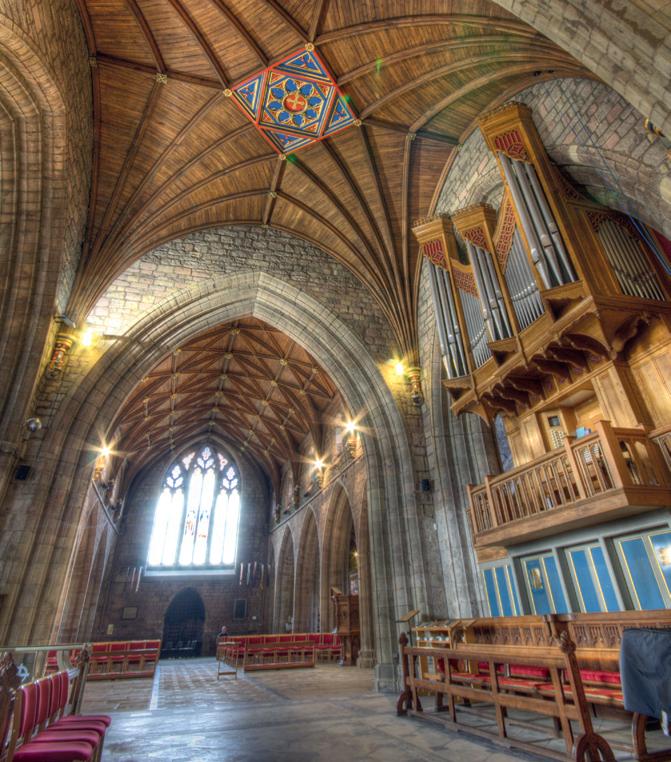
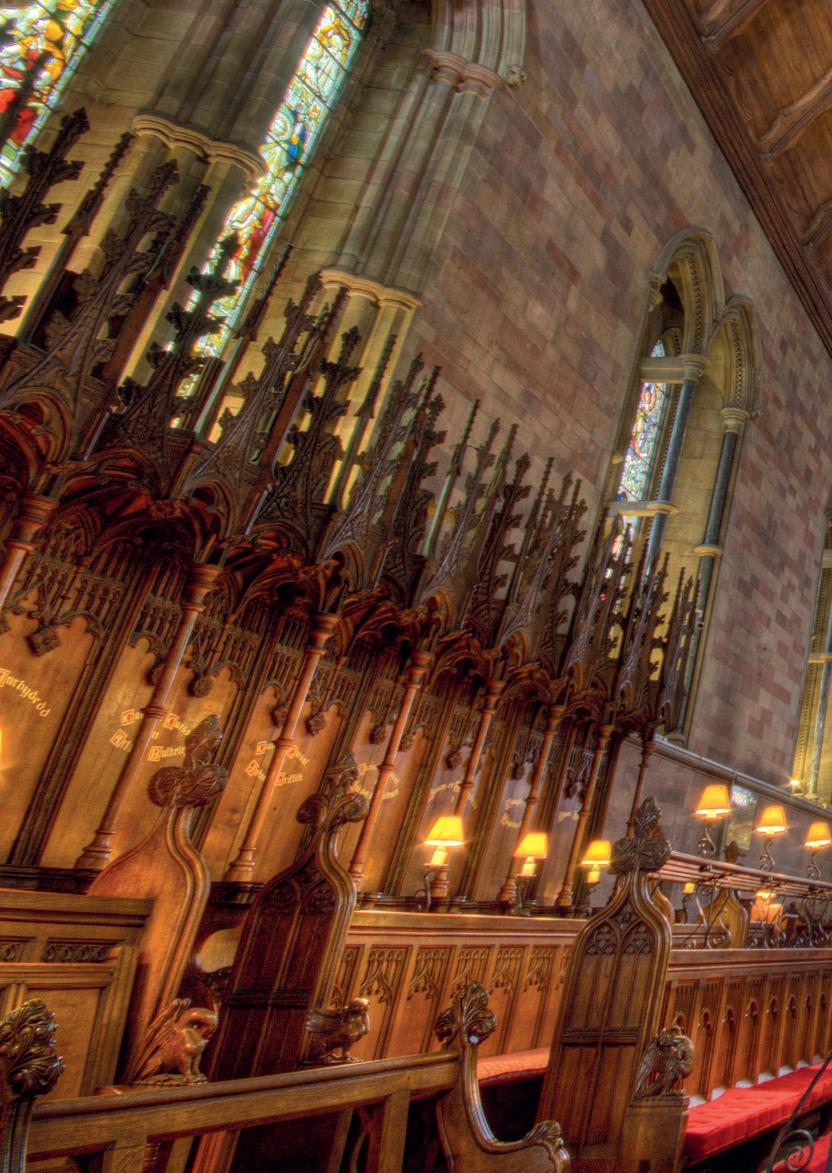
I’m certain that strong musical partnerships are vital to the outreach of church music and to secure growth for the future. During my time here I have always been keen to work collaboratively with other organisations, whether directing the cathedral choir at the inauguration and installation of the First Chancellor of Glynd r University, training choristers for the Mid-Wales Opera Company’s performance of Britten’s Noyes Fludde or a continuing involvement in the work of the RSCM.
Having then gone on to the RNCM to study organ, and receiving tremendous opportunities to learn from the teachers and performers there which went hand in hand with that, I have some concerns that in many places a lack of exposure to the organ must be detrimental in inspiring and securing future players. This point could easily also be made in respect of today’s young singers being exposed to the sound of our choirs; however, we should feel encouraged by the words of St David, who told his monks to ‘do the little things’ when attempts are made by us to redress the balance.
Our St Asaph response to St David’s words has included devising and delivering organ workshops for visiting Key Stage 2 and 3 pupils, in partnership with the cathedral’s School Visits Service, as well as co-ordinating regular visits of the
As I am chairman of the RSCM North Wales Area, I have many special memories of planning and directing all-age practical workshops and choral festivals, and also of serving as an examiner. In North Wales we have been able to welcome many very experienced musicians to direct events, such as Bob Chilcott, Mervyn Cousins, Andrew Reid, Barry Rose, John Rutter and Paul Leddington Wright.
Throughout my career I have been fortunate in having received a solid musical training. In September 2011, I became an Associate Lecturer at Canterbury Christ Church University and was able to share my skills as mentor. I taught both as part of the university’s BMus (Hons) degree course in Church Music studies and the joint RSCM foundation degree in Church Music studies. This involved maintaining regular contact with assigned students, visiting and assessing them in their placement parishes, preparing individuals for practical
Over the years we have received £24,500 in grants from the FCM, 1992 – £2,500, 1999 – £7,000, and 2009 – £15,000, all of which have been put to very good use.
performance at the residential schools and helping students with their selection of relevant repertoire choices and research study materials. All of this focused on excellence in choral directing, composition, organ performance, improvising, liturgy content and advanced performance skills.

It has been a great delight to be Diocesan Representative of FCM, helping to promote and support the essential national work of FCM within the St Asaph diocese, and to have been able to host a National Gathering of the organisation here in 2007. Over the years we have received £24,500 in grants from the FCM, 1992 – £2,500, 1999 – £7,000, and 2009 – £15,000, all of which have been put to very good use.
Being a chorister is a tremendous musical opportunity for a young singer, proven to assist in all-round educational development. The confidence that choristers gain through their committed service and through being part of a team who regularly perform together is well documented, and each will take pleasure in their friends’ successes.
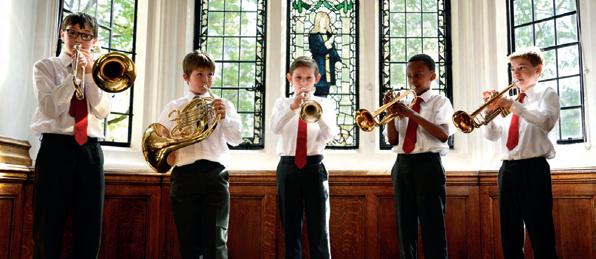
In terms of my own service, I still have some way to go to match St Asaph’s longest-serving cathedral organist, Dr Harold Stocks. My mere 13 years at the console cannot match his healthy 39 years in post until his retirement in 1956, but the challenge of nurturing a creative environment to enable a weekly round of meaningful worship to continue offers a constantly renewing daily focus which I value enormously.
At St Asaph I have been very blessed.

choir training. At age ten, 12 of us were shortlisted for a trial and three of us were successful and joined the probationers. Dieter Pevsner, son of Professor Nikolaus Pevsner, Andrew Martindale and myself. As probationers we were placed next to senior choristers to learn the ropes. Among these experienced persons were Christopher Reason, later a notable bassoonist and organist, Professor of Harmony and Aural Training and finally Dean of the Royal Academy of Music, and Michael Mitchell, who was later a viola player with the LSO.
How fortunate we were to have such a wonderful director of music in Dr (later Sir Thomas) Armstrong, whose interest in us continued long after we left the choir. He had a profound influence on all of us. For a while Gavin Brown was his assistant (an ex-head chorister). He was later organist at Brighton Parish Church when my father was vicar of Brighton just after the war. He subsequently joined the staff at the Royal Academy. Allan Wicks was the organ scholar and later became Organist and Master of the Choristers at Canterbury after distinguished service at other cathedrals. One thing I will always remember about him was his ability as a jazz pianist!
At the outset of WWII my father, who had served as an infantry officer on the Somme on WWI, was recalled – this time as a chaplain – and sent to France. I was then seven and a half years old. My parents decided to send me away from London to Christ Church Cathedral Choir School in Oxford. It was a wise decision as our house was flattened during the Blitz. Needless to say, I was the youngest boy in the school, but I took to life there like a duck to water. It was quite clear that it would be a year or two before I would be given a trial to join the choristers, and there was no guarantee that I would be successful in gaining a place. However, we were all taught a musical instrument, the violin in my case, and given
At the end of WWII Ivor Keys returned briefly as Assistant Organist. He was, in the 18th-century sense of the term, a complete musician, and had been a child prodigy. In his early teens, while a pupil at Christ’s Hospital, Horsham, he played the solo part in Rachmaninov’s Piano Concerto No. 2, and he became the youngest ever Fellow of the Royal College of Organists. A period at the Royal College of Music was followed by his appointment to Christ Church, before he became Professor of Music at Queen’s College, Belfast, and then took the same post at Nottingham and Birmingham Universities.
The war took its toll as far as the men of the choir were concerned. Only two of them were not called up for military service, namely George Thewlis (bass), who ran the Oxford Choral Society and Orchestra, and Ted Manning (tenor), who was Principal of Music at St Edward’s School, Oxford. However, the choir was augmented by some able amateurs from the local population and occasionally we borrowed men from New College and Magdalen. There were also some exchorister undergraduates who joined us. Altos were always in
short supply. An elderly Mr Wheatley was helped by two of the older choristers. Thomas Armstrong himself sometimes joined the tenors. He never conducted the choir from the choir stalls unless the music was unaccompanied. We kept time thanks to the basses on each side surreptitiously beating with their index fingers on the top of the music stands.
aircraft would fly over Oxford and the sirens would sound out. Night after night our headmaster, the Revd Wilfred Oldacre, (who was also the precentor) would marshal the school and march us to Campion Hall next door. There was a large basement there, the windows of which were reinforced by sandbags. Our night-time trips happened frequently and it often seemed to be raining when we moved across. It was also uncomfortable trying, often unsuccessfully, to sleep. Needless to say, our usual routine of morning choir practice followed by lessons, games, choir practice before Evensong, and then prep was still followed. In those days we also had three services on Sundays mornings. Mattins, which was always popular with the undergraduates, particularly when Canon Jenkins was preaching as he made them laugh, followed by the Litany and Sung Eucharist, and in the afternoon there was Evensong. We had Thursday off, and it was boys-only on Wednesdays.
At Christmas and Easter those who were not choristers returned home whilst the choristers stayed behind to sing the most beautiful music, particularly during Holy Week. It was no hardship as we were lavishly spoilt with parties at the deanery, in the canons’ houses and by Thomas Armstrong and his wife during the day. The highlight was a visit to the pantomime.
Every year we joined forces with the New College and Magdalen choirs for the Three Choirs Festival in the Sheldonian Theatre.
It was a strange time to be a chorister. We were ever mindful of the war. When Coventry and the Midlands were blitzed, every
In 1942 we returned from our summer holidays to find that an air-raid shelter had been built for the school in the next-door garden, which also belonged to Christ Church. It had bunks, and was very spidery! However, it did have a covered walkway connecting it to the school which was a great improvement on our damp trips to Campion Hall.
I had a letter from Christopher Regan, another chorister, shortly before he died and was very touched by it. He told me how he and the other choristers were very worried about my father at the time of Dunkirk, and how relieved they were when the headmaster woke me up in the night to tell me my mother had rung to say he was safely home. Similarly, they were concerned when they heard he was involved with the D-Day landings. No doubt several of their fathers were also away at the war but we rarely, if ever, spoke about it.

Today as a server and communion assistant at Truro Cathedral I am extremely fortunate to be able to hear glorious singing by what must be one of the finest cathedral choirs in this country.Christ Church Cathedral School Photo: David Hallett
1945 saw the choir returning to normal as the men came back from the war. Kenneth Tudor (bass) had joined us from York Minster in about 1943, and he moved to Westminster Abbey when his counterpart returned. As one would expect, the standard of singing improved. By then I was head chorister. I was succeeded in this office by John Harper, who was subsequently appointed Principal Bassoonist of the LSO in 1955. In the late 1960s he emigrated to Australia and was a member and manager of the Australian Chamber Orchestra. He also broadcast talks on music.
Despite the trials and tribulations, those times were undoubtedly amongst the happiest days of my life. Wonderful music, under the most wonderful man, in beautiful surroundings.
Today as a server and communion assistant at Truro Cathedral I am extremely fortunate to be able to hear glorious singing by what must be one of the finest cathedral choirs in this country.
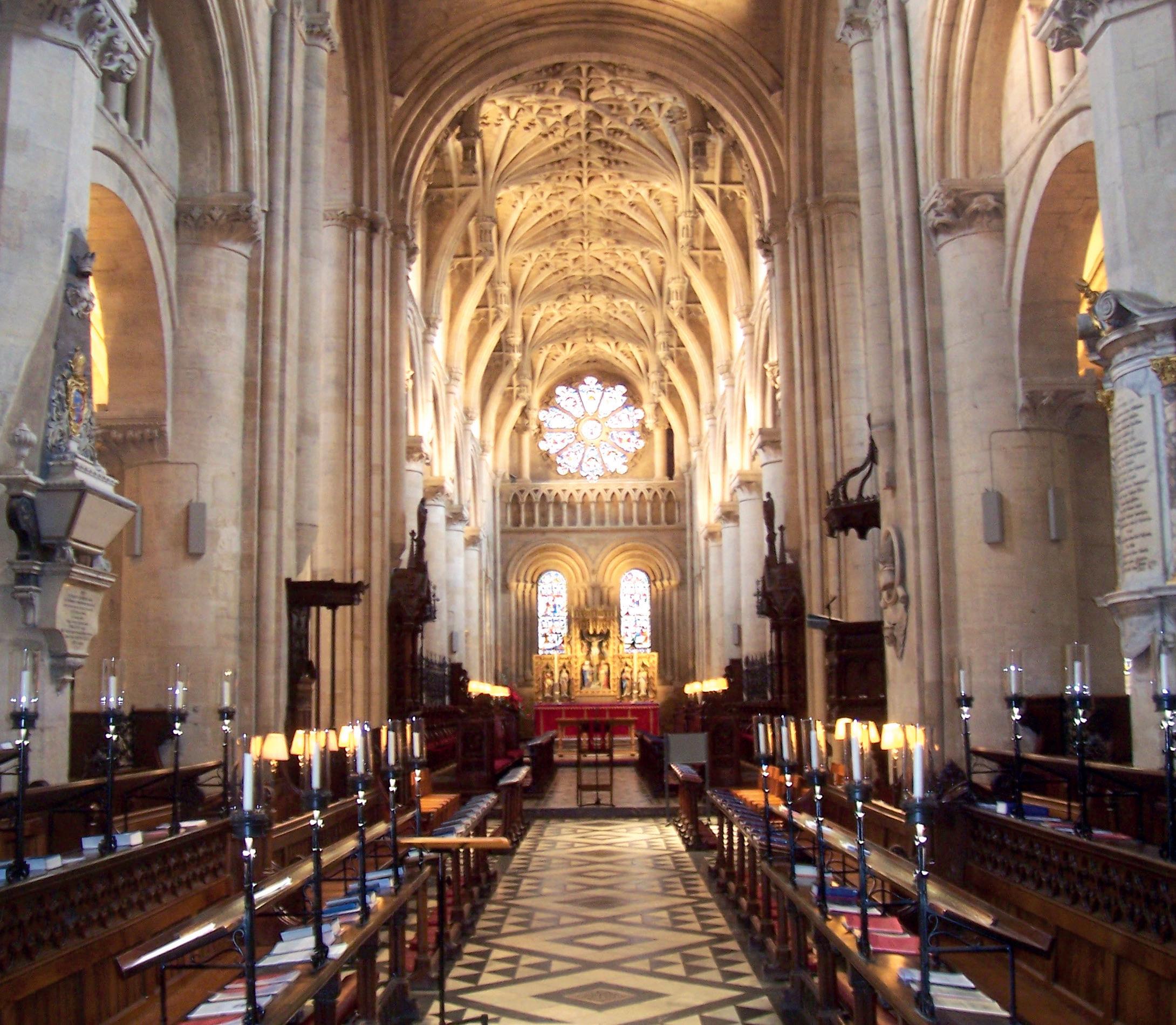
From Christ Church Anthony received a bursary to St Edward’s School in Oxford, where he led the school orchestra and sang in the chapel choir. He was called up for National Service in the Royal Artillery and received a commission. Various jobs in industry followed, until in 1960
he was appointed county secretary of the National Farmers’ Union in Cornwall. His past was discovered by the Dean of Truro Cathedral and he was asked to consider joining the cathedral choir. This was not possible as the job was not a nine-to-five one and involved much evening work. Soon after retirement he joined the cathedral voluntary choir, the St Mary’s Singers. Sadly this only lasted for two years due to his poor hearing and other commitments.

adham College Chapel Choir, not one of Oxford’s famous choirs like those of Magdalen, New College or Christ Church Cathedral, has been delighting audiences in south-west Germany with artistic renditions of English and other choral music from across the centuries, giving concerts in churches in the cities of Mannheim, Heidelberg, Offenburg and Freiburg-im-Breisgau.
Under the clear direction of its conductor, Katharine Pardee, the 19-member choir sang music selected from a printed programme, so there was plenty of variety in each concert, by William Byrd, Adrian Batten, Thomas Morley and Palestrina to Charles Stanford and W H Harris, as well as secular songs, including a lively African-American spiritual De Animals a-comin’.
A special treat in one of three concerts in the university city of Heidelberg (which is twinned with Oxford’s rival Cambridge) was a joint performance with the ‘Anglisten Chor’ – a local German choir specialising in English music – where the two choirs sang a few items together and others separately. It was interesting to hear two by Stanford, Beati quorum via sung by the Anglisten Chor, and the part song, When Mary thro’ the garden went sung by Wadham; both were equally good renditions, in the same style.
The German choir sang an anthem by the neglected 20thcentury British composer, Gerald Finzi (1901-56), but stole the show with a crowning performance of Great is the Lord by Edward Elgar (1857-1934), surely the greatest English composer heard in these concerts; (he is, by the way, performed only occasionally on the Continent).
Katharine Pardee, an American who has been in Oxford for the past 15 years as a lecturer and organist in the Music Faculty, is also Director of Music in Wadham College chapel and at Corpus Christi College, (the latter was on a separate tour to Rome without her). She told me the Wadham choir goes on tour about once a year, usually in the long summer vacation. Last year they went to the east coast of the USA.
How do they finance their trips? Well, some funding comes from generous donors (the college does not subsidise them), and the choir members (mainly undergraduates, with a few postgraduates and research Fellows from different disciplines) pay their own air fares. They stayed in youth hostels on this German tour, and some then continued on the continent on holiday.
At Wadham College in term-time a larger choir sings Evensong twice a week, supplemented by singers from other colleges. The college awards no fewer than 16 bursaries or scholarships to undergraduate singers every year.
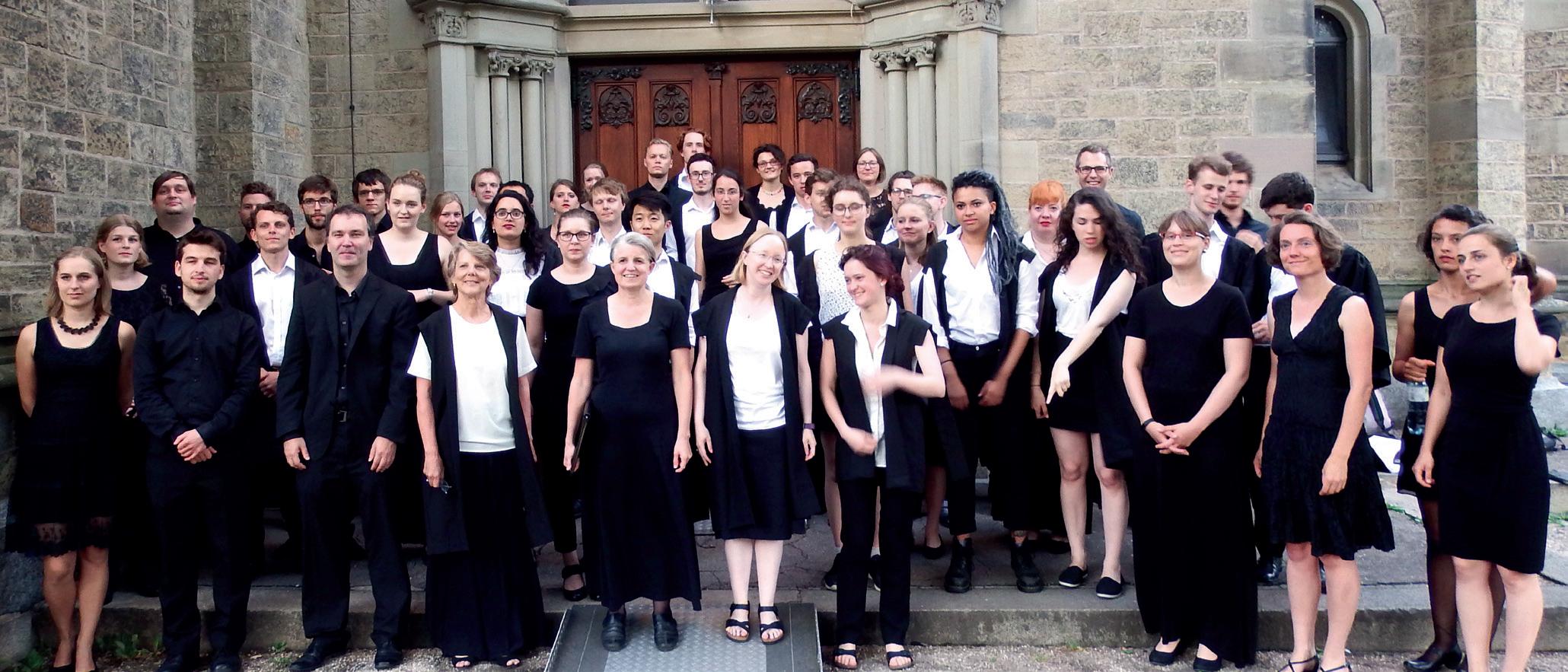
It was a treat for German audiences to hear English choral music authentically performed and very well sung! And good to hear the Palestrina psalm, with slight pauses halfway through the verses and not at the end.
Next year, the choir may be going on tour to another country. I suggested Switzerland to Katharine Pardee, merely because I have lived in both Bern and Geneva and have contacts there, but that may be too expensive a destination, she said. Another possibility, less demanding financially, might be Romania or elsewhere in Eastern Europe. All options are still open!
Hugh Hudson, who is a retired radio broadcaster and UN Information Officer now living near Heidelberg, was a chorister at Lichfield Cathedral, a pupil at Radley College, and is a modern languages graduate of New College Oxford. He sang in the Oxford Bach Choir under Dr Sydney Watson, and later in the Bach Choir under Sir David Willcocks and David Hill, and also in the London Philharmonic Choir under Neville Creed.
Education details (school/university): Eton College (2003-2008)

University of Oxford – Christ Church (2008-2011)
The Juilliard School, New York (2011-2013)
Career details to date (and dates): Organ Scholar at Christ Church Cathedral, Oxford (20082011), Associate Organist at St Thomas Church, Fifth Avenue, New York City (2012-current) – also Assistant Organist and Acting Director of Music during this time.
Were you a chorister, and if so, where?
I was a chorister at St Paul’s Cathedral in London between 1997 and 2003. It was really the start of my musical career and it is where I began organ lessons and conceived a real passion for music.
What or who made you take up the organ?
While a chorister, I had a long period of suffering from laryngitis which meant I couldn’t sing. Instead I was assigned to page-turn for the cathedral organists and this is where I began to want to play the organ. I was already a competent pianist and I wanted to give the organ a go. I was fortunate enough to be taught by the organ scholar and, later, the Assistant Organist for the last two years of my choristership.
What attracted you initially to St Thomas, Fifth Avenue?
When I came to New York in 2011, I was focusing on my concert career while pursuing my Masters degree at Juilliard. I had deliberately taken some time away from the liturgical side of playing but when the two Assistant Organists at St Thomas left almost simultaneously, I was contacted by John Scott, the then Director of Music, who I had known as a chorister in London and had been taught by for six years. The attraction of St Thomas was very obvious; the chance to work with exceptional musicians whether that was John Scott, the men of the choir or the boy choristers on a daily basis and also help train the boy choristers and shape their musicianship in a way that I had benefited so richly from as a chorister their age.

Are there many differences in training the choristers between St Thomas and, say, Christ Church Oxford?
I think the fundamentals are very similar, and of course the repertoire covered in both places is also similar. However, because the boys in St Thomas are American there are some significant differences in language (quarter notes versus crotchets for example) and also vowel sounds. It takes a little adjusting to but is easy to adapt to with time. I have found the choristers of St Thomas to be very caring and dedicated to the cause, and they enjoy the uniqueness of what they do here in the USA.
What are the particular challenges in creating a concert programme?
When I am putting together a concert programme I take into consideration many different factors; genre, composer, speed, atmosphere – to name but a few. I think variety is very
important (even within concerts that are ‘themed’ in a certain way). For example, many organists play Bach as an opening work but I try to find interesting alternatives and perhaps mix up the order of the works so that they are anything but chronological. A variety of loud and soft and also length of piece is also important. I think a danger with the organ is to overpower an audience with too much volume through the whole recital – something that is very easy to do with such a vast instrument.
What organ pieces have you been inspired to take up recently and why?
I have been working on a few different projects recently. Firstly, expanding my repertoire of J S Bach with the aim of learning all of it in the coming few years. I have recently performed Healey Willan’s iconic Introduction, Passacaglia and Fugue – a piece I have admired for many years but had never learnt until last year. I am also a great lover of transcriptions and have been working on (and transcribing from scratch) movements of Rachmaninov’s Symphonic Dances as well as works of Jean Sibelius and Edward Elgar – which will be revealed in the next few months! Finding the time alongside my busy schedule of concerts and services at St Thomas is always a challenge, so the vacation months in the summer prove to be my most productive for learning new repertoire.
Have you been listening to recordings of them and if so is it just one interpretation or many and which players?
When learning new repertoire I try and forge my own interpretation first, before turning to recordings by others. Obviously with the canonic works for organ, there are hundreds of very fine recordings by organists all over the world and I enjoy listening to a variety of interpretations before settling on my own version of the piece. Certainly with transcriptions this is most true – listening to a variety of orchestras and conductors can be very fulfilling and gives me ideas on how I might fit the work onto the organ.
After the death of John Scott, I had the opportunity to be the Acting Director of Music at St Thomas for 6 months, at which time I was responsible for the daily conducting of services, training of boy choristers, and leading the choir on several national tours and through performances at conventions in Houston and Stamford. It was an eye-opening, if not at times a little overwhelming, experience, and really ignited my love of conducting choirs and developing a style and sound that you can be proud of. Deep down, I would also love to do more orchestral conducting one day – something I look forward to exploring in the coming years.
You have won numerous prizes (at St Albans and Longwood Gardens in 2013, and at the RAM also). Are prizes helpful in a musician’s career?
Being successful at both Longwood Gardens and St Albans in 2013 was certainly one of the highlights of my career so far. Of course, it is always nice to feel appreciated and enjoy
that audiences and judges have rated your playing very highly. However, before my success in these competitions I also had some frustrating encounters where I did not win and I think it is important to remember that competitions are a wonderful career aid but they do not make an organist’s career. Some people are better competitors than others but that doesn’t mean that not winning these competitions means you are a less able organist. I have not entered many competitions in my career deliberately and I would advise anyone who is interested in these competitions to remember that they do not make or break one’s success as an organist or musician more generally.
What have you most enjoyed about your Masters degree at the Juilliard School?
The Juilliard School was a wonderful opportunity to engage with other musicians, different methods of teaching and different approaches to performance that I never would have had in Britain. I very much enjoyed my two years studying with Paul Jacobs, who certainly broadened my horizons in terms of interpretations and we had many very fulfilling lessons which involved much discussion about tailoring a performance to a particular organ or audience. I think the Juilliard School (and the performances that I did across the USA during my time as a student there) were a fantastic opportunity for me not only to meet and engage with people from all over the country, but also to develop my own performance career and style of playing which led to my success in Longwood Gardens in particular in the summer of 2013.
What was the last CD you bought?
I must admit I cannot remember. I don’t think I have any devices left that can play CDs in this apartment, in fact! The growth of online music programs has certainly meant that I own very few CDs: a wealth of performances are available at the click of a button now.
What was the last recording you were working on?
The last recording I worked on was with John Scott before he died in 2015 – recording the complete motets of J S Bach with the St Thomas Choir of Men and Boys. Since the death of John Scott, my time has very much been spent on the dayto-day service playing and directing, and also I have been on several tours to Asia, Australia and New Zealand as well as trying to keep up with European engagements when my schedule allows. I certainly have some projects in mind for the coming years; one of the organ works of J S Bach on the fabulous Taylor & Boody organ at St Thomas, and perhaps a more symphonic disc of transcriptions, focused primarily on Edward Elgar and William Walton and their orchestral works. Watch this space!
What is your
a) favourite organ to play? The organ in the ballroom of Longwood Gardens – unlike any other and just great fun. No other organ I know has a Steinway grand piano inside it!
b) favourite building? St Paul’s Cathedral in London – a very special place for me, of course, and I always enjoy performing there.
c) favourite anthem? It’s probably a tie between Bairstow’s Blessed City and Elgar’s Give unto the Lord
d) favourite set of canticles? Dyson in D or Stanford in A
e) favourite psalm and accompanying chants? Too many to count!
f) favourite organ piece? This changes frequently but a favourite right now would be Reubke’s Sonata on the 94th Psalm.
g) favourite composer? Richard Strauss or Edward Elgar.
Which pieces are you including in your next organ recital?
The next performance I have is in Princeton University in a few weeks’ time which includes works by Walton, Schumann, Mozart and Vierne and then some performance in the UK which will be the first performances of my new transcription of Rachmaninov’s Symphonic Dances which I am very excited about.
Have you played for an event or recital that stands out as a great moment?
This summer I was honoured to be invited to play in Auckland Town Hall which has a wonderful symphonic instrument on which I performed my transcription of Mussorgsky’s Pictures at an Exhibition. The organ, the building and the crowd were absolutely fantastic, and this will remain a very memorable performance of mine for years to come. I also have treasured memories of playing at the Royal Albert Hall in London when I was a young teenager for a massed high school orchestral concert. The power of that organ and the noise of the orchestra combined was quite something.
How do you cope with nerves?
This is always a difficult question. I personally find that there is no particular ‘cure’ for nerves. They are natural and actually quite beneficial as long as they don’t overwhelm you. I think experience has been the most beneficial tool to me – the more performances you do, the less anxious you get. I think as a young organist it is difficult to perfect every element of a performance from playing the right notes in the hands and feet to dealing with the management of stops and pistons – this was what made me the most anxious when I was starting out. However, fear of the ‘red light’ for recordings or radio broadcasts is still something that makes me extremely anxious even now!
Do you have the time to continue to play the piano?
I very much enjoy playing the piano in my spare time but I rarely do it professionally – certainly not as a soloist. I am looking forward to doing more in the coming year, however – the first performance being the extensive piano part in Vaughan Williams’ Dona nobis pacem in October with the St Thomas Choir in the church. This version is for strings and piano only, so the piano part is very significant. I have always been a big fan of playing orchestral keyboard, giving me a chance to interact with other musicians as part of a bigger ensemble – a nice contrast to the somewhat solitary life of a touring organist!
Would you recommend life as an organist?
I really could not see myself as having pursued any other career since the age of about 15, and I certainly have no regrets about my choice of career path. I have been fortunate enough to study with some of the world’s finest organists and teachers and also travel extensively to perform all over the globe. Here in America I have felt an exceptional appreciation of what we do as organists, whether as a solo recitalist or working with choirs or choirboys as I do at St Thomas. The warm reception I have received all over the world has cemented my love of the instrument and of what I do. Being an organist requires great commitment, dedication, hard work and a little frustration along the way. I would love to see more young people take up the profession and bring it into the public eye more. There is so much great music for the organ that isn’t known well enough by the general public and I feel, as organists, we are ambassadors for the instrument and must take responsibility for not only exposing others to the glorious music but also encouraging people to engage with this fabulous profession.
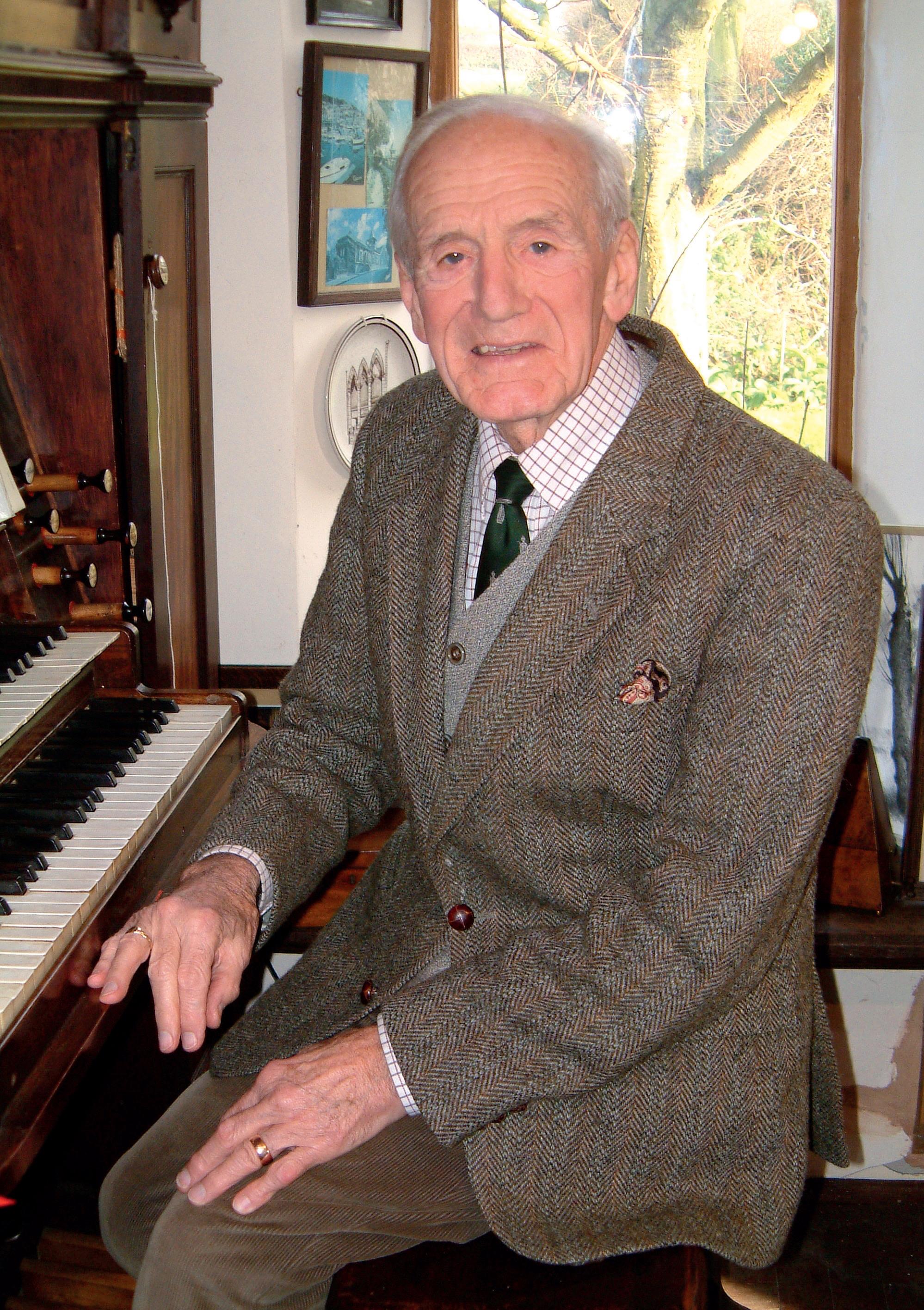

Marking the centenary of Dr Francis Jackson’s birth, this text is based on a lecture given at OrganFest, Hull City Hall on 9 September 2017.
The essentials of Francis Jackson’s career are well documented. His autobiography of 2013, Music for a Long While (a wonderfully deft adaptation of the title of a piece by Purcell),1 gives us a chance to get beyond the official cv and make a closer connection. ‘My long while cannot be a record,’ says Jackson in the preface, ‘but it has certainly been a complete joy and privilege.’ It is through the prism of his organ music that we can reflect a little on a remarkably creative life.
Francis Jackson’s catalogue of organ compositions amounts to around 60 solo works, three works for organ duet, six for organ with at least one other instrument, and an organ concerto.2 All told, the organ works comprise a third of his total compositional output, the earliest works of which date from the late 1930s. The list is rich and reveals many distinct activities: there are several orchestral works, some part-songs, solo songs, chamber music, and much religious or liturgical music.
The solo organ works fall into fairly clear phases, and almost all of them have been published. The first one dates from 1944 – the Impromptu, Op. 5, written to mark the 70th birthday of Sir Edward Bairstow – but it was not until the mid 1950s that Jackson tackled another one; not much dates from the 1960s, but thereafter quite a few emerged in the early ’70s (starting with the fine Sonata in G minor, Op. 35), and more again in the mid 1980s. Since the mid ’80s a steady stream of organ pieces has kept him busy. The sonatas amount to six in number.
Francis Jackson is a serious composer, with an individual voice and a significant catalogue, and his contributions to a variety of genres are marked by characteristics such as thematic inventiveness, pleasure in what we could perhaps call harmonic and tone-colour ‘research’, and fluency in handling structures, both large in scale and modest in proportion. It is composition of a high order, and in its aspiration it has frequently reached beyond the merely useful, though of course the catalogue does contain examples of what might be termed his Gebrauchsmusik (various fanfares and ceremonial
pieces, for example, many of which are exquisitely conceived miniatures). To quote a reviewer of the autobiography in a recent BIOS Journal, Jackson’s achievement as a composer is ‘The result not only of superior musicianship but also of curiosity about the techniques of composition and an enthusiasm for music outside the organ-loft’.3
This last observation should not be passed over quickly. The pages of the autobiography reveal a wide range of enthusiasms and music-making away from the organ. Jackson took ‘as a command, to be faithfully carried out’ one of Bairstow’s frequent adjurations: ‘Broaden your outlook and take an interest in as wide a spectrum of music as possible.’4 Felix Aprahamian, the London critic and organ aficionado, when introducing Francis Jackson in a BBC recital broadcast in 1966, said that the young York organist was not ‘one of the fuddy-duddies of the pre-War cathedral organ loft’, but one of a new generation that had invaded the organ loft and was an ‘enthusiastic and accomplished all-rounder’, a player who ceded nothing to his French confrères as a composer and nothing to visiting recitalists in his fluency as a performer.5 Composition and performance are inextricably linked in the Jackson story.
How might the 60-odd solo organ works be assessed? Selectively, perhaps, and with an eye on the ‘back story’. Jackson’s autobiography provides much of this, and there are also welcome reflections on the composing process. Bairstow’s adjurations to look beyond the organ loft were probably unnecessary. Certain creative compulsions catch the eye: Jackson’s piano playing, for instance, and the impact –hard to conceive now – of broadcasting and the gramophone (there is both the phenomenon of the ‘gramophone concert’ and also references to playing along to gramophone records). Jackson records his interest in jazz and band music, and the early impact of major figures such Vaughan Williams (whom he visited), Ireland, Walton, Bartók and Britten can be noted. As for Ravel and his music (Jackson is a self-declared Ravel addict), there is much in the book to flesh out this important infatuation.
In the chapter in his autobiography on composition, Jackson concedes that it is ‘a mysterious process, capricious and difficult to understand’, an act which must be developed and encouraged and, most importantly, regularly undertaken. He views composing as ‘improvising in slow motion’, an apt self-observation; he has a fluent improviser’s and interpreter’s facility to generate and negotiate musical paragraphs, and to manipulate, through a tonal ‘sixth sense’, the accumulation and diffusion of tension. Following Ravel’s practice, Jackson’s use of the keyboard when composing is interesting too: ‘I must hear exactly what is going down on the paper and, as I prefer complicated and colourful harmonies which I cannot invent in my head, the only course open is that of using a keyboard’.6
the Royal Festival Hall organ, and forays into organ design and aesthetics.10 Gallic enthusiasms impinge too: for instance, Dupré, Franck, and Vierne in the Toccata, Chorale and Fugue, Op. 16, and Dupré in the virtuosic and ‘Gothic’ Diversion (Mixtures), Op. 25.11 The application of contrapuntal techniques in the two chorale-based works of Op. 19 reveal further experiment and alignment with a neo-classical aesthetic, similar to, say, Flor Peeters, whose works Jackson regularly played. A modern matter-of-factness and contemporary harmonic colouring establish themselves in Recessional (1963), a short but salient work, the language of which becomes a lingua franca for Jackson. Jackson’s penchant for modality seems to have been absorbed from English sources and from Ravel. There are also noticeable shifts in emphasis in the way textures are handled: for example, the transition to the rather transparent triolike textures in Sonata No. 3 (1979). For Nieminski, a stylistic summary of Jackson’s work can be found in the Seven Pieces, a collection of short works written over several decades and published in 1988.
There are currently six organ sonatas, and Jackson’s commitment to this ever-intriguing genre has created a significant and distinguished body of music. They constitute the largest body of such organ pieces by a British composer since Stanford’s set of five (1917–21). Always comfortably idiomatic, each of the works is in some way associated with a particular instrument; they are all driven by a preoccupation with motifs and carefully linked themes; all are cast in accessible harmonic language, usually, though not entirely, with a modern piquancy to it; all show lucid tonal planning and are invariably adept at handling tension, a facility rooted in improvisational skill; and all except the programmatic Sonata Giocosa (No. 2, 1972) are autonomous, free works.
Jackson’s thoughts on how to assemble material also invite investigation. A good deal more material than first and second subject is needed, he tells us, recalling Bairstow’s advice about bringing in plenty of material for thematic development. Examples are given in the book, including Brahms’s Symphony No. 4 – a work, incidentally, that Bairstow lectured on at the RCO7 – and other large-scale symphonic works.
To date, the critical literature on Jackson is not huge. There are references to him – as a composer, as a performer, and in association with organ design – scattered around the pages of the periodical literature, but it was not until Jackson’s 70th birthday that Peter Hardwick was to consider his organ music in any detail.8 Others have also commented on style and technique. Simon Nieminski wrote a fine commentary for The Musical Times in 1996.

In the critiques, the origins and evolution of Jackson’s compositional technique and style are clearly drawn. Broadly speaking, he is a composer whose earliest essay for the organ, the Impromptu for Bairstow, is quite clearly influenced by the dedicatee.9 Healey Willan’s music then intrigues the young player-composer, in particular the magnificent Introduction, Passacaglia and Fugue, a piece he often played. As the 1950s progress, Jackson tempers an English romantic sensibility with neo-classical elements, a cross-fertilisation underpinned by his encounter with the new classical-style Danish organs,
What can be said about the national context for Jackson’s sonata writing? There are those British composers for whom a romantic ethos continued to permeate sonata composition (e.g. Ashfield, Lang, Rowley), then there were those who emphasised the sonata’s classical origins (e.g. Arnell, Christopher, Cooke), and also those for whom the sonata acted as a mark of historical authority for innovative, progressive writing (e.g. Forbes, Fricker). Finally, there are those for whom an organ sonata appeared either irrelevant or unsuitable: Leighton and Mathias, high profile figures both, did not oblige in the genre, nor did Whettam, and nor has Joubert.
The persistence of the organ sonata in Britain – thanks in no small part to Jackson’s contribution – is an interesting topic. In some ways, this persistence echoes what we in this country have tended to make of the orchestral symphony: we have preserved and polished it as an heirloom through regular performances, and contributed new treasures to the collection. An important moment of blossoming in organ sonata composition in Britain came about in the guise of a series of fine new treasures added to the collection by several player-composers in the 1930s: Bairstow’s Sonata (authored, of course, late in his life), William Harris’s, Herbert Howells’ 1933 work, and Percy Whitlock’s. Jackson’s personal investment in the organ sonata stems a good deal from these late-Romantic/ early modern essays, and from the French symphonies, than in response to particular post-War sonatas.12 What has taken place, in the limited confines of the British organ sonata, seems to differ little in motivation to what has taken place
in the parallel discipline of the orchestral symphony: the multiple symphonies of inter alia Vaughan Williams, Rubbra, Searle, and in recent times Maxwell Davies (who wrote 10), all testify to a strong urge to preserve and deepen a viable tradition, one which fuses craftsmanship, style, and status. A potent sonata ‘ethos’ has chimed strongly for Jackson, in part through a respect for the past, but also because of an extraordinarily active performing career and the resulting intimate connections with particular instruments.
The tried-and-tested solo sonata has clearly continued to provide Francis Jackson with his means of realising a kinship with the past as well as a mechanism for personal expression. Moreover, it has been a forum in which composition and performance (including improvisation) – two sides of the same creative coin – have found fruitful expression. What can certainly be said is that the sonatas, along with many other works in different genres and styles, have come about thanks to what Jackson reckons the whole purpose of music to be: to please and to enlighten.13
Francis’s characteristically modest ambition about composition, and about how his works might be viewed, can be quoted by way of conclusion:
“I never, in whatever medium, tried to ‘push out the frontiers of music’, tried to be original, or modern … [My music] is conventional and firmly in the mainstream … I hope that some of my pieces may survive and join the English school –Stanford, Bairstow – even Smart in his day, bless him; Wesley, Whitlock, Statham.”14
We must be grateful that Francis has seen his life as a musician inextricably linked with efforts to supply material for his instrument, and that he has invested so much effort –and faith – in many species of composition. Francis is a truly accomplished composer for our instrument. His music is music which deserves to be played ‘for a long while’.
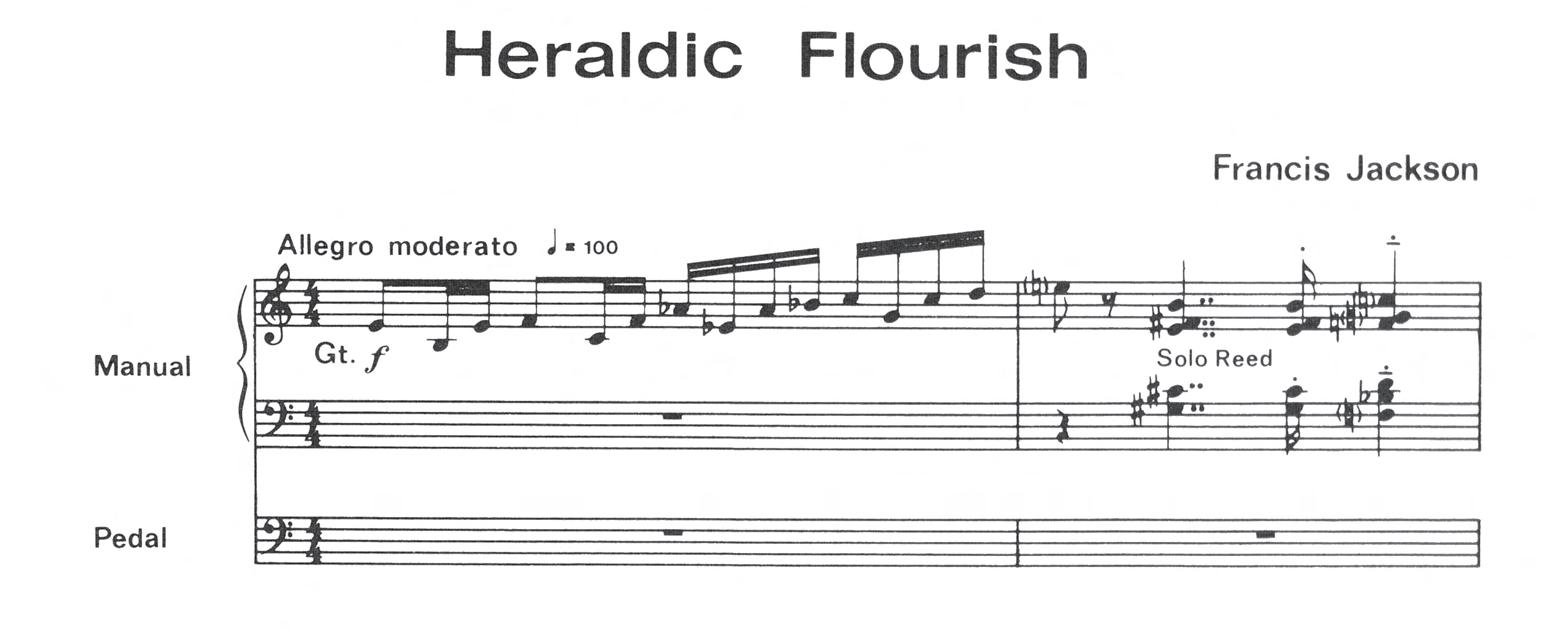
1 Jackson, Francis, Music for a Long While: The Autobiography of Francis Jackson (East Acklam: Published by the author, 2013).
2 See the works list in Jackson, Music for a Long While, 412–19.
3 Clark, Relf, ‘Francis Jackson, Music for a long while’, JBIOS 38 (2014), 220.
4 Jackson, op. cit., 217.
5 Transcribed in the liner notes (by Simon Lindley) of Francis Jackson: Live, York Minster, Recorded 1947–2012, Amphion PHI CD 227, 2012.
6 Jackson, op. cit., 359.
7 Bairstow, Edward, ‘Brahms’s Fourth Symphony, Op. 98’, Calendar of the Royal College of Organists 1937–38, 152–64.
8 Hardwick, Peter, ‘Francis Jackson at 70’, MT 128 (October 1987), 585–9.
9 The Impromptu was first published by OUP, but copyright was later assigned to Novello. It was included in Jackson’s compilation of pieces by York Minster organists for Novello: York Organ Album (1987). A beguiling and poetic work with harmonic gestures clearly derived from the music of its dedicatee, Op. 5 is based on the ostinato theme Bairstow had used in the Sanctus of his Communion Service of 1913 (Novello). Bairstow’s short theme, in its original form, is quoted exactly towards the end of Jackson’s work. The choice of 5/4 perhaps acknowledges Bairstow’s Toccata-Prelude on the Plain-Song, ‘Pange Lingua’ (Augener, 1911).
10 For Jackson’s transformative Danish recital tour of 1955, see Jackson, op. cit., 198–9, and his letter in MT 105 (July 1964), 516–17. For Jackson’s thoughts on organ design, see Clutton, Cecil, ‘St Helen’s Church, York’, The Organ 41 (1961–2), 33–7.
11 Both were published by Novello, in 1957 and 1960 respectively. Diversion was one of the more progressive contributions to an anthology called The Colours of the Organ, which according to the publisher’s note was an attempt to provide pieces which displayed the ‘individual tone-colours of the modern organ’ – an act which rather deconstructed the homogenous ‘orchestral organ’. The colourful cover is suitably abstract and modernist in design.
12 See Jackson, op. cit., passim, for Jackson’s advocacy of Bairstow and Whitlock. Jackson’s Fifth Sonata (2003) was written in homage of Whitlock (at his centenary) and alludes to the latter’s 1937 work.
13 Jackson, op. cit., 364.
14 Ibid., 212–13.
Chester Cathedral Nave Choir, which is reputedly the longest continuously-serving cathedral voluntary choir in the country, in November 2017 will be celebrating 150 years since its founding and initial service on Advent Sunday in 1867.
When the new dean, John Saul Howson, arrived at Chester Cathedral in July 1867, he found the building in disrepair. Amongst other things, the nave was not used at all for services and was not, as it stood, practical. Services took place in the quire and were attended only by the elite.
Changing this was a priority for Howson. At the chapter meeting immediately following his installation the order was given for the nave to be fitted out to hold services for a greater number of people. This was considered a positive move, viz the announcement made in the Chester Chronicle on 3 August, in which it was also stated that a new choir would be necessary for the larger scale of these services:
To give full efficiency to them, it will be necessary that the choir of the cathedral should be considerably supplemented by volunteers. No doubt there are many young persons in Chester, well affected towards the church, who will be glad to give their aid to this good work and join the voluntary choir.
The next few months saw considerable work done to make the nave fit for the inaugural service on Advent Sunday. The area was filled with seating to accommodate 1,500 people, a new heating system was installed and curtains were hung over the west doors to keep out the draught. The cathedral organist supplied an organ which appears to have been his personal property. Along with these improvements, a new choir was recruited. The Chester Chronicle published this advertisement in two of its October editions:
It’s obvious that the service was to be conducted on a grand scale, aiming at congregations of over 1,000 with a choir of proportionate size – way beyond the existing cathedral choir of just six lay clerks plus boy choristers.
The inaugural service was greeted with enthusiasm (if the report in the Chester Chronicle is to be believed).
A literally overflowing congregation assembled … the temperature of the place is very agreeable … there was a congregation of some 2,000 persons … while crowds were unable to gain admission. Praise is given to the choir members, who ‘acquitted themselves remarkably well in their performances’, although, frustratingly, beyond the mention of ferial responses, nothing is said about what they sang.
It was intended that these services should be set apart from the other activities of the cathedral. Duties were undertaken by cathedral staff on a voluntary basis, in addition to their paid work. An attendee at a service in May 1870 commented that the choir was well trained and well led by ‘the musical officers of the cathedral’.
It was perhaps inevitable that this informal arrangement could not last. In November 1870 it was agreed that the musicians who assisted at the nave services should be paid extra, and by 1873 it was decided that ‘All the Minor Canons and Lay Clerks who shall be admitted on & after this day shall be required to attend & give their services at the Sunday evenings in the Nave’. The Nave Choir, as it became known, thus appears to have been a combination of cathedral professionals and volunteer amateurs, but by this time it had a regular conductor – lay clerk Edward Cuzner. Cuzner conducted the Naves until his retirement in 1900, by which time he had been at Chester Cathedral for 50 years and conducting the Naves for 31.
Some comparisons can be made between the choir 150 years ago and the choir today. Whilst it has shrunk considerably from the 150 voices attending its debut service (now numbering ~ 24), it is still entirely voluntary and maintains the high standard of singing that was evident at the beginning. And although it is a fundamental part of the cathedral’s musical offering, it is both connected with, and separate from, the cathedral choir, because it is conducted by Andrew Wyatt, the Assistant Director of Music and accompanied by Rachel Mahon, the Assistant Organist. However, lay clerks are no longer required to assist! Another difference between then and now is in the temperature of the building during the winter, which these days is not so much ‘agreeable’ as ‘arctic’ (particularly in the quire)!
The Nave Choir is now extremely busy. It still sings a regular Sunday evening service during term time, usually Compline, and sings for many of the major liturgical services within the cathedral such as Ash Wednesday, Maundy Thursday, Ascension Day and Midnight Mass. It also sings the main Sunday services when the cathedral choir has been busy with concerts or is otherwise engaged, and sings at other churches within (or occasionally outside) the diocese. The choir also has a programme of concerts which it sings within the cathedral and at other churches, and has sung live on BBC Radio 4’s Sunday Worship
One of the highlights of the year for the choir is the annual summer tour. Recent visits have included singing in the three cathedrals in Edinburgh, in Southwark Cathedral, Westminster Abbey, the Isle of Man (a very well attended outdoor Mass in the ruins of the old Peel Cathedral accompanied by seagulls being a surprising highlight!), Ripon Cathedral and, most
recently, Malvern Priory and Worcester Cathedral. The choir have also recently toured to Munich and Hildesheim, where they were enthusiastically received by congregations and audiences alike.
As the Nave Choir approaches its 150th anniversary, plans are afoot for an exciting year of musical celebrations. The Sunday evening service singing will continue, with the addition of Sung Vespers to run alongside Sung Compline. This gives a variety to the services as well as opening up new repertoire to the choir. On 26 November there will be a ‘festal compline’ to mark the start of the year, and on 9 June 2018 the Naves’ summer concert will be held at Chester Cathedral. This will be with chamber orchestra and might feature a new composition for the Nave Choir to mark the occasion. Much more is in the pipeline, details of which will be available on the Chester Cathedral website in due course.
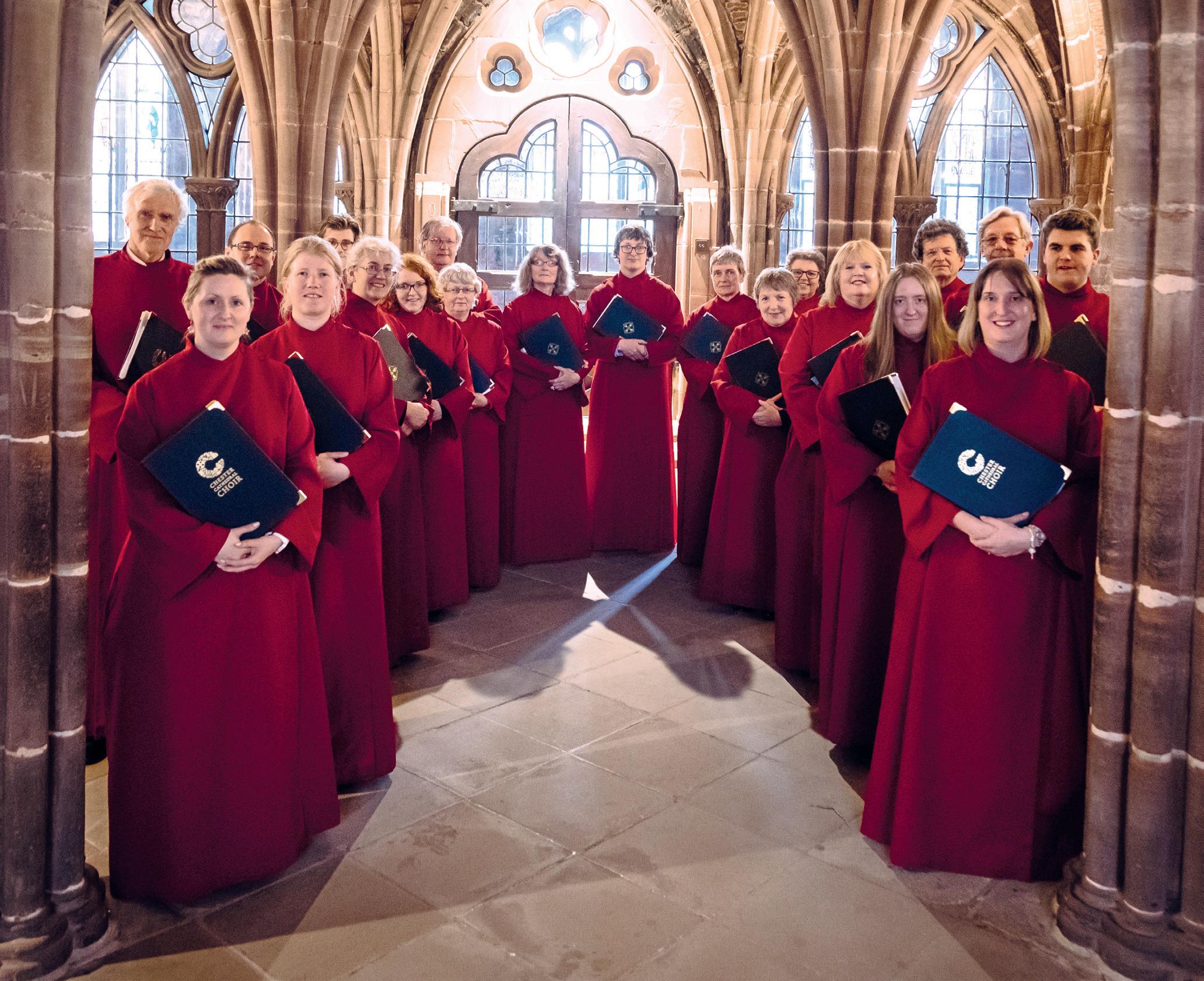
It is often said, among and about professionals who live here, that Bath is the graveyard of ambition. A cursory glance at the service of past organists of Bath Abbey would seem to confirm that doleful sentence – Pyne’s half-century, New’s 43 years, Maynard’s 31. In contrast, however, the 30 years during which Peter King served, first as Organist and Master of the Choristers and latterly as Director of Music, give the lie to the hoary myth. Peter’s ambition remained keen to the end, though perhaps it was the fact that his ambition was patently less for himself than for the quality of the music offered in worship at the Lantern of the West that kept his focus sharp and his energy primed throughout.

Peter King came to Bath Abbey in September 1986. There had been an interregnum of a full year since the sudden departure of Dudley Holroyd, and Peter would be the first to acknowledge the heroic work of Marcus Sealy, the Assistant



Organist he inherited with the post, in keeping the music buoyant during that difficult time.
Peter came to a parish church with a proud but not especially professional tradition of music in worship. Boys were recruited from local schools – a process that was helped by Dudley Holroyd being only half-time Organist and Master of the Choristers: he also held a post as lecturer in education at what is now Bath Spa University. This gave him entry to local schools in order to supervise students on teaching practice, and this enabled him to forge relationships with staff and seek out boys for the Abbey choir. The men were recruited by any means available, often word of mouth. There was a will to do well: to learn challenging music, to perform it to a high standard, and to maintain clear water between ‘the Abbey Choir’ and the other church choirs of men and boys that were still extant (if not exactly commonplace) locally. Broadcasting

Choral Evensong was a rare privilege; recording the repertoire an exciting if nerve-tweaking test of concentration and stamina.


From the start, Peter set out to break the limitations of the ‘parish choir’ mindset, but it was by no means a foregone conclusion that he would achieve this objective. There were those who, when his appointment was announced, questioned the wisdom of selecting a man from a cathedral background for the job; and there were those who doubted the propriety of the ambition: the choir of Bath Abbey should know its place, they felt, symbolised by its position in the procession at the annual Diocesan Choral Festival – ahead of all the other parish church choirs … but behind the cathedral choir.
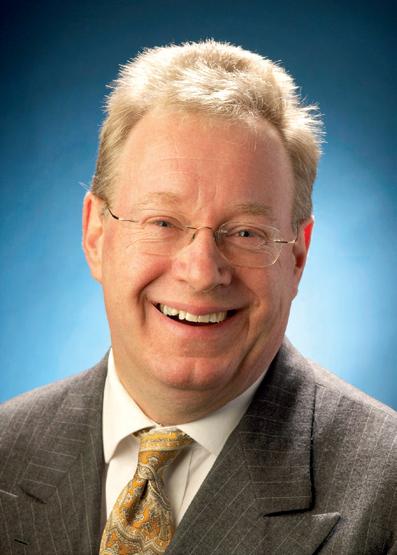


Peter could do symbolism too. He did away with the old hierarchy among the boys as defined by the wearing of
coloured ribbons: from none, via red to the coveted blue, the progression achieved by passing tests and getting the Master’s initials on a record card. Henceforth the award of the surplice, indicating the move from satisfactory probation to full membership, was the only hurdle: once a boy was admitted to the choir, he was expected to pull his weight as fully as all the others and not ‘leave it to the ribbon-boys’.
Peter had been appointed by Prebendary Geoffrey Lester who by the time the new organist took up his position was in poor health and coming towards the end of his long tenure of the rectory. ‘GL’ knew his music and was keen that Peter should be allowed to make changes and ratchet up the standard. It was a challenging remit: Peter never had the automatic entrée to schools that Dudley had enjoyed; he had to beg to be allowed to go into schools to recruit, and he had to look to his own private teaching to supplement his salary. It was hard graft. Moreover, only two years and a term after he arrived, ‘GL’ retired and there was a vacancy of 15 months until the appointment of Canon Richard Askew, a man who by his own admission was not a connoisseur of church music.
But that time was enough for Peter to have taken stock of the situation – the current circumstances and the prognosis for the future – and during the vacancy he unveiled his plans for development. The Abbey was always the beneficiary of his sharp mind and cogent arguing (his Cambridge degree was, after all, partly in Law!) and with the assistance of the then headmaster of King Edward’s School (significantly, also a lay reader at Bath Abbey), the ‘Wroughton Report’ was a thorough and wide-ranging review of the way in which the Abbey choir operated as an institution; its recommendations paved the way for future success and stability, both for the boys’ choir and for the gentlemen of the back rows. Thus, as the Abbey moved into the 1990s under fresh clerical leadership, the choir entered a new phase of its history, generously resourced and ready to rise up the ranks of ecclesiastical music-makers on a national scale.
Peter’s middle years were notable for two developments the significance of which it would be difficult to overstate. The first was the rebuilding of the Abbey organ. Removed from its position atop the traditional stone screen dividing nave from chancel as in so many cathedrals, the Abbey organ had been banished to the north transept when George Gilbert Scott had done away with the screen in the 1860s. Subsequent alterations and improvements had been effected piecemeal; even the significant addition of the Positive organ in 1972 had been done without thoroughgoing overhaul of the rest and, in consequence, there were many serious problems: different types of action spoke at different speeds, the layout of pipes in the case was without logic – and some of them were so difficult to access that tuning them was all but impossible.
Peter’s eloquence persuaded the rector and PCC that nothing short of complete rebuilding would suffice, and so that objective was added to the projects under the umbrella of ‘Bath Abbey 2000’. Part of the argument was that, while the interior of the Abbey was going to be cleaned of five centuries of grime, the organ would in any case have to be (at least partially) dismantled and stored; none of it could be used while the stonework around was being cleaned. But that was only the excuse: the real intention was a completely new action and some semblance of sensible order to the pipework.
Peter recruited Nicolas Kynaston as consultant and the two set about the task of finding an organ-builder with sufficient imagination and expertise to solve the problems.
They found such a man in Philipp Klais, of Klais-Orgelbau of Bonn, and the triumphant result remains among the finest organs in England as well as a monument to the vision of King and Kynaston, who never doubted that only the best would do. Some alteration of the case was necessary, but the integrity of its design and its essential character were kept intact. A very high proportion of the pipes were reused after refurbishment, so that the sound of the Abbey organ was not radically changed; but their positions, the action that made them speak, and the stop operating systems were all renewed and improved. Careful thought was given to the tonal additions that were necessary to ensure that the organ was suited to all styles and periods of music, and the crowning glory was the skill of Klais’s voicing experts, who released the sound from the transept into the body of the church with striking effect. The whole project cost five times what the most ambitious of the five English organ-builders asked to tender had originally quoted, but Peter King stuck doggedly to the task and, with a generous grant from what was then the Arts Council, saw the project through to its triumphant conclusion.
The other lasting legacy of Peter’s vision and enthusiasm is the girls’ choir. At a time when arguments for and against girls singing Anglican choral music in a liturgical setting raged fiercely, Peter knew that in order to secure the tradition in a resolutely egalitarian age there should be an opportunity given to young ladies to enjoy the privileges so long restricted to the male of the species. But he was wise enough also to know that it was the mixing of the two that would undermine

the benefits for both. The sociological reasons for this are much more significant than the musical ones: by and large, the views of teenage girls about younger boys (and vice versa) are not conducive to harmonious co-operation in any sense of the word, and Peter was too wise to try to reform human nature in the short term.
So it came about that in 1996 a choir of girls was formed to sing in alternation with the boys and only very rarely in combination with them. It was a triumphant revolution, and the standard achieved and maintained by generations of the ‘matchless maidens’ (the hyperbole is forgivable) has not only impressed congregations and audiences in – and far beyond – the Abbey but has also incited the boys to look to their own laurels. Not that Peter ever encouraged comparison, let alone competition; but by judicious choice of repertoire and opportunity he saw to it that both choirs flourished and improved.
The improvement can be traced through the recordings of choral music made by the Abbey choirs in the last twenty years. Four volumes of Music for an Abbey’s Year and several other CDs include a wide range of works, from the inevitable ‘war horses’ (Stanford, Parry, Wood) to some interesting, less familiar pieces by contemporary composers: Peter’s choice of repertoire both for liturgical use and for recording was as much informed by a desire to educate congregations and listeners at home as by the need to keep providing choristers with new challenges and discoveries. His own series of recordings of organ music, exhibiting all the potential of the Klais organ, also cover a broad compass of styles, from ‘lollipops’ to Liszt. The former should not be disdained: they are immensely entertaining, and illustrate not just the technical skill of the
player but his wit and joie de vivre in playing; the latter enjoy the very highest critical acclaim.
Peter demonstrated similarly eclectic but judicious care in his choice of music for broadcast services. Under his tutelage, the Abbey Choir made regular contributions to BBC Radio 3’s Choral Evensong and occasional appearances on other, less obvious, radio channels. But the culmination of Peter’s broadcasting with the choirs of Bath Abbey came in December 2015. The Abbey was invited to broadcast the Christmas Day Eucharist live on BBC1, and the clergy and the music department under Peter were equally keen that the opportunity should be taken to make an impact. Neither party wished the programme to be as anodyne as much broadcast liturgy has become. The rector and his team created their own message of the meaning of the Nativity and Peter ensured that the music that accompanied, punctuated and embellished that message was as impressive as the visual and verbal content. He used the full musical resources of the ‘Great Choir’ (and the junior ‘Melody Makers’ – another innovation on his watch) and the organ; and it was a triumph. The very next day, BBC Radio 3’s Record Review programme highlighted Poulenc’s Organ Concerto in the ‘Building a Library’ series; and Peter King’s recording on the Klais organ in the Abbey with the National Orchestra of Wales was selected as the top recommendation and generously lauded.
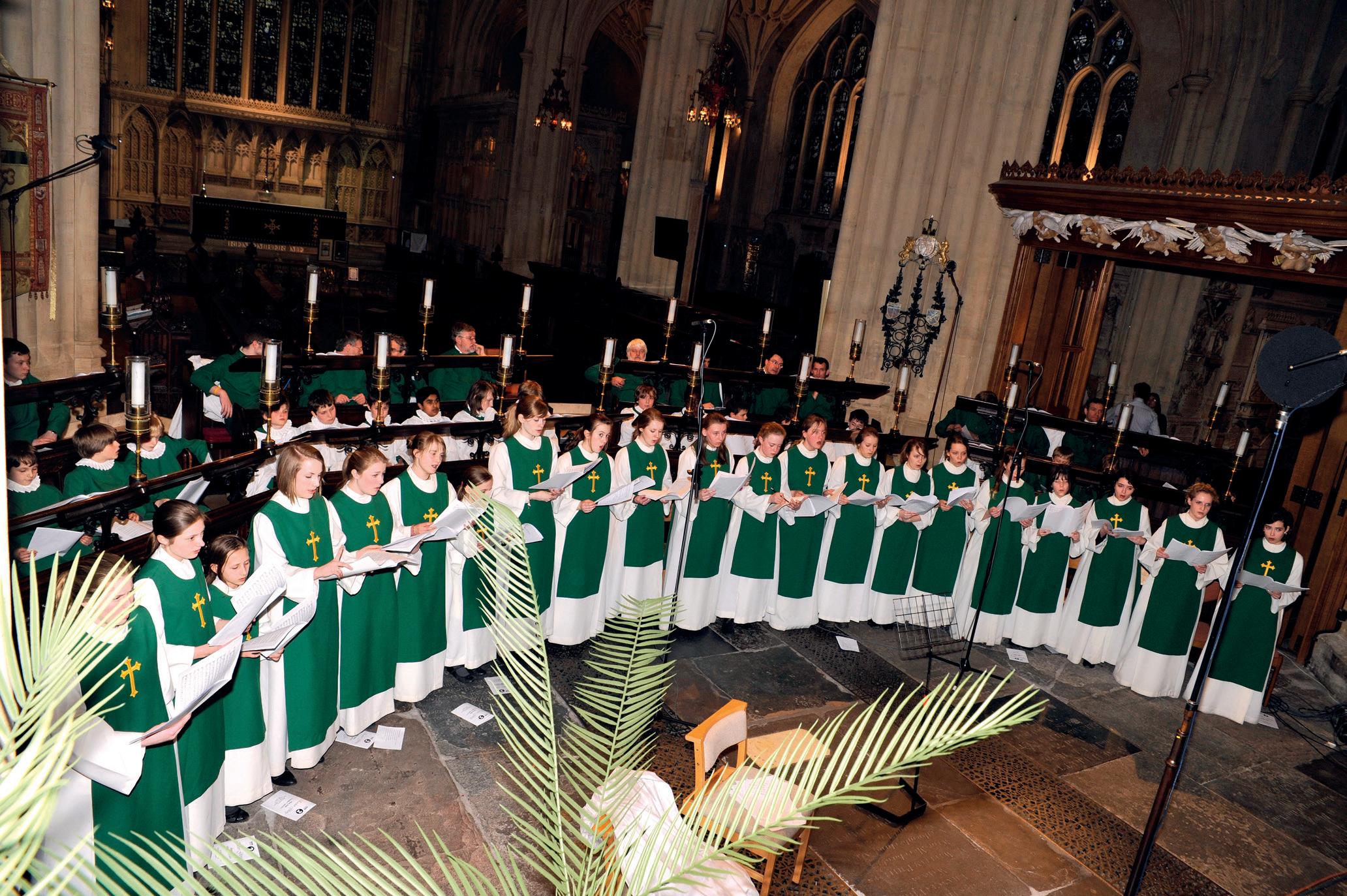
There was nothing left to strive for, or to prove. In 30 years Peter had raised the standard of music at Bath Abbey to an unprecedented level; and with typical generosity he stepped down at the height of his powers, handing the department on in outstanding condition, a fitting monument to the reign of this particular King and to his right royal achievements.
Jeremy Key-Pugh had his first introduction to church music under Dr Willis Grant, who invited him to stand in the ranks of the cathedral choirboys next to David Munrow and learn from him. After reading French and German at Oxford University, Jeremy began teaching at Warwick School, moving in 1973 to Bath’s Kingswood School, from which he retired 32 years later as Head of Modern Languages. In 1974 he joined the choir of Bath Abbey, singing under Dudley Holroyd and then Peter King; retiring from the choir in 1995, he became a lay reader, preaching to congregations instead of singing to them. As tenors are always in demand, he started a modest career as a soloist, coached locally by the incomparable Molly Petrie. His speciality is Victorian and Edwardian parlour songs, but he has loved church music ever since he was taken to an RSCM evensong in Gloucester Cathedral where they sang O Thou the central orb , accompanied by Dr Sumsion himself (on the old Gloucester organ).


Working with Roger Tucker was as frustrating as it was rewarding. He was affectionately referred to as ‘Rhyming Slang’ by some of us who worked closely with him, as we were more often than not at the end of a long phone call that lasted into the early hours.

I first encountered Roger when he wrote to me shortly after I took over the editing of the old Annual Report. He pointed out that there were a few typos that needed correcting and then proceeded to do what Roger was so good at – the very persuasive sales pitch. Before I knew it, he was helping on the editing front, and he stayed for my 20-year period as Editor of Cathedral Music, as a friend and eventually as Deputy
Editor. His encyclopaedic knowledge about nearly everything was truly impressive, as was his intellectual integrity. When we were proof-reading, he would often challenge – forcibly, but appropriately – my thought processes, and I can say with certainty that I am richer for having had those discussions. Often we would debate ferociously, but we never once fell out. To Roger’s credit, he never held anything against the brave person who took him on. He was always late with copy (and in life generally) but when his prose arrived it hardly needed editing, each word carefully chosen, the grammar tight. Indeed, so crafted was every sentence he wrote that it was often impossible for a sub-editor to cut his copy to fit the space available. In my opinion, Roger’s command of the
English language was superlative. ‘Why use twenty words when eight will do?’ was one of his guiding principles, though he did not frequently adhere to this maxim in conversation.


He was also extremely thorough. He checked every fact he thought was wrong in Cathedral Music, and, although I did not say it often enough, I owed him a debt of gratitude for this, especially near the end of my tenure when my job got in the way and time was at a premium. He particularly loved ‘CM Comment’ for its often daring and polemical take on what was happening in our world. He quite rightly appreciated that no other journal produced something quite like it, recognising its value in stirring opinions among a readership that cared profoundly about the musical life of cathedrals.
Roger was also a man of his time. His interests, from politics through to the BBC Organ Club, via economics and business, made him one of the most interesting men I have had the pleasure to work with. The long telephone calls, the digressions arising out of his interests, his love of conversation, his intransigent views – yes, they made him someone who could be annoying when deadlines were looming, but he was also much loved and respected.
Roger was a life-long Labour supporter, and woe betide anyone who decided to challenge him to a debate. He was immensely proud to be an alumnus of his beloved Durham University, with the city and its cathedral remaining favourite places to visit. As a schoolboy, he attended Dulwich College.

He was a familiar figure, often seen walking strangely (because of a medical condition with his feet) or – further evidence of his dedication to FCM – sitting in some hidden corner of a cathedral transept whilst manning our exhibition stall at the SCF or the Three Choirs Festival. He also loved to take people to the BBC and, like many, I have been into the depths of the Broadcasting House concert hall to play the organ.
Roger loved chatting to friends and strangers alike. Although he could talk and talk, he never bored people, and he had an empathy that meant he could communicate with all age groups and people from all walks of life. It was one of his most attractive attributes. Very much a European, too, he would have been delighted that the finale to Beethoven’s Symphony No. 9, the Ode to Joy, accompanied him from West Norwood Crematorium.
Confident and comfortable in his own skin, Roger was very much his own man. His great friend, Bernard Stringer, of whom he always spoke highly, wrote that he learned many things from Roger, but if one in particular stands out, it was this: ‘Do what you want to, at your pace, and be damned to anyone else.’ All those who knew Roger will be smiling with acknowledgement at this: it captures the essence of his somewhat complex character, and is a rather charming way to remember him.
I well remember the Organ Familiarity classes of my O levels, largely because the instruments were usually draughty 2-manual ones with a pedal note or two unsounding, so you had to choose the key carefully or become good at transposing. Despite this, I came away with the knowledge that there existed instruments with a full working pedalboard and three manuals, which made me, at 14, wonder why. After all, you only have two hands.
I continued to wonder. When, as a new BBC employee, I learned that a 3-manual organ existed at Broadcasting House, I resolved to seek it out. One night in the summer of 1975 when the National Anthem ended, and armed with no more than a BBC pass card, I set off. It didn’t take long to find the organ in the Broadcasting House concert hall, and there in awesome fascination I beheld not three but four manuals and, to top it all, someone playing it.
So Roger entered my life.
He introduced himself as the chairman of the BBC Organ Club, and during the next two hours I tried and tested every stop on that organ. I became a member of the club on the spot and went home – but he made no such move, leaving me to wonder the following morning whether he was just an apparition.
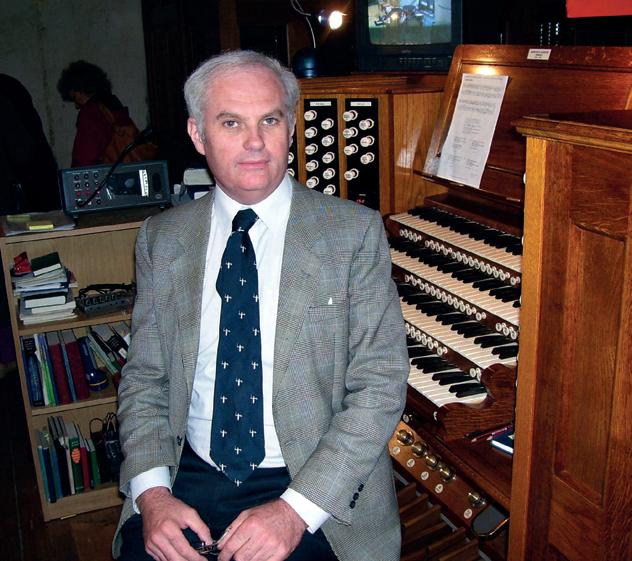
I wasn’t the only one. An article appeared in the national press about the ghost of a past organist appearing in BH at 4am. Well, I will let you into a secret: it was Roger.
Apart from regular nocturnal organ practice with him, I attended many concerts and visits that he organised, the two most memorable being the George Thalben Ball one, in which the Broadcasting House blower failed and Roger calmly negotiated relocating to All Souls, and the one
at the State Cinema in Grays in Essex, where we had the opportunity to play the illuminated Compton organ.
When attending a concert with Roger, it was quite usual to take your seat after the first item. But arriving late at one Carlo Curley concert, he refused to wait when the usher tried to stop us and pushed past her. We dived hurriedly into our seats, and this behaviour was so unusual that I queried it. Roger explained that at the last Carlo concert he’d attended, Carlo had spotted him taking his seat and immediately greeted him in a very loud voice: Well, hello, Roger! Glad you could make it! And with that he introduced Roger to the whole auditorium: Ladies and gentlemen, a big round of applause for Mr Roger Tucker! (and he got it).
1990 was ‘Learn-the-Organ’ year, and only Roger could organise a tuition group for the BBC at St Martin’s-in-theFields, where on Sunday evenings six loyal members would take turns with a pre-rehearsed score on the 3-manual Walker. Not only did Roger organise it all faultlessly, the biggest achievement of all was that he persuaded the BBC to pay for it!
2005 saw my retirement from the BBC, and, courtesy of Roger, I was conscripted into the Alexandra Palace Organ Appeal and Friends of Cathedral Music, where my running of the exhibition stands gave him the freedom to engage his encyclopaedic mind with the attendees.
On the FCM stand at the SCF in Chichester in 2013 it was apparent that Roger was physically failing and this was to be the last practical venture. Nevertheless we still attended the BBC Proms and, despite him now being wheelchairbound, he even managed an FCM Gathering last year at St Bride’s, where he was mentally active as ever.
My 40-year journey with Roger has introduced me to places and people I would never have encountered, and seen me involved in ventures that otherwise for me would not have happened. Not only will I miss him a great deal, but the world has lost a remarkable character.
My 40-year journey with Roger has introduced me to places and people I would never have encountered, and seen me involved in ventures that otherwise for me would not have happened. Not only will I miss him a great deal, but the world has lost a remarkable character.
One of the key points of my MA thesis at the University of York was that the child’s voice can and should be treated as part of an overall development leading into the adult voice, even with boys. It is true that boys’ voices undergo a far more dramatic change during puberty, but girls’ voices also change as physical development takes place. If the training process is started correctly and the voice is looked after in the early stages of development, then a child is given a much greater chance of transferring good health and habits into their adult voice. My advice on fundamental technique is equally applicable to a child or an adult. Where the difference occurs is in the weight of sound produced and the avoidance of vocal cultures which might be introduced into an adult singing lesson, for example the use of cover, falsetto or belt technique. The young voice should be bright in colour, agile, light and flexible, and the focus should be on the development of a natural, clear sound.
I always start with finding the core sound of the voice, something that is shaped by many factors. Every child has an individual sound and this should form the basis of the training so that the natural operation of the vocal folds is not hindered. With this in mind, it is still possible to achieve blend in choirs, but what needs to be avoided is the imposition of a particular vocal culture at the early stages of development in an attempt to create a general sound for a whole group of children in a choir. I aim to keep the focus on the beauty and value of the individual sound a child brings to a choir and to integrate solo singing into choral singing rather than treating each as separate entities.
Good singing relies on the co-ordination between the breath and the onset of sound, when the vocal folds come together to produce pitch. 1
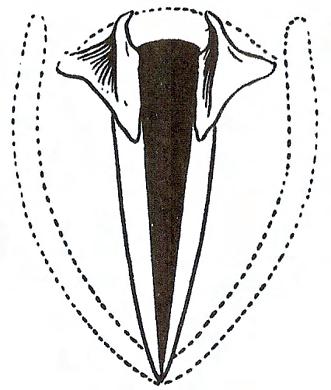
In terms of breathing, I find that the best combination is to blend intercostal and diaphragmatic muscle movement; this leads to the outward movement of the ‘floating’ lower ribs that are attached to the fixed ribs on the sternum. It is the sideways muscle movement that is critical – this can be felt by moving the muscles above the waistline out at the back and is best accessed through a two-beat breath, rather than a one-beat ‘upbeat’, where the music allows. This moves the diaphragm into a flatter position from its natural dome shape under the fixed ribs. With children, I ask them to place their hands on the sides of their lower torso and work on moving their hands outwards so their focus is on the idea that the breath is low and also that the airflow can be controlled through the abdominal muscles. This can be taught by using a counting exercise where the child feels the muscle tension as the breath is being used up. The diaphragm works within this group of abdominal muscles and cannot really be controlled as an individual muscle, so I avoid terms like ‘use your diaphragm’. Breathing through the mouth, ie not through the nose, is best, to assist with the raising of the soft pallet and the opening of the throat. The most important element is to develop a sostenuto that allows the child to shape long phrases and understand the structure of the music. For that reason I try to avoid staggering breath within the group as much as possible, so that this idea of sustaining whole phrases focuses their minds on breath ‘management’. In relation to onset, regular use of a ‘contact’ exercise, such as the one below, is important for the child to understand the physical process involved in the production of the sound. This focuses on the co-ordination of the breath to the start of the sound so that it can be controlled and not too explosive.
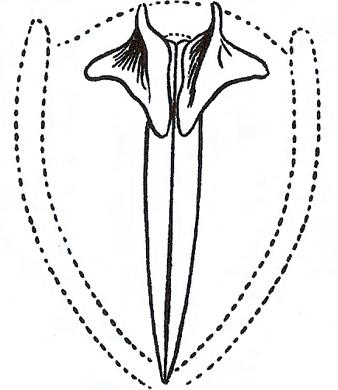
This is such a wide-ranging and detailed topic that it would be impossible to cover all aspects in one article, but what follows are some brief thoughts.
The Italian school approach is based on the ‘noble’ position which asks the singer to use an upright stance but with a feeling of relaxation. This should produce a straight spine and long neck (not stretched in an unnatural way but supporting the head), with the shoulders back and down, but not forcibly so. The arms should be held loosely at the sides, slightly away from the body. The singer should place his or her feet slightly apart, at around a 30-degree angle, toes pointing away from the body. The weight should be placed on the balls of the feet, not on the heels, and should be evenly distributed to achieve a feeling of balance. The idea is to create a stance that is relaxed and prepared for vocalisation, with a sensation of alignment from the head to the foot. It is best to avoid a static, unnatural posture like ‘standing to attention’. Standing too straight can lead to a rigid position, producing tension in the upper body that works against free vocal production, and it’s not a realistic position to keep children in, anyway! The legs also need to be flexible and not locked.
This links back to my earlier point on the individual sound, or what could be called the ‘laryngeal signature’ of the child. Vowel production is – of course – vital, and children should be taught how to produce vowels as cleanly and freely as possible within their natural core sound. I find tongue elevation for ‘Eh’ and ‘Ee’ vowels sometimes presents an issue and takes a while to embed. I hear lots of discussion about ‘high’ and ‘low’ vowel colours but I prefer ‘dark’ and ‘light’.
I support the idea of using ‘placement’ as a tool to allow the larynx and vocal folds to function efficiently. The famous singing teacher Giovanni Lamperti (1839-1910) advocated the pursuit of chiaroscuro or the ‘dark–light’ tone:
‘The pitch (vibration) of your voice seems to emanate from the back of the mouth (pharynx) spontaneously. The resonance of your voice seems to originate in the front of your mouth (lips) voluntarily. These two together seem to make the ‘dark–light’ tone.’
This is the balance that many singers seek between ‘space’ or ‘depth’ in the sound, and ‘brightness’ or ‘ping’. If the voice is too dark it becomes dull and woofy, if it is too bright it becomes nasal and shrill. The correct balance needs to be achieved in the resonating spaces and this can be taught through vowel colours. The larynx should feel relaxed and suspended throughout the singing process and the production of the vowel colours required by the music changes the resonance balance. As Lamperti notes, ‘When the whole range of your voice feels stationary and only resonance changes, you are a great singer’. This implies the equalisation of the registers and the unification of the voice into one whole unit that is perfectly even.

Regarding weight of sound and linking back to my first point about treating the child’s voice as a developing instrument, I sometimes worry about the amount of sound we expect from these very young singers. The young voice should not be put under too much pressure to produce a sustained forte dynamic for long periods and this can be regulated through choice of repertoire.

At St Peter’s School in York, where I am Director of Music, we continue with singing lessons for the boys throughout the change, and this works well overall as long as they sing within a comfortable range and avoid the extremities. Occasionally a very rapid growth spurt can necessitate stopping for a short period if the voice becomes unstable. Most boys are ‘sliders’ (as I describe them) and their voices change gradually over a few years until they finally settle into the adult voice. During this time the majority of our boy choristers take weekly singing lessons and make a valuable contribution to Chapel Choir. They also take grade examinations, doing very well, and this helps them to maintain their interest in singing. As their voices begin to change, our boys do not sing counter-tenor to help to maintain a top line. My personal opinion is to allow the changing voice to find a place in ‘modal’ register first rather than using falsetto as a stop gap to perpetuate treble singing, but I understand that it is not an easy decision when the child is desperate to continue and there are complicated services to negotiate.
As the father of a girl and a boy who have both been cathedral choristers, I am often asked if girls and boys should have a different or similar sound. My usual response is ‘That depends on the child concerned’, (cf my earlier point on individuality of sound). It could be argued that there is a physiological point where boys are nearing the point of change and their vocal folds are gaining mass that produces a different colour, but in my opinion that does not make it preferable or better than the sound made by a senior girl chorister. Girls can be trained to sound like boys and vice versa, but this is contrary to the whole issue of training each instrument on its own merits.
Although I have included a little physiology in this brief article, all choirmasters know that the psychology of singing is equally if not more important. We all find ways to connect with the children we teach and it is the understanding and
Paul Miles-Kingston was a chorister at Winchester Cathedral and later sang at Durham Cathedral as a bass choral scholar whilst reading Music at the university. Following his graduation, Paul was a songman at York Minster for four years before moving to Christ Church Oxford as a bass lay clerk for a further four years. He was appointed Director of Music at Christ Church Cathedral School in 2002 and became Assistant Director of Music at St Peter’s School, York in 2006. He has been Director of Music at St Peter’s since 2010. He was awarded an LRSM singing teaching diploma in 1999 and subsequently an MA by research at the University of York in 2009 for his dissertation ‘Training boys to sing’.

empathy that is developed between us and the children that allows them to sing confidently and to enjoy the whole process of singing, which is surely the most important aspect. Keeping a positive relationship going is the most productive way of developing their confidence and allowing their natural ability to thrive.
I have been fortunate to work with many gifted directors in my career and from them I have learnt that good conducting is a balance between technique and expression. Obviously the singers need to see a clear beat that allows the ensemble to be maintained, but equally important is the emotional connection between the director and the singers. I make a conscious effort to make direct facial contact with every child in my choir during the duration of a service, whether this be with an encouraging smile or a raised eyebrow to indicate that I have noted an error! Despite the need to exercise discipline and demand high standards, it is good practice to project an underlying warmth and enthusiasm. Communicating the essence of the music through body language can lead to some expansive gestures at times, but it does bring the best out of most teenagers. Rotating solos as much as possible is a good idea, as is finding opportunities to grow each individual voice. A voice might be particularly suited to a specific genre, for example, that allows one to showcase that sound and to build the confidence of the child involved. Keeping the repertoire varied and regularly refreshing the warm-up routine helps to ring the changes. The aim is to maintain the full involvement of every individual singer and this will hopefully help to promote and nurture their interest in singing over many years.
There are plenty of other avenues to explore! Space has not permitted the discussion of registers, or consonant production, or the development of the idea of using resonance spaces, for example, but there are only so many aspects one can cover within a short article.
Rotating solos as much as possible is a good idea, as is finding opportunities to grow each individual voice.1 Slater, Vocal Physiology and the Teaching of Singing, 18-19. The vocal folds in an enlarged view showing the folds in ‘rest’ position on the left and how they come together to produce sound on the right. Paul Miles-Kingston Photo: David Morris
Iwas recently looking into a copy of the National Chant Book 1848, edited by James Ingham (1813-1886). Interestingly, there were a few chants composed by a J F Lunn, according to the index in 1839. I delved into the archive and found several more young composers, but of very much more recent origin, as you will see below.
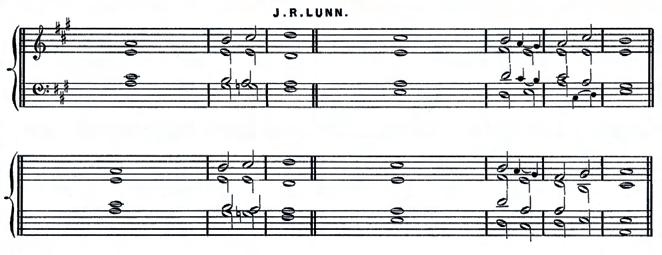
John Robert Lunn, later the Revd J R Lunn, was organist of St Bartholomew’s Church, Edgbaston and subsequently vicar of Marton cum Grafton from 1863-1899.

This chant was composed aged eight.



Harry sang in his local parish church choir in Hertfordshire from the age of nine and has been singing bass since he was 13. He started learning the piano when entered secondary school, and is currently learning to play the organ. His main musical focus is on composing orchestral film music, psalm chants and short choral motets.

A chorister at St Edmundsbury Cathedral under James Thomas and Dan Soper until 2015, Henry is currently a music scholar at Uppingham School in Rutland.
Jack became interested in English church music at a young age whilst a chorister at Wakefield Cathedral, and later, as a choral scholar at Wakefield before moving on to St Giles, Pontefract, where he was organ scholar. He is now reading Maths at Corpus Christi in Cambridge, where he is also a bass choral scholar.
Michael was a chorister at Exeter Cathedral under Andrew Millington from 2001-2006. Since leaving Exeter, Michael has enjoyed a varied musical life as a cellist and organist, and continues to perform regularly. He was organ scholar at St Hugh’s Oxford and is currently living in Cambridge, studying for a PhD in Engineering.
the confines of church and chapel to transform the choral standing of St John’s. Coupled with endless concerts all over the country (quite often to very ‘ordinary’ parish churches) and subsequently to the rest of the world, GG succeeded in his aim.
These words, from an anonymous writer of the 15th century, are quoted by George Guest in Chapter 11, ‘An approach to the Intangibles’, of his autobiography (A Guest at Cambridge, 1994). They are the last two lines of a text which he considered enshrined ‘all that goes to make a memorable performance of a piece of music and, in many ways, the last two lines are the most important of all’. They perhaps sum up his approach to choir training. In an interview in the USA in 1986 he said: “You’ve got to assume a certain basic technique, but there are many choirs that perhaps go too far in the business of technique and become timid in their interpretation.” The current boxed set of the re-mastered Argo recordings, some 42 discs, reveals a wealth of music performed by a developing choir from 1958 to 1981.
I first came across the St John’s choir in 1970, buying my first ever LP, now disc 9, of Haydn’s Maria Theresa Mass. The bold, vibrant sound, full of vitality, was a revelation to me. Recorded in 1965 it was the first of GG’s Haydn Masses in collaboration with Neville Marriner and the Academy of St Martin in the Fields. The choir recorded five of the six ‘Great Masses’ with the sixth, the Nelson, being recorded by ‘the choir down the road’. There can be no greater introduction to ‘the sound of St John’s’. This was, of course, at a time when the only other recordings of such music were from Austrian choirs and before the advent of groups such as the Monteverdi Choir.
The recordings stand up well to both the Gardiner and Hickox recordings of more recent years, and the six Masses were to make their way on LPs, via Prime Minister Edward Heath, to Rome as a gift to Pope Paul VI in 1972. GG’s plan was that with these recordings choral music would be taken outside
Much is often made of rivalry between John’s and King’s, but the sound of the two choirs was quite different. GG aimed for what has been termed the more ‘continental’ sound, as had George Malcolm at Westminster Cathedral, which GG determined was much more suited to the acoustics of St John’s chapel. His autobiography reveals some of his thinking behind this approach and the ways he achieved it. He compares the sound of King’s and Westminster as being ‘the difference between, in orchestral terms, a flute and an oboe’, and asks the reader to ‘consider the kind of sound which Palestrina or Victoria...had in mind’ and compare this with the sound English composers (GG suggests Wood, Stanford and Howells) might have encouraged. His view was that a chorister was ‘much more valuable [if he can] produce both kinds of sound’. CDs 4 (Howells, Bairstow, Ireland) and 5 (Walmisley, Goss, Wesley) offer us the ‘smoother and intimate’ style, while CD 42 (the last of the Argo recordings) shows us the ‘quasi-operatic and lyrical style’ in performances of Tallis (Missa Salve intemerata) and Sheppard (The Western Wynde Mass). GG’s other main concern was words. “What is the use of singing words at all if they are so distorted or mis-pronounced that they cannot be distinguished or understood by those listening?” If you play Britten’s Missa Brevis or A Ceremony of Carols on CD 8, you will be left in no doubt as to the texts, such is the wonderful articulation and phrasing of the lines.
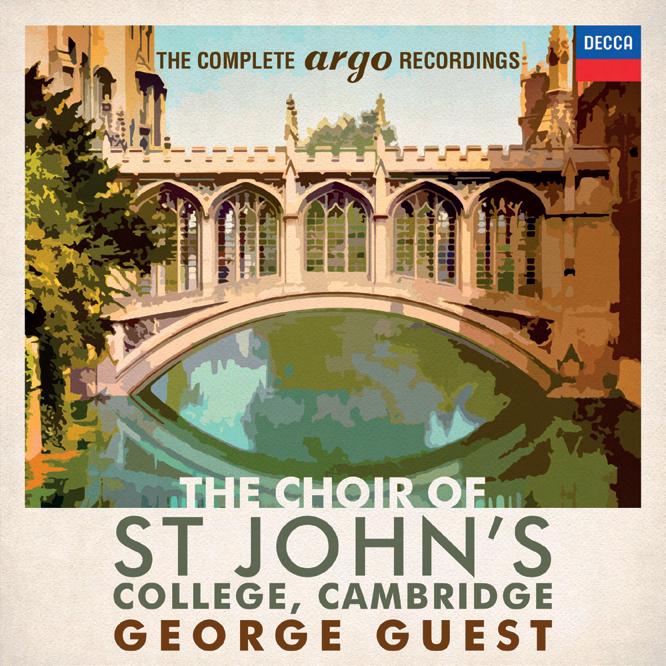
The choristers’ engagement with this music is quite extraordinary. A performance at the Sydney Opera House in 1978, to some 2700 people (with 2000 turned away!), apparently prompted a correspondent to the Sydney Morning Herald to suggest that ‘the opera authorities could perhaps employ someone like Dr Guest .... to train our opera singers. If little boys of nine or ten can be taught perfect diction, just what is wrong with our opera stars?’
Part of GG’s approach was of course to convey the meaning of the words, not just through good diction, but through the phrasing of the music and the expression of the emotions in the text. He said: “Texts of sacred music deal with the most profound mysteries and I do not believe it is right to sing, for example, the words of the Agnus Dei with a ‘stiff upper lip’ and always quietly – the generally preferred way of Anglican composers and Anglican choirs. To the Roman Catholic, however, the awe of the text seems to call for a more emotional approach.” CD 21 is the recording of Langlais’s Messe Solennelle which won praise from the composer himself, and we can clearly hear the result of the conductor’s approach.
Some of the music by Purcell, Scarlatti and Vivaldi may sound a little heavy to our ears today. That will not be as a result of the singing, but more the rather full and sustained sound of the string accompaniment (pre-period instruments). Accept that situation, and there is such fine singing in Purcell’s They that go down to the sea in ships (CD 7) with the superb extra depth of NZ bass-baritone Inia Te Wiata, and also in My beloved spake where the ‘the voice of the turtle’ is sheer beauty! Jehovah, quam multi is as good as I have heard it since. Having
The cry that to the ear of God doth dart Is cry, not of the throat, but of the heart.


mentioned a soloist, there are of course many others in the line-up GG employed who make invaluable contributions, not least (the very young) Simon Keenlyside and Robert King!




Mention must be made of the various organists who accompany this fine choir, who have been an additional legacy to our choral tradition. Brian Runnett’s playing in Britten’s two pieces Rejoice in the Lamb and Missa Brevis is full of rhythmic vitality and sensitivity towards the singers. It is good to hear Stephen Cleobury in the performances of the Langlais Mass and the Duruflé Requiem and John Scott in Flor Peeters’ Missa Festiva and a disc of ‘Psalms of consolation and hope’ (the first time I have heard Walford Davies’s chant for Psalm 121 accompanied). Other organists include Peter White, Jonathan Bielby, David Hill and Ian Shaw. Consider that legacy and add others who worked with GG: David Lumsden, Jonathan Rennert, Robert Huw Morgan, Adrian Lucas, Andrew Lumsden and Andrew Nethsingha, the current Director at the college!

There is far too much in this set to do more than touch on a few pieces, such is the wealth of music and standard of performances, but if you need an introduction to the ‘the Sound of St John’s’ under George Guest’s inspired leadership, listen to CD 4 for Howells’ Like as the hart and Tippett’s Evening Canticles, CD 8 for Britten, CD 10 for Monteverdi Masses, CD 11 for a complete Evensong (including an exhilarating performance of Vaughan Williams’s O clap your hands), CD 11 for some beautiful Warlock and Joubert, CD 42 for Tallis and Sheppard, and Haydn’s Theresa Mass (CD 9) or Paukenmesse (CD 20). Oh, and CD 30 for the Fauré Requiem – this disc was the one recording GG had to have on his desert island in his radio interview with Roy Plomley in 1976.
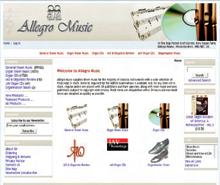

Nicholas Kerrison, originally from King’s Lynn in Norfolk, trained as an organist at the School of Music, Huddersfield and then as a teacher at Homerton College Cambridge. On qualifying he became Head of Music at The King’s School, Grantham, and Organist and Choirmaster at the town’s St Wulfram’s Church. In 1988 he was appointed Director of Music at The King’s School, Peterborough where he stayed for 26 years, gradually building GCSE and A level student numbers to some of the highest in the country. During his time in Peterborough Nicholas was involved in singing as a lay clerk at the cathedral and sometimes accompanying the cathedral choir led by Christopher Gower. Taking early retirement from teaching in 2014, Nicholas is now Organist at the Anglican Shrine of Our Lady in Walsingham, Norfolk.
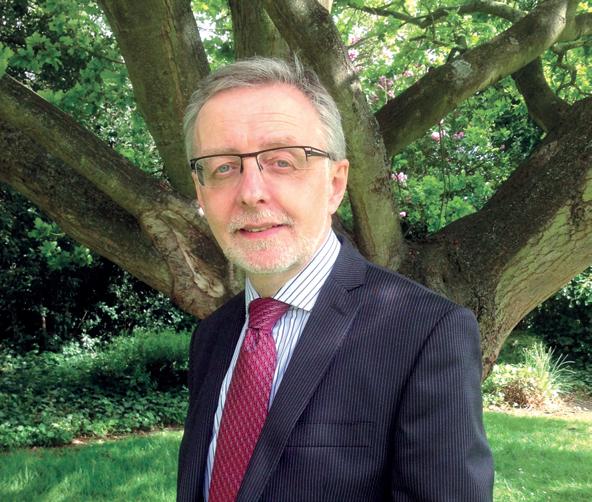
It’s a common myth that only the rich and famous leave money to charity when they die. The reality is that without gifts left in wills by people ‘like you and me’, many of the charities we know and support today wouldn’t be able to exist. Thankfully, 74% of the UK population support charities, and a good number say they’d happily leave a gift in their will once family and friends have been provided for.
The problem is that ‘the way to hell is paved with good intentions’, and most people do not leave any money to charity in their wills. Are you one of these? And if so, did you know that a reduced rate of inheritance tax (IHT), 36% instead of 40%, is applied to estates leaving 10% or more of their total to charity? This means, in essence, that on an estate worth, for example, £500,000, instead of paying IHT of £70,000, the tax would be £56,700. 10% of the estate – once the nil band of tax is removed – would be £17,500, which you could leave to the charity or charities of your choice, and the reduction in funds payable to family and friends would be only £4200.
Without a charitable bequest
If you consider that most charities would not survive without legacies, that a reduced rate of IHT will apply to your estate if you give 10% of it to charity, and that you are ensuring the vital work of your chosen charity can continue, it makes very good sense to donate 10% to charity in your will. The icing on the cake is that the taxman gets a lot less of your hard-earned cash than would be the case if you were to leave a smaller percentage.
If you have already made a will, as many if not most of us have, it’s still quite easy to change or add to it by writing a codicil. Sometimes it’s simpler to make a new will, and you’d do well to speak to a solicitor, but the benefits to whatever charity you choose to support (which clearly we hope will be FCM) will be worth the extra effort this requires.
Example:
With a 10% charitable bequest
nil rate
including nil rate band
receives £56,700 instead of £70,000, and beneficiaries receive only £4200 less
A Pecuniary Gift
I give the sum of £ _____________ (in figures and words) to the Friends of Cathedral Music (FCM) (registered charity No. 285121). I direct that the receipt of the Treasurer of FCM shall be a sufficient discharge to my executors.
A Residuary Gift
I give the whole (or a _____% share) of the residue of my estate to the Friends of Cathedral Music (registered charity No. 285121). I direct that the receipt of the Treasurer of FCM shall be a sufficient discharge to my executors.
Please remember Friends of Cathedral Music in your will and help us to secure our priceless heritage for future generations

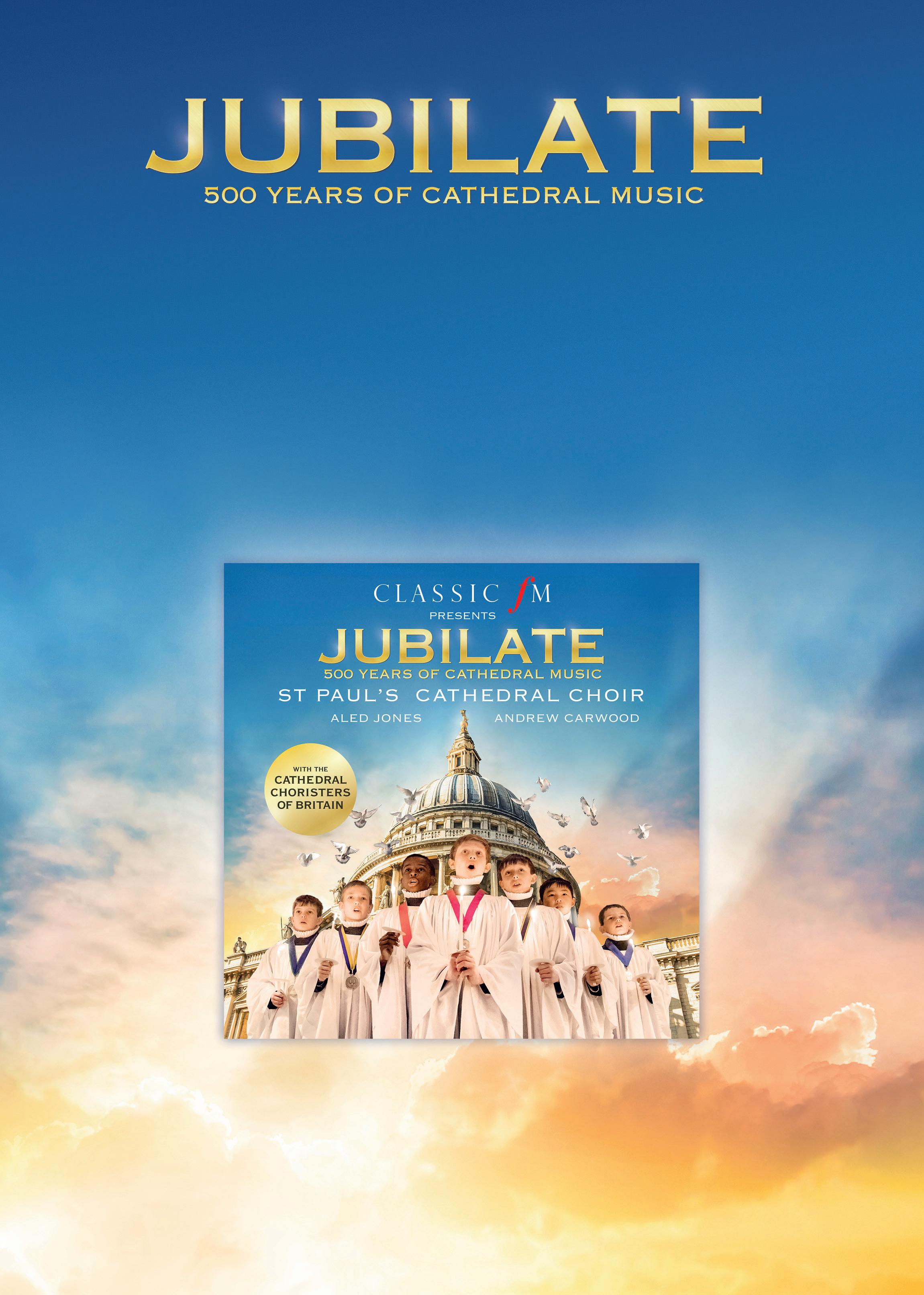
The Sixteen
Dir: Harry Christophers
Lauridsen O magnum mysterium; Skempton Adam lay ybounden; Trad The Saviour’s work; A Gallery Carol; G Jackson The Christ-child; Warlock Bethlehem Down; Will Todd My Lord has come; Ireland The Holy Boy; Walford Davies O little town of Bethlehem; Gardner When Christ was born of Mary free; McDowall Now may we singen; Trad Children’s Song of the Nativity; Ord Adam lay ybounden; Roth Song of the Shepherds; Trad This endris night; Rutter There is a flower; Trad Christmas Eve; Bullard And all the stars looked down; Trad Dutch Carol; MacMillan O radiant dawn
CORO 16146 TT 73:58
This excellent disc contains a collection of extremely contrasting carols beautifully performed by The Sixteen. The group has a clear insight into the stylistic diversity required between the well-known traditional carol and the far more complex 20th-century writing by composers such as Lauridsen, Gabriel Jackson and James Macmillan. What is so impressive is the blend and relaxed tempi achieved so effortlessly in the slower pieces, notably Lauridsen’s O magnum mysterium, where a sense of timelessness permeates the whole work. Even Walford Davies’s relatively straightforward setting of O little town of Bethlehem is unhurried and the melodic line is enhanced by superbly controlled and shaped phrasing. The CD boasts the Classic FM logo, but never is there a feeling that the performers compromise their distinctive and highly polished style for a disc which some might expect to be Muzak. Many of the tracks are very subdued, possessing an unhurried quality very appropriate for the Advent season.
David Thorne
Choir of Selwyn College, Cambridge
Dir: Sarah MacDonald
Organ: Shanna Hart/Ben Comeau
Arr Willcocks Once in Royal David’s city; See amid the winter’s snow; O come, all ye faithful; Hark! the herald angels sing; arr Wilberg Ding! dong! merrily on high; arr Webber Stille Nacht; arr Carol Barnett Angelus ad virginem; Head The Little Road to Bethlehem; arr MacDonald Rudolph the red-nosed reindeer; Huron Carol; Santa Claus is coming to town; White Christmas; arr Rutter Wexford Carol; arr Whitehead The Seven Joys of Mary; arr Higginbottom Rocking; arr Moore Away in a manger; In dulci jubilo; Mathias Wassail Carol; Causton Cradle Song; arr Stopford We three kings; Walford Davies O Little Town of Bethlehem
REGENT REGCD 464 TT 76:03
This is wonderfully well sung, accompanied and recorded, and it is therefore well worth buying. One cannot, of course, hope to like or enjoy every item in such an anthology, and I recall first detesting Rocking when I was about eight years old; ‘Darling, darling little man’ – ugh! The offer that ‘We will lend a coat of fur’ seems nowadays to invite protest or
retribution, but maybe no one reads the words at Christmas! However, I was delighted and cheered by the inclusion of Mack Wilberg’s riotous version of Ding! dong! merrily on high, Michael Head’s arrangement of his solo song The Little Road to Bethlehem, Mathias’s Wassail Carol, and the Walford Davies tune to O Little Town of Bethlehem, a gentle and wistful melody which we hear all too seldom these days. I would give special mention to Rutter’s Wexford Carol, an Irish melody of great charm arranged with his customary skill; but the absolute show-stopper was Philip Moore’s In dulci jubilo, imbued with the spirit of Bach but in style very much of the here and now, and which seems increasingly to enfold the listener in a joyous, swinging momentum. I have been playing it frequently to anyone who would listen. Get your choir some copies from Encore Publications and make them sing it this Christmas if that’s not too soon! Alas, I definitely did not like the inclusion, or intrusion, of the three secular Christmas ditties, cleverly though they were arranged. Rudolf, Santa and Bing should have been grouped together right at the end, so that the listener could switch off early and preserve the mood of the remainder of an otherwise admirably chosen programme.
Timothy StoreyChoir of New College, Oxford
Dir: Robert Quinney
Arr Quinney O come, O come, Emmanuel; Sing lullaby; Hammerschmidt Machet die Tore weit; arr Pettman The angel Gabriel; Guerrero Ave virgo sanctissima; arr Gauntlett Once in royal David’s city; Pott Balulalow; Praetorius In dulci jubilo; Ives
A Christmas Carol; arr Vaughan Williams O little town of Bethlehem; Mathias A babe is born; arr Willcocks O come, all ye faithful; Of the Father’s heart begotten; Warlock Bethlehem Down; Victoria O magnum mysterium; Rodney Bennett In the bleak midwinter; Martin Nowell sing we.
NOVUM NCR 1390 TT 59:05



This recent CD confirms that the singing and choral blend of the choir of New College Oxford remain at an exceptionally high level. The balance of familiar and unfamiliar repertoire is also well judged, and the accompanying notes guide us carefully through the selection. Setting aside the hymns, The Angel Gabriel and Bethlehem Down are amongst the betterknown carols, whilst works by Hammerschmidt, Guerrero, Praetorius and Victoria bring us music from the 16th and early 17th centuries, which rarely feature in carol services. More recent works include a surprisingly traditional work by a young Charles Ives, and a fine rhythmic setting of A babe is born by William Mathias. More contemporary items include Balulalow by Francis Pott and In the bleak winter by Richard Rodney Bennett. Their distinctive originality is made very approachable by the delightful sensitivity of the New College choir under its director Robert Quinney, who contributes two of his own arrangements to the disc. As Robert was a former organ scholar of Kings College Cambridge, it comes as no surprise that he also includes two glorious arrangements by David Willcocks.


There is a fairly strong Advent flavour about this selection, which prepares us for Christmas – and may explain The Angel Gabriel being taken at a rather slow speed However, the joy of Christmas is there as well, especially in Matthew Martin’s rousing Nowell sing we! which brings the recording to a very exciting conclusion. It allows the choir and the organist Timothy Wakerell, who accompanies the singers so well, to end on a really festive note. This most enjoyable CD is thoroughly recommended.
Paul MorganWorcester Cathedral Choir
Worcester Festival Choral Society
Dir: Peter Nardone
Organ: Christopher Allsopp
All arranged by David Willcocks: O come, all ye faithful; Sussex Carol; God rest you merry, gentlemen; Ding! dong! merrily on high; Whence is that goodly fragrance flowing; Angelus ad virginem; Once in royal David’s city; The Infant King; Gabriel’s message; Unto us is born a son; The Cherry Tree Carol; Rocking; While shepherds watched; Tomorrow shall be my dancing day; Infant holy, infant lowly; It came upon the midnight clear; Away in a manger; I saw three ships; The first Nowell; Resonemus laudibus; O come, O come, Emmanuel; Deck the hall; Hark! the herald angels sing.
REGENT REGCD 486 TT 74:22
This compilation of hymn and carol arrangements from Worcester Cathedral was recorded as a tribute to Sir David Willcocks. In the liner notes, Jonathan Willcocks writes warmly of his father’s affection for the cathedral whilst organist there between 1950 and 1957. Willcocks’ choral style reflects a view held by many that an arrangement or descant should enhance rather than detract from the original melody. The disc consists mostly of the many hymn and carol arrangements composed for the annual Festival of Nine Lessons and Carols held at King’s. From the arresting fanfare composed for O come all ye faithful to the final chord of Hark! the Herald Angels sing, the innate musicality of Willcocks’ consummate writing is very evident, ranging from the naïve purity of the solo treble voice to the highly complex effective texture of arrangements for double choir. The occasional colourful and independent organ part adds even more character to the text. This disc is a delight not only in its own right, but serves as recognition of Sir David a master of the genre of choral arranging. Many congratulations to Peter Nardone for splendid direction of the particularly diverse forces required to make this disc such a welcome addition to the catalogue.
 David Thorne
David Thorne
Dir: Andrew Nethsingha
Organ: Joseph Wicks
Chilcott The Shepherd’s Carol; arr Walford Davies The holly and the ivy; Mathias Sir Christèmas; McDowall O Oriens; Ord Adam lay ybounden; Ledger A spotless rose; Whitehead The seven joys of Mary; Rutter Dormi Jesu; arr John Scott Creator of the stars of night; Rütti I wonder as I wonder; Walford Davies O little town of Bethlehem; arr Simon Preston I saw three ships; Cornelius Three Kings; arr Charles Wood Ding! dong! merrily on high; Warlock As dew in Aprylle; Finnissy John the Baptist; Andrew Carter Mary’s magnificat; arr Marchbank People, look east; arr Blatchly Silent night; Anthony Milner Out of your sleep arise; Poston Jesus Christ, the apple tree; Gardner Tomorrow shall be my dancing day.
SIGNUM SIGCD 458 TT 66:45
The Choir of St John’s College Cambridge (SJCC) isn’t in residence at Christmas, so this CD gives the listener a glimpse
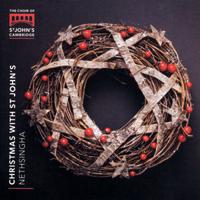
of what might be sung if it were, and one rather wishes that it might be, and broadcasting as well! The compilation is a brilliant sequence of the familiar and the less so; surely the latter will become well known as a result of performances as persuasive as these.
Under the inspired direction of Andrew Nethsingha, the musicians give well nigh blemish-free interpretations. The balances within the choir are superbly judged, and as has been the way with SJCC under every director, the boys and the men are allowed – nay, encouraged – to sing; there is no holding back, but it is always in the service of the music and never gets out of hand! There is vigour a-plenty and tenderness, and everything in between. There is unalloyed joy in the singing: listen to William Whitehead’s arrangement of The Seven Joys of Mary, Peter Tranchell’s People look East and Simon Preston’s arrangement of I Saw Three Ships. I could itemise each track –there is so much to enjoy – but the best thing is for you to go out and purchase this CD for yourselves! The recording itself is first-class: wonderful, spirited organ playing from Joseph Wicks, now translated to Truro as Assistant, and beautifully captured by Signum.
Roger JuddChoir of the Chapel Royal
Dir: Huw Williams
Organ: Martyn Noble
Arr Rutter Sans Day carol; arr Sargent
Mary had a baby; De Virgin Mary; Poston
Jesus Christ the apple tree; arr Willcocks Once in royal David’s City; Sussex Carol; I saw three ships; Adeste fideles; Hark the herald angels sing!; Tavener The Lamb; arr A. Carter A maiden most gentle; A Spanish Carol; Weelkes Hosanna to the Son of David; Dove The Three Kings; arr Guest Suo Gân; Mendelssohn When Jesus our Lord; Head The little road to Bethlehem; arr Wood Ding! dong! merrily on high; Britten A New Year Carol; Popplewell Blessed Jesu, here we stand; Stravinsky Ave Maria; Cornelius Three Kings from Persian lands afar; Gardner The holly and the ivy; Howells A spotless rose; arr Gant We wish you a merry Christmas.
SIGNUM SIGCD 460 TT 72:19



This is a feast of no fewer than 26 carols, the majority of which are well known. Three famous descants by David Willcocks are included, as well as his memorable arrangements of The Sussex Carol and I saw three ships. Other popular items include John Rutter’s Sans Day Carol, Michael Head’s The little road to Bethlehem and A spotless rose by Herbert Howells Less wellknown items, such as Jonathan Dove’s The Three Kings and Igor Stravinsky’s Ave Maria, contrast well with the more lighthearted pieces, such as the two arrangements by Malcolm Sargent and Andrew Carter’s A Spanish Carol. The inclusion of Hosanna to the Son of David by Thomas Weelkes and There shall a star from Jacob come forth by Mendelssohn add further variety to the programme. The programme notes give detailed and interesting information about the carols.
The boy choristers, under the very capable direction of Huw Williams (Director of Music), sing with real skill and enthusiasm, as can be heard in their captivating performance of Britten’s New Year Carol. Unfortunately, here and there, one is aware of small lapses in the blend of the lower voices. Excellent support for all the accompanied items is provided by the sub-organist, Martyn Noble.
It is particularly appropriate to hear pieces by former organists of the Chapel Royal. Richard Popplewell (organist there from 1979 to 2000) composed Blessed Jesu! Here we stand for the baptism of Prince William in 1982. The recording ends with a very jolly arrangement of We wish you a merry Christmas by Andrew Gant (organist 2000-2013) which incorporates other carol tunes to bring the CD to a joyous finale.
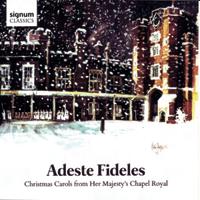 Paul Morgan
Paul Morgan
Symphony No. 2
Trans: David Briggs
Soloists: Julia Morson (Sop) Christina
Stelmacovich (Mezzo)
City of Birmingham Choir & Renaissance
Singers
Organ: David Briggs

Cond: Christopher Robinson Allegro maestoso; Andante moderato; In ruhig fliessender Bewegung; Urlicht, sehr feierlich, aber schlicht; Im tempo des scherzos. CHESTNUT MUSIC CD 012 (2 discs)
The ability of David Briggs to transcribe large orchestral works for organ is legendary and his playing of them is quite superb. This recent transcription is of Mahler’s Symphony No. 2 ‘Resurrection’, which was commissioned by the Cathedral Church of St John the Divine, New York and premiered there in 2013. This is the first recording of the work which was made last year in Blackburn Cathedral with David Briggs on the organ and Christopher Robinson conducting the City of Birmingham Choir & Renaissance Singers. Only two of the five movements involve singers. The fourth movement includes a song for alto voice, and the final movement has parts for soprano and alto soloists and chorus; the chorus sings for just the last 15 minutes of this 90-minute work. The recording quality of this disc is outstanding, with the organ sounding particularly grand, partly due to copious use being made of its three 32-foot stops. The chorus and soprano soloist sing very well, although I didn’t find the alto soloist quite so convincing.
David Briggs is a keen advocate of organ transcriptions (see article on p20) and many recitalists are including them in their programmes. Whilst I think they can work well and make a programme very attractive, I personally find it difficult to listen to a particularly long work such as Mahler Two in an organ arrangement, partly because the organ and organist can only capture the glorious orchestral detail of such a work in a restricted way. Nevertheless, I greatly admire the organ playing and transcriptions of David Briggs; no one does it better!
Paul MorganDaniel Cook at Westminster Abbey Walton Coronation March; Bach Air on the G string; Toccata & Fugue in F BWV540; Cocker Tuba Tune; Whitlock Fantasie Choral No. 1; Dupré Prélude et Fugue in B major; Vierne Carillon de Westminster; Coates London Suite (Westminster); Grainger Handel in the Strand; Elgar Pomp and Circumstance No. 1
PRIORY PRCD 1175
This programme’s title leads one to expect the very worst, and Mr Cook must have had to play much of this music all too frequently at special services in the Abbey. He deserves the greatest credit for having managed to include some genuine organ music amid the arrangements of Coates, Elgar, Grainger and Walton. One should make particular mention of Bach’s Toccata in F (the one with the lengthy pedal solo) followed and complemented by its very fine, if rather dour, fugue; but Dupré and Whitlock were equally welcome. Cocker’s Tuba Tune and Vierne’s take on the mis-remembered chimes of what we are not allowed to call Big Ben are both good clean (if somewhat hackneyed) fun, and (again I say) have the merit of being proper organ music. It scarcely needs to be
added that both playing and recording are of the very highest standard, and it is my pleasure to recommend yet another fine CD from Mr Cook and to congratulate him most warmly on his appointment as Organist of Durham Cathedral.
 Timothy Storey
Timothy Storey
Organ of Trinity College, Cambridge Iain Quinn
Mozart Adagio and allegro in F; Andante in F; Fantasia in F min; Beethoven Adagio in F major; Scherzo in F major; Allegro in G major; Fugue in D major; Prelude through all the major keys, Op. 39 Nos. 1 & 2; Allegro no più molto in C major; Allegretto; Hummel Prelude and Fugue in C min; Ricercare in E min; Un poco Andante in A flat major; Fugue in E flat.
REGENT REGCD 476 TT 79:01




Iain Quinn presents an intriguing sequence of music by Mozart, Hummel and Beethoven. Most of the music was written not for the organ but for mechanical devices in clocks that included organ pipes – mostly, one imagines, very short ones. The Mozart pieces, K 594, 608 and 616, are the most substantial music on the disc. We know from his letters that Mozart found the exercise of composing this music almost total drudgery, and he wished for a ‘proper’ organ. The sleeve notes do not divulge which arrangements Quinn uses.
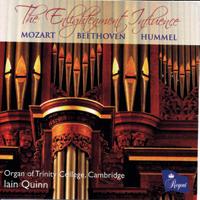
The Beethoven pieces include the two Preludes through all the major keys, and they, especially the first one, are extraordinary exercises. Otherwise, these pieces are nothing exceptional. The six pieces by Hummel are more interesting in that the composer lets himself go, harmonically speaking, with the use of quite daring chromaticisms.
Quinn has recorded this repertoire on the Metzler organ at Trinity College Cambridge, and the disc gives the listener a splendid opportunity to hear many of the very beautiful quieter sounds of this most characterful instrument. Quinn’s playing is safe rather than exciting, and Gary Cole (Regent) has presented the organ perfectly, which we’ve grown accustomed to with his recordings. This CD is an interesting exercise exploring a curious phenomenon.
Roger JuddChristopher Herrick World Tour
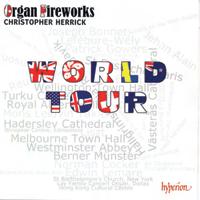
David Johnson Trumpet Tune in D; Lemare Concert Fantasia; Bossi Pièce héroïque in D minor; Lefébure-Wély Sortie in E flat; Alain Litanies; Cocker Tuba Tune; Reubke Sonata on the 94th Psalm (Fugue); Liszt Prelude and Fugue on BACH; Gowers An Occasional Trumpet Voluntary; Bonnet Matin provençal; Takle Fesetmusikk; Eben Hommage à Buxtehude; Weitz Grand Chœur ‘Benedicamus Domino’; Verdi arr Lemare/Herrick Grand March from ‘Aïda’.
HYPERION CDA 68214 TT 76:44
Christopher Herrick began his career in 1967 as Assistant Organist at St Paul’s Cathedral. He joined the music staff of Westminster Abbey, becoming its Sub-Organist between 1979 and 1984, after which he was able to embark on a freelance career which took him around the world as a recitalist. 1984 was also the year when he built up a good friendship with the founder of Hyperion records, Ted Perry, who, as Herrick admits, was loath to stop production of the vinyl disc but nevertheless was ready to be at the vanguard of CD production. In fact, the first of the ‘Organ Fireworks’ series was recorded in a single session in Westminster Abbey and issued on vinyl before being transferred to CD.
This compilation disc, consisting of recordings made over a period of 26 years, features one example of each of the organs in the series recorded in countries as far afield as Australia and Hong Kong. His formidable technique is unquestionable, although some aficionados may prefer to hear some of the pieces played on more authentic instruments. The comprehensive liner notes give not only the specification of each organ, but subtly incorporate the complete listing for each of the discs in the series. Highly recommended for organists and non-organists alike.
David Thorne




Dir: Paul Spicer
O praise God in his holiness; O Lorde, the maker of al thing; There is no rose; Incantation; Pilgrimage Song; Three Portraits; Be not afeard; Sonnet Op 123; This is the gate of the Lord; Autumn rain; South of the Line. SOMM RECORDINGS SOMM CD 0166
John Joubert was born in Cape Town and whilst at school came under the influence of its musical director, Claude Brown, with whom Joubert studied the large-scale Elgar choral works and the idiom of the Anglican choral tradition. Although educated in South Africa, he was awarded a PRS Scholarship to the Royal Academy of Music. He graduated from Durham University in 1950 and in the same year was appointed to the University of Hull where he wrote a number of the well-known choral miniatures which have become so familiar to most church musicians. Joubert is 90 this year (see article on p7), and over the decades has composed a number of works for a multitude of diverse instrumental resources ranging from chamber to symphonic music. A majority of music on this disc features settings of texts by poets including Yeats, Swinburne and Hardy, whose extended and very antiwar poem South of the Line provides the title of the disc. Joubert’s music speaks with a unique voice, reflected very much in the excellent performances on this recording. The often tense angular melodic lines and harmonic dissonances add greatly to the dramatic character of the texts. Whilst for instance, the contrast and accessibility of Three Portraits is more lightweight, the setting of Hardy’s South of the Line is highly profound, with the use of two pianos and percussion aggressively reflecting the horror of war. This disc justifiably pays tribute to a composer who has not always received the accolade he deserves.
David Thorne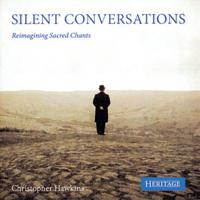
Christopher Hawkins (piano)
David Milson (violin)
Liz Hanks (cello)
Chants by Philip Armes, Attwood, Havergal, Naylor, Turle, Wesley, Goss, Hildegard von Bingen and others.
HERITAGE HTGCD 193
This is rather like Hamlet without the Prince of Denmark. Chants, with two exceptions Anglican rather than Gregorian, are dressed up in improvisatory musings intended to reflect the kind of psalm for which they might be suitable. Not a single syllable is actually sung! Lovers of Anglican chant may
find that this programme offers some entertainment as a rather esoteric exercise in ‘Spot the Tune’, but I can see no worth in it otherwise, admirably though it is executed.
Timothy StoreySansara
Cardoso Introitus; Byrd Emendemus in melius; Memento homo; Gombert Lugebat David Absalon; Bach Wie sich ein Vat’r erbarmet; Leit uns mit deiner rechten Hand; Mauersberger Wie liegt die Stadt so wüst; Rheinberger Abendlied; Holst Nunc dimittis; Frances-Hoad O come, let us sing unto the Lord; G Jackson Our flags are wafting in hope and grief; Galvani Tantum ergo; Archer Cloths of Heaven; Oliver Tarney A Prayer of St Richard of Chichester; MacMillan Lux aeterna.
CONVIVIUM CR 037 TT 66:00
Sansara is an acclaimed choral group of young professional singers. Formed in 2013, it won the London International A Cappella Choir competition two years later. This is their first CD, the music of which ranges from Gombert (c1495-1560) to the present day. The overall scheme is darkness to light, although much of the music is fairly slow-moving and reflective in character. This isn’t really surprising as a majority of settings are for the Requiem Mass, Ash Wednesday, David’s mourning for his son Absalom, and the Lamentations of Jeremiah. Unusually, the conducting of the group is shared amongst four of the singers. Two works are by associate composers of the choir, Marco Galvani and Oliver Tarney. Both works have effective energy and are given fine performances.
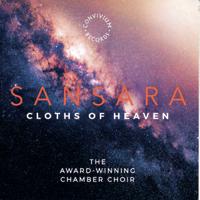
Certainly the singing is of a high standard, with attention being focused on realising the full character of the music. It is good to have such a range of styles, from Byrd and Bach through Rheinberger and Holst to six modern settings. Along the way there is a fine performance of Mauersberger’s Wie liegt die Stadt so wüst, composed in 1945 after the Allied bombing of Dresden. I also enjoyed the setting of Cloths of Heaven, which was specially composed by Malcolm Archer for this recording. However, I found the setting O come let us sing unto the Lord by Cheryl Frances-Hoad on the dark side, the last chord being one of the few joyful sounds. The choral writing of MacMillan’s Lux Aeterna was certainly beautiful, although it seemed strange to end the CD’s ‘darkness to light’ theme on a minor chord. That said, this is a very worthwhile collection of a cappella choral writing.
Paul Morgan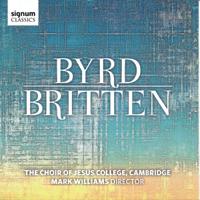
Choir of Jesus College, Cambridge
Dir: Mark Williams
Organ: Bertie Baigent/Jordan Wong Byrd O Lord, make Thy servant Elizabeth our Queen; Nunc dimittis; Ave verum corpus; Laudibus in sanctis; Praise our Lord, all ye gentiles; The Queen’s Alman; Quomodo cantabimus; Britten A Hymn of St Columba; Jubilate Deo; Hymn to St Peter; Antiphon; Missa Brevis (Kyrie, Gloria, Sanctus, Benedictus & Agnus Dei); Te Deum in C.
SIGNUM SIGCD 481 TT 67:09
This is a pleasing disc, if perhaps a somewhat curious pairing of 16th-century Byrd and 20th-century Britten. The college choir sings most of the Byrd items, whilst much of the Britten is sung by the boys and men of the chapel choir. The college choir are convincing in their accuracy and attention to detail. There is good balance and homogeny in the singing, although sometimes it seems a little bass-heavy. The soprano sound is very cool and light, with excellent tuning. In truth, the top-line sound of the college and chapel
choirs are not particularly distinct from each other, and the combined items demonstrate the strength of them both.
The chapel choir also exhibit great clarity and proficiency. Consonants are tight and the ensemble is firm and rhythmic at all times; there is an energetic commitment to the works. The boys’ sound, which is very pleasant, can sometimes be swamped in full unison passages, but the Missa Brevis affords an opportunity to hear them at full strength. It’s a bright, light and ‘covered’ sound with a slightly breathy halo but with plenty in reserve for focused fortes. This recording of the Missa Brevis is as good as any I know.
The organ-playing is particularly solid and colourful throughout; the 2007 Kuhn seems quite at home with the bright clarity demanded by Britten’s music, and the Sutton organ works well for The Queen’s Alman by Byrd.
The sound production is excellent; a warm and immersive image and the presentation of the CD is of the usual Signum standard.
George RichfordChoir of York Minster
Dir: Robert Sharpe
Byrd Vide, Domine, afflictionem; Ne irascaris; Praise our Lord, all ye gentiles; O Lord, make thy servant, Elizabeth; Tribulationes civitatum; Mundy Evening Service ‘in medio chori’; Tallis O salutaris hostia; O sacrum convivium; In manus tuas; Videte miraculum; Gibbons Glorious and powerful God; Great Lord of Lords; O God, the King of glory.
REGENT REGCD 488 TT 71:09



This highly enterprising and ambitious disc from York Minster covers music of the Tudor and early Stuart periods. Robert Sharpe’s choice of repertoire is particularly refreshing as it covers some territory rarely recorded by cathedral choirs. For some of the time, it features the combined sound of both the boys and girls. The confident and bright resonance of the upper voices is very apparent on the first track, Byrd’s Vide, Domine and captures most effectively Byrd’s predominantly linear writing. The highly emotional Ne irascaris is most poignant in its sensitive and well-controlled performance. John Mundy’s relatively unknown Magnificat and Nunc Dimittis are performed with vigour. The setting stretches the choir to the full and requires large resources and the ambient acoustic of the Minster. The generally thick homophonic writing and high-lying treble and alto lines is alleviated by sections of less dense writing. The top part especially reveals a most assured technique. The more restrained pieces by Tallis are performed with sensitivity, and the soloists in the Gibbons verse anthems are excellent. I particularly enjoyed not only the singing in Great Lord of Lords but the rhythmic organ playing of David Pipe. This disc is a significant addition to the catalogue, and the Minster choir should be congratulated on performing music so often heard only by professional groups.
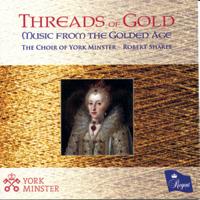 David Thorne
David Thorne
The Sixteen
Dir: Harry Christophers
Salve Regina; Quatre motets pour un temps de pénitence; Litanies à la vierge noire; Quatre motets pour le temps de Noël; Un soir de neige; Ave verum corpus; Mass in G. CORO COR 16149 TT 64:39
The Sixteen under their conductor Harry Christophers have produced a really outstanding recording of choral music by Poulenc. Although their singing is always magnificent, I felt a special affinity between conductor and composer in the sensitivity and beauty of timbre throughout the performances.
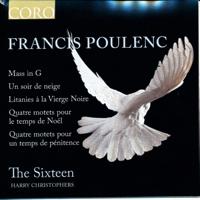
The earliest work, composed in 1936, is Litanies à la vierge noire. It marks Poulenc’s return to the Catholic faith after a pilgrimage to the shrine of the Vierge Noire at Rocamadour following the death of a dear friend. This work is for upper voices, and the only work with organ accompaniment on this CD. The anguish and beauty as expressed in Poulenc’s original and distinctive style is inspirational. The Mass in G, composed in 1938, was his next religious work. Here, the combination of beautiful singing, fine acoustics (the recording was made in Holborn’s church of St Alban the Martyr) and excellent recording quality produces a real gem, with the control of the high soprano line in the serene Agnus Dei deserving special mention.
The Quatre motets pour un temps de penitence were composed soon after the Mass in G. Frequent mood changes feature here, very expressively captured by the choir. Composed around 1951, the wonderful motets, each with a memorable and distinctive quality, have become very popular and are sung by many of our cathedral choirs around Christmas. They receive excellent performances on this recording. Less well known is Un soir de neige, a group of four secular pieces composed in 1944 which reflect on the peace and harshness of winter. Also featured are two motets, the well-known Salve Regina dating from 1941 and the less familiar Ave verum corpus for upper voices dating from 1952. A gem of a CD!
Paul MorganChoir of Liverpool Cathedral

Dirs: David Poulter, Ian Tracey, Daniel Bishop Byrd Vigilate; Daniel Rouwkema A Celtic Prayer; Darke O gladsome light; Brahms How lovely is thy dwelling place; Bairstow If the Lord had not helped me; Gibbons This is the record of John; Purcell Thou knowest, Lord; Hear my prayer, O Lord; Rejoice in the Lord alway; Finzi, Lo, the full, final sacrifice; Parsons Ave Maria; Eccard When to the Temple Mary went; Howells Nunc dimittis; Stopford Do not be afraid; Sumsion They that go down to the sea in ships.
PRIORY PRCD 1172
What is an anthem, and what indeed is a great anthem? Howells’ Latin Nunc Dimittis might just be useful as an anthem at Candlemas, but it sure ain’t no anthem! Lo, the full, final sacrifice is cantata rather than anthem, and is becoming rather hackneyed in choral anthologies. Greatness is hardly achieved by the home-made and homespun Celtic Prayer, a setting of that curious text ’May the road rise to meet you’ (ouch! I’ve been hit by a lump of tarmac!), nor can one take seriously Mr Stopford’s version of Do not be afraid, a favourite of Roman Catholic hymn-books, which contains such curiosities as ‘When you dwell in the exile of the stranger’ and ‘When the fear of loneliness is looming’, a line which for its full effect seems to demand the vocal and histrionic talents of the late Kenneth Williams. Purists would exclude Vigilate as not being an anthem at all, having been composed for clandestine performance by a handful of Roman Catholics; but the 20th century has been glad to lay claim to such great and colourful music and willingly to include it in the mainstream cathedral repertory. It receives a robust and committed performance, light years away from the historically informed sound-world of The Cardinall’s Musick, and one can rejoice with the Liverpool tenors in their uninhibited enjoyment of the music, the inclusion of which in the programme pays a fitting tribute to the cathedral’s involvement in the Byrd revival of the 1920s. The Sumsion anthem at the other end of the disc is of course highly apt to be sung in the cathedral church of a great maritime city.
Despite indulging in my usual mixture of pedantry and frivolity, I have nothing but praise for the performances,
which are full of vitality and enthusiasm, and there most certainly are some great anthems here, most notably those of Bairstow, Darke, Gibbons and Purcell.
Timothy StoreyChoir of Birmingham Cathedral
Dir: Marcus Huxley
Organ: David Hardie
Weelkes Hosanna to the Son of David; Taverner Dum transisset Sabbatum; arr Nicholson Ding! dong! merrily on high; Davies The souls of the righteous; arr Huxley
When I survey the wondrous cross; le Fleming
Nunc dimittis; Schütz The heavens are telling the Father’s glory; Kelly O clap your hands; Tallis If ye love me; Mendelssohn Say, where is He born?; Kyrie eleison; Lift thine eyes; Duruflé Méditation (organ); Bruckner Christus factus est; Bairstow The Lamentation; Dvo ák Tu trinitatis; Stanford Beati quorum via; Palestrina Sicut cervus; Harris Faire is the heaven.
REGENT REGCD 490 TT 73:51



This CD celebrates the splendid work of Marcus Huxley, Director of Music at Birmingham Cathedral for over 30 years, who retired this summer. The boy and girl choristers attend 12 different schools around Birmingham and a number of the back row are students. In addition to his musical gifts, Marcus Huxley has strong organisational skills, with the choir recently performing in Paris, Leipzig and the Alhambra Palace. The 19 tracks of the CD range from the Tudor period to contemporary pieces, some specially composed for the choir.
One senses real enthusiasm in the singing, together with an attention to detail that Marcus Huxley brings to the performances. The choir blends very well together, with variety being achieved by using just upper voices or lower voices for a few of the pieces. Much energy is given to Bryan Kelly’s rhythmic O clap your hands composed for the choir in 2008. Antony le Fleming’s colourful Nunc dimittis, composed for the choir in 1997, is also given a notable performance and is ably accompanied by David Hardie, the Assistant Director of Music, who treats us to an organ solo by Duruflé. Mendelssohn appears three times: a trio of magi, a trio of angels and a beautiful kyrie for double choir. The longest work is Bairstow’s setting of The Lamentation set to four beautiful Anglican chants. The variety of styles from Tallis and Weelkes, through Schütz, Bruckner and Dvo ák to Stanford and Kelly holds our interest and attention; it is all enjoyable listening.
Paul MorganMusic by Jonathan Harvey
Choir of St John’s College, Cambridge
Dir: Andrew Nethsingha
Organ: Edward Picton-Turbervill
I love the Lord; Magnificat & Nunc dimittis; Toccata for Organ and Tape; Come, Holy Ghost; Praise ye the Lord; Missa Brevis (Kyrie, Gloria, Sanctus, Benedictus & Agnus Dei); The royal banners forward go; Laus Deo; The Annunciation.
SIGNUM SIGCD 456 TT 60:24
This disc has won considerable acclaim since its release last year. It not only recognises the outstanding quality of the St John’s choir under Andrew Nethsingha, but also Nethsingha’s enthusiasm to promote the performance of more avant-garde liturgical music.


Much of Harvey’s extensive and secular output explores the electronic sound world and, following an invitation from Pierre Boulez, Harvey was invited to work and study in Paris at IRCAM. Sacred works such as Come, Holy Ghost and The Royal banners forward go are better known and less radical than later works, but certainly reflect an experimental streak
often inspired by the spiritual nature of the texts. I love the Lord was written in 1975 for Martin Neary and the choir of Winchester Cathedral. Its relatively straightforward although highly sensitive opening is based around a mostly firm tonal centre, but after a short time, dissonances gently begin to rock the tonality. The high treble writing becomes more pervasive against the clearly enunciated text, creating an intensity and rhythmic impulse with a vivid awareness of spirituality.
In total contrast, his Magnificat, also written for Martin Neary, is one of the most difficult and dramatic pieces on the disc for both listener and choir. The writing is challenging and serves as a microcosm of his later style built on short motifs, bursts of Sprechstimme, percussive use of text and vocal glissandi. This performance is truly outstanding in all respects. The composer’s purely instrumental writing is demonstrated in an uncompromisingly difficult Toccata for Organ and Tape, superbly performed by Edward Picton-Turbervill and brilliantly engineered.
The final track is The Annunciation, written in 2011 for the quincentenary celebrations at St John’s, where Harvey was not only an undergraduate but an honorary fellow. It was to be his final work. The ethereal and simple opening is uplifting and even the more jagged writing maintains an element of restraint. The liner notes talk with great poignancy about the composition of this work: it was written during the final period of the composer’s life whilst he was suffering from motor neurone disease. During its composition, Nethsingha emailed him sound recordings, Harvey explaining that it was almost impossible for him to hold a pen or play a note on the piano. This personal and musical empathy between conductor and composer is perhaps one of the reasons for such a stunning disc.
David Thorne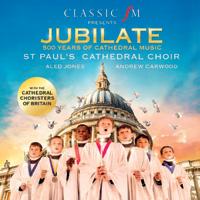
St Paul’s Cathedral Choir with the Cathedral Choristers of Britain
Handel Zadok the Priest; Mendelssohn
Hear my Prayer; Stanford Justorum animae; Weelkes Hosanna to the Son of David; Tallis Salvator mundi; Purcell O God, thou art my God; Greene Lord, let me know mine end; Ireland Greater Love; Vaughan Williams O taste and see; Balfour Gardiner Evening Hymn; Walton Jubilate Deo; Goodall The Lord is my Shepherd; Rutter The Lord bless you and keep you; A Gaelic Blessing (twice); Mealor Ubi caritas; Parry I was glad.
This is a rather special recording, one that will be close to the heart of all members of FCM. It showcases the choir of St Paul’s Cathedral in a programme drawing on the varied repertoire of 500 years of choral music. On four tracks they are joined by a choir of choristers drawn from 50 other choral foundations, one from each. The whole is overseen by Andrew Carwood and supported by Simon Johnson at the organ.
The massed voices appear at the beginning of the CD and again at the end. The disc opens with Zadok the Priest, and the cleanness of the treble sound considering the number of singers involved is remarkable – their runs in thirds are exemplary! Mr Carwood makes no concessions to the (in)famous echo in his chosen tempi, and the result is exciting to say the least! Parry’s I was glad, complete with ‘vivats’, sounds magnificent. I’m not sure why Rutter’s A Gaelic Blessing merits two outings; one features Aled Jones, himself a one-time chorister of Bangor Cathedral.
It is good to hear the resident choir in their regular repertoire. They are clearly on fine form under Andrew Carwood. It is worth noting that eight boys feature in a solo capacity – a sure sign of a healthy top line. The recording manages to balance the choir within itself with considerable realism and also with the organ, so is a most satisfying listen.
Roger Judd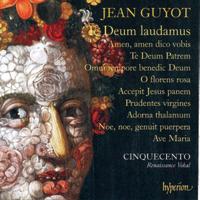
Te Deum Laudamus
Cinquecento Renaissance Vokal Countertenor: David Allsopp




Te Deum patrem; O florens rosa; Amen, amen dico vobis; Accepit Jesus panem; Prudentes virgines; Omni tempore benedic Deum; Adorna thalmum; Noe, noe, genuet puerpera; Ave Maria; Te Deum laudamus.
HYPERION CDA 68180 TT 63:31
The Vienna-based Cinquecento Renaissance Vokal was formed in 2004 primarily to promote the output of more obscure 16th-century European composers. This recording features the extensive oeuvre of Jean Guyot, born in the town of Châtelet in the province of Li ge and educated at the University of Louvain. Greatly influenced by the school of liberal arts, he undertook holy orders and established himself as both a prolific writer and a composer. By 1558, he had already composed more than 26 works, and then was appointed Master of Music in the cathedral of Saint Lambert in Li ge. Within five years, he had been appointed by Ferdinand I to the Imperial Court in Vienna, where he was to write for much larger forces. His stay there was short-lived, as Ferdinand died in 1564 and was succeeded by Maximilian II, who immediately disbanded the existing chapel regime. Guyot returned to Li ge, although there is no evidence of many new manuscripts on his return. His style effortlessly juxtaposes homophonic and contrapuntal writing in a far more fluent and less rhythmically taut style than composers of the earlier Franco-Flemish school.
The quality of singing is both stunning and superbly balanced, despite the frequent similarity of musical texture. David Peacock and the Hyperion team capture a nonclaustrophobic sound whilst maintaining contrapuntal clarity. I especially enjoyed the setting of the Te Deum laudamus where plainsong interjections provide a contrast not obviously evident in the motets. David Gamie’s liner notes are extremely helpful and I find the paintings of Giuseppe Arcimboldo integrated within the jewel case an essential part of the quality of the disc.
David ThorneDir: Nigel Short Owain Park Footsteps; Joby Talbot Path of Miracles.

SIGNUM SIGCD 471 TT 79:22
Tenebrae is an exceptionally fine vocal ensemble directed by Nigel Short, a former member of the King’s Singers. This CD marks Tenebrae’s 15th anniversary and features two works composed for them by contemporary English composers. Path of Miracles by Joby Talbot is in fact a reissue of a highly acclaimed recording made by the ensemble in 2005. Footsteps by Owain Park was specially commissioned to be performed alongside Path of Miracles and was recorded last year. The commission took into account the addition of eight young singers alongside Tenebrae known as the Fellows of the National Youth Choirs of Great Britain (see www.nycgh.org. uk/fellowship for more information).
Joby Talbot describes his Path of Miracles as a 60-minute a cappella choral journey along the Camino de Santiago. The four movements are named after the main staging posts of this famous pilgrimage to Santiago de Compostela in Spain, the final resting place of St James. The opening of the work is unforgettable and really highlights the astonishing virtuosity of the ensemble; starting with low basses, the pitch and volume gradually rise in an amazing effect based on an aboriginal ‘pasiputput’ from Taiwan. It is a most imaginative work, illustrating the different stages of the pilgrimage so colourfully.
Owain Park was first a chorister at St Mary Redcliffe in Bristol, and later senior organ scholar at Wells Cathedral and Trinity College Cambridge. His Footsteps continues the theme of a journey, the work being divided into seasons and using texts by a variety of authors. It is a highly original and effective work and beautifully performed. I thoroughly recommend this CD.
Paul MorganJames MacMillan
The Sixteen
Dir: Harry Christophers
Trad Plainsong; MacMillan Stabat mater dolorosa; Quis non posset contristari; Sancta mater, istud agas; Fac, ut portem Christi mortem.
CORO COR 16150 TT 59:47
MacMillan’s Stabat Mater naturally follows on the same lines as his Seven last words (1994). It is severe, devout and dark.

The iconically Scottish ornamentation of MacMillan’s palette somehow adopts a Middle-Eastern flavour which feels completely at home at Golgotha. There is delicacy about this music, but horror too – with echoes of Penderecki’s Threnody (1960) in places. The densely clustered scoring for strings sounds ‘woody’ and visceral; both tribal and atavistic. The intensity is constant and unrelenting and it is uncomfortable listening in parts. From the opening minor 2nd dissonances, (reminiscent of Kiss on Wood (1994)) to the swarm-like vocal canons and use of speech, intense whispers and, indeed, shouting, this is a varied and rich compositional landscape. The sense of space and silence is meticulously controlled, imparting both breath-like sospiri and moments of panting hyper-ventilation. Fragmentary plainsong footprints proliferate the work – helpfully presented in its entirety as the first track on this disc.
This is MacMillan at his creative best and continuing to push the boundaries of his own language. In the second movement on the words ‘Eia mater’, the sopranos fall, crying from the height of grief juxtaposed with shouting basses: ‘Let me feel the force of your grief’. A short chorale follows (‘Fac, ut tecum lugeam’) with solo violin taking us high above the cross. This is some of the most beautiful and haunting music I have come across. And in the closing moments of the final movement, MacMillan chromatically writhes back to tonality – ‘When my body dies, let my soul be given to the glory of Paradise’ – and the words drop like tears on dusty ground.
The Sixteen and the Britten Sinfonia are perfection. The sound quality and production is excellent and the presentation of the CD is both evocative and insightful. This is a monumental new work and a monumental recording that I cannot recommend highly enough.
George RichfordFROM
Mahler’s 8th Symphony
Organ/choral version by David Briggs (2 CDs)

Soloists and choruses
Cond: Kent Tritle
PRO ORGANO CD 7276
TT 25:35 and 60:54
We live in strange times! In recent weeks BBC Radio 3 has annoyed me with Bach on the accordion, Smetana’s Vltava (or Moldau) on the harp, and any number of 18th-century arias presented as instrumental solos, thus becoming Songs Without Words or, more accurately, Songs Without Singers. Anything is now fair game for the transcriber or arranger, and nothing seems immune to the attentions of the industrious
Mr Briggs, who seems to suffer a compulsion similar to that of the 19th-century Dean of Westminster whose ambition appeared to be to eat his way through every living organism. Now Mr Briggs has tackled a supreme example of musical grandiosity, the so-called Symphony of a Thousand, which Mr Briggs may be said to have reduced to a Symphony of Eight Hundred by dispensing with the orchestra and much of the tonal colour and interest supplied by it. In this version the organ serves well enough as an accompaniment to the choral singing, just as Messiah, Creation and Elijah work tolerably well without a full orchestra, but the instrumental prelude to the second part of Mahler’s 8th Symphony makes no sense at all as an organ solo. It is ‘without form, and void’, indeed a Representation of Chaos! Were I unkindly disposed I might apply that description to some of the singing, especially in the opening, Veni Creator, section. The soprano and tenor soloists sound badly over-taxed at times, even appearing to risk physical damage; but a saving and delightful grace is afforded by the choristers of the Cathedral of St John the Divine, New York, where this performance was assembled and recorded. These CDs might be of interest to organ-fanciers, or as a memento of a notable occasion, but no one should regard them as a proper introduction to ‘Mahler Eight’.
Timothy StoreyJ S Bach
Choir of King’s College, Cambridge
Dir: Stephen Cleobury
Two CDs
KINGS KGS 0018 TT 54:03 and 55:20
The Passion according to St John follows Jesus from the Garden of Gethsemane via his arrest and trial to his crucifixion. It is a wonderful work, dramatic, full of human interest and offering the chorus full scope to adopt the personae of such diverse groups as the high priest’s servants, the self-important bigwigs of the civic and religious establishment, the crowd in all its varying moods, and even the Roman soldiers casting dice for the crucified Jesus’s coat. The faithless Peter’s rather half-hearted attempt to follow the captive Jesus calls forth one of Bach’s loveliest arias, ‘I follow thee also, my Saviour, with gladness’, in which the soprano soloist is accompanied by two flutes in unison, a delectable inspiration. The (anonymous) text is a prayer that Christ should show the believer the true way and is typical of the arias (mercifully few in number) and the chorales in relating the events of Good Friday to Our Lord’s final victory and to the life of the redeemed, on earth or in heaven. Even the aria ‘All is fulfilled’ refers to Christ as the Lion of Judah, victorious over death; it is one of the work’s greatest movements, a setting for alto with viola da gamba obbligato, a striking use of an old-fashioned instrument.
I came to know and love this work through the Kings/ Willcocks 1960 performance, now happily reissued as part of a boxed set of all the ARGO recordings of the choir. It was the era of performances in English, and of notable interpreters of the evangelist’s role, not the least of them Peter Pears, who in this 1960 recording sang quite incomparably in a performance which by the standards of the day was historically informed but retained some romantic influences in the treatment of the arias and chorales and in the choir’s expressive characterisation of the different groups depicted by the choruses. We do things differently now, and performances tend to be brisk, devoid of obvious ‘expression’ and sung in German with an orchestra of ‘period instruments’. The CDs here reviewed are thoroughly up-to-date in every respect that matters; the music is admirably sung and played, with a top-notch team of soloists. It is as ‘authentic’ as we have any right to expect, save only in the use of adult soprano and alto soloists; for of course we have a choir of boys and young men,
in absolutely top form. These CDs should be the first choice of any serious Friend of Cathedral Music.
Timothy StoreyDir: Owen Rees
Organ: David Bednall MacMillan Alpha and Omega; Bring us, O Lord God; Harris Bring us, O Lord God; Faire is the heaven; Dubra Stetit angelus; Bainton And I saw a new heaven; G Jackson Ecce venio cito; McDowall I know that my Redeemer liveth; Toby Young Seven Trumpets; Marco Galvani Et vidi angelum; Leighton Alleluia, amen; Rutter Hymn to the creator of light; Philip Cooke The world on fire; Bednall The Seventh Angel.
SIGNUM SIGCD 475 TT 78:17



A number of fine performances of highly demanding music are included on this disc, which was recorded in the chapels of Queen’s and Keble College. In his notes, Owen Rees explains the genesis of the CD. ‘The inspiration came from the extraordinarily moving and powerful funeral service for a dear colleague of mine, Dr Jackie Stedall, a service devised by Jackie herself.’ The overall theme of most of the anthems is based on Revelation and consists of a number of settings by mostly contemporary composers whose writing stretches the singers to the maximum. The dazzling descending chords heard at the beginning of James Macmillan’s Alpha and Omega, permeating the opening of the piece, contrast effectively with an extremely agile middle section reflecting the accomplished technique of the ensemble. The blend in William Harris’s setting of Bring us, O Lord God is very fine, and the piece is performed with great sensitivity. The atmospheric beginning of Bainton’s And I saw a new heaven is well captured in a particularly unhurried performance; this feeling of timelessness is mirrored in the sensitive accompaniment played by Rebecca Baker, and the release after the extreme tension in the middle section allows the beautiful melodic line set to ‘And God shall wipe away all tears’ to be even more poignant. Rihards Dubra’s setting of Stetit angelus features a rich male tone heard to great effect against well controlled oscillating upper voices which paint a wonderful sound picture of the text. The final piece, The Seventh Angel, composed and accompanied by David Bednall, reveals virtuosity, intensity and drama. The whole comprises a superb disc.
David ThorneAlexander L’Estrange

Tenebrae
Dir: Nigel Short Organ: James Sherlock New College Service M&N; Lighten our darkness; Let all the world in every corner sing; The Lord’s Prayer; Tune me, O Lord; On eagles’ wings; Oculi omnium; My song is love unknown; God be in my head; Panis angelicus; Lute-book Lullaby; Epiphany Carol; Hodie!; Let the people praise you; An Irish Blessing SIGNUM SIGCD 454 TT 72:03
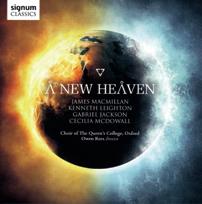
Mr L’Estrange has an impeccable pedigree as a composer of choral music: chorister at Magdalen College, Oxford; undergraduate singer with the same choir; and a distinctly useful countertenor on the London circuit. His ability and experience as a jazz double-bass player of some distinction add a further dimension to his compositional style. That said, one has to admit that a whole CD of a single composer is a searching and arguably unfair test of his abilities, and one was conscious of a certain sameness of style in this programme, much of the music being chordal and slow-paced, not greatly

livened by tinkly organ accompaniments à la Jonathan Dove. Of particular interest is My song is love unknown, a setting of most of the well-known hymn, in which soloists and the full choir adorn the first and last verses with a simultaneous translation into Latin; this is a fine academic conceit, and as a Classics graduate I can vouch for the quality of the Latin. It is, though, a strange inversion of Britten’s rather more useful practice in Hymn to St Peter, wherein the treble soloist’s Latin is translated into English by the choir. Head and shoulders above the rest stands Hodie, a strikingly lively and tuneful response to a request for something bright and not too difficult to enliven Christmas services or concerts. If you have not yet settled your programme, investigate this; it is published by Alfred Music and full details are on the internet. The CD is worth buying for this alone, and of course for the sheer delight of Tenebrae’s usual fine singing, impeccably accompanied and recorded.
Timothy StoreyChoir of Westminster Abbey
Dir: James O’Donnell
Organ: Daniel Cook
Finzi My lovely one; God is gone up; Welcome, sweet and sacred feast; Let us now praise famous men; Lo, the full, final sacrifice; Magnificat; Bax I sing of a maiden that is makeless; This worldes joie; Ireland Greater love hath no man; Ex ore innocentium; Te Deum in F. HYPERION CDA 68167 TT 73:40

This is a magnificent CD of magnificent repertoire. The choir of Westminster Abbey under James O’Donnell is on the very finest form, and Daniel Cook’s use of the Abbey organ is kaleidoscopic and entirely in sympathy with the music. There is much on this disc that is not on the average choir’s music scheme. This is largely because of the scale of the music and the demands that it makes on performers, be they singers or players. So it is doubly splendid to have them recorded here in such ideal circumstances.
These last remarks refer especially to the two pieces by Arnold Bax, I sing of a maiden and This worldes joie. Throughout the choir there is total security of tuning and in this harmonically wide-ranging music this is absolutely vital. As a result the listener is rewarded with the full effect of the rich chromaticisms, and wonderful they are. The ensemble within this choir is exemplary too. The perhaps less familiar music of Finzi is similarly blessed in these performances. It is good to have such fine recordings of Welcome, sweet and sacred feast and the Magnificat, alongside Lo, the full, final sacrifice (is there a lovelier setting of the ‘Amen’?).
The three pieces by John Ireland complete this programme of some of the finest British church music of the 20th century. I was especially pleased that the anthem for trebles, Ex ore innocentium, is included – it is beautiful, and here is most affectingly sung. Listening to the Te Deum in F reminds one of how much of such music has been lost with the demise of sung Mattins.
The recording is what one would expect from Hyperion –superb. Unsurprisingly awarded five stars.
Roger Judd



Callino Quartet
Introduction, 7 Sonatas, il terremoto (The Earthquake)
CORO COR 16152 TT 67:14
In 1786 Haydn received from a priest in Cadiz a commission for orchestral music to accompany the following year’s
Passiontide devotion in the grotto of Santa Cueva. ‘The walls, windows and pillars of the church were hung with black cloth, and only one lamp hanging from the centre of the roof broke the solemn darkness. At midday, the doors were closed and the ceremony began. After a short service the bishop ascended the pulpit, pronounced the first of the seven words (or sentences) and delivered a discourse thereon. This ended, he left the pulpit and prostrated himself before the altar. The interval was followed by music. The bishop then in like manner pronounced the second word, then the third, and so on, the orchestra following on the conclusion of each discourse.’ The work was published within a year of its first performance and proved so popular that Haydn soon arranged it for string quartet, the version recorded here. The Seven Words are matched by seven slow movements plus a solemn prelude and a loud, energetic postlude which portrays the earthquake which attended the death of Jesus.
One has to admit that seven slow movements do not provide easy or comfortable listening, and close attention to the (unusually legible) booklet is necessary, so that one knows which Word one has reached. However, the effort is well worthwhile, for we have here a work of the most profoundly religious inspiration. Also, I expect never to hear a finer string quartet; for tuning, ensemble and control of dynamics are beyond reproach in an expressive and compelling performance which I recommend with great enthusiasm.
Timothy StoreyChoir of Trinity College, Cambridge
Trinity Brass
Dir: Stephen Layton
Organ: Owain Park/Alexander Hamilton
For lo, I raise up; Te Deum in C; Three Motets
Op. 38; Lighten our darkness; Benedictus in C; O for a closer walk with God; Jubilate in C; Magnificat for eight-part chorus in B flat; Fantasia and Toccata in D minor; Eternal Father; St Patrick’s Breastplate. HYPERION CDA 68174 TT 81:02
Stanford was organist of Trinity College Cambridge from 1873 to 1892, during which time he composed a considerable amount of music for the choir. The much-loved Three Latin Motets, dedicated to the choir and dating from this period, are among the highlights of this CD. Justorum animae and Beati quorum via are performed with moving delicacy, with appropriate jubilation being given to Coelos ascendit. The other work using Latin words, but composed some 30 years later, is a fine Magnificat in B flat for double choir dedicated to Parry and drawing inspiration from an energetic motet by Bach. Like the other unaccompanied items, it was recorded in the chapel of Trinity College with the same acoustics as Stanford would have known.
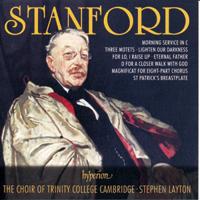
The accompanied items and the organ solo were recorded in the larger acoustic of Hereford Cathedral.
The anthem For lo, I raise up, composed in 1914, was clearly influenced by the war with Germany. It is given a riveting performance from the thundering horsemen of the opening to the quietness of the Lord in his temple at the anthem’s conclusion. Stanford’s Evening Canticles in C are probably the most frequently performed throughout the Anglican church. It is therefore good to hear the fine, but less well-known, morning canticles. The Te Deum has the additional accompaniment of brass and timpani, as does a setting of ‘St Patrick’s Breastplate’. The senior organ scholar, Owain Park, plays the rousing Fantasia and Toccata in D minor on the excellent Willis organ of Hereford Cathedral with great panache. Altogether a wonderful recording, thanks to the notable singing of the 30 choral scholars and two organ scholars of Trinity College under their distinguished conductor, Stephen Layton.
Paul Morgan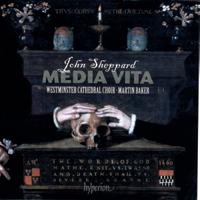
Choir of Westminster Cathedral
Dir: Martin Baker
Media vita; Gaude, gaude, gaude Maria; Missa Cantate
HYPERION CDA 68187 TT 79:47
Two towering pieces of early English polyphony set this CD on a very special pedestal. The title track is the monumental six-voice Media vita, coming in at around 30 minutes, and written in nine sections. Gaude, gaude Maria is by contrast a positive lightweight, lasting a mere 14 minutes! The Missa Cantate, literally Sing Mass, makes up the remainder of the disc.
I must start by saying that this glorious music receives a performance that does it the most wonderful service. The choir of Westminster Cathedral is on absolutely top form, and Martin Baker’s direction of the music allows it to unfold in an unhurried and utterly convincing way. I could listen to this music in performances as fine as this is for a very long time. The boys of the choir, who at times have stratospheric lines to sing, are especially memorable.
Hyperion’s production of the CD is as good as you’d expect from them, and it is completely irrelevant to mention that the recording was made, not at the cathedral, but at All Hallows, Gospel Oak.
I cannot recommend this disc highly enough – I am so pleased to have heard it.
Roger JuddSiglo de Oro
Dir: Patrick Allies
Saxophone: Sam Corkin
Weir Drop down, ye heavens, from above; Will Todd O wisdom; Pierre Certon O Adonai; Matthew Kaner O Adonai; Bonnie Miksch

There is no rose; Sam Rathbone O root of Jesse; Antoine de Mornable O clavis David; Pott O key of David; Allain O day-spring; Praetorius Praesepe iam fulget tuum; Gareth Wilson O King of the nations; Stuart Turnbull O Emmanuel; Josquin des Prez O virgo virginum; Allwood O virgin of virgins.
DELPHIAN DCD 34184 TT 64:45


Forget the chocolate-laden Advent calendar this year, indulge yourself instead by listening to a track a day of this superb disc. The singing is sumptuous, ethereal and slightly ‘Baltic’sounding; hollow, airy and sensitive. Intonation and balance are rarely anything other than perfect, and the sense of musical line is compelling and meticulous.
Many will know of the Hilliard Ensemble’s collaboration with Jan Garbarek – a revelation in the shared soundworld of voice and saxophone, where there are moments when voice and instrument are practically indistinguishable. Although the same unison timbre isn’t achieved on Drop down, ye heavens, this disc goes beyond the improvisatory world of Officium and Mnemosyne with captivating and radically diverse commissions. Todd’s setting of O Wisdom is a rhythmic paean which nods its head towards the jazz genre. The saxophone line feels most improvisatory in this piece. Rathbone writes with a thoroughly evident knowledge of both saxophone music and the choral idiom. A meandering sax solo opens the work and paints a picture of wilderness. With perhaps the most distant echoes of Leighton’s music, the work subsides with a recapitulation of the opening with a yearning ‘Come and deliver us’ which was deeply moving.
Allain’s music deserves to be performed and recorded more in this country. This work is one of the highlights of the disc; an alluring, multi-layered tapestry upon which the
Antiphon is presented in a late, unadulterated descant on the soprano sax.
There are several almost unknown works of 16th-century polyphony on this CD, all of which are worth knowing. The delivery of these pieces is excellent, although the meticulous ‘Siglo sound’ becomes a little less defined and slightly more generic in dense passages of polyphony.
Pott’s O key of David encapsulates the mystery of Advent unlike any other work on the recording. Footsteps of the plainsong are evident throughout, especially the reversed, descending figure prominent in the saxophone line. Turnbull’s setting of O Emmanuel is most striking and different with a frenetic style full of tonal and registral juxtapositions. There are similarities to Pärt’s music but with a thoroughly original and fresh palette of expressive devices.
Corkin’s playing is a superb match for the group and the sense of line, shape and musical delivery is clearly completely shared with director Patrick Allies. This could be a very exciting musical partnership, especially considering this is the first commercial release for Siglo de Oro. More, please.
George Richford...transforming
The Royal School of Church Music supports the work of cathedral musicians at every level under Director Andrew Reid and Head of Choral Studies Adrian Lucas.

In addition to a broad programme of parochial support, ministerial training and related publications, the RSCM is responding to cathedrals’ requests by training organ scholars-elect through the Survival Kit course (29–31 August 2017, venue tbc).
Ex-chorister boys and girls may audition for the Millennium Youth Choir which offers high-calibre and context-based learning to older teenagers and young adults. Find out more online at www.rscm.com/myc
To find out more about suitable courses and opportunities, visit our website at www.rscm.com/learn-with-us
Allegro Music ................................55

Campaign for the Traditional Cathedral Choir ........66
Christ Church Cathedral School ..............46 & 67
George Sixsmith Organs ........................66
Harrison & Harrison .........................23
Herbert Howells Trust ..........................46
Makin Organs ...............................2
Regent Records ...............................67
Royal School of Church Music ....................65
The Guild of Musicians & Singers ................67

Viscount Classical Organs .......................4
Westminster Abbey Choir .......................27
We provide all types of new instruments

New Organs
Restoration
Rebuilding
Tuning
Maintenance
We can give unbiased advice for all your requirements

Hillside Organ Works Carrhill Road, Mossley, Lancashire OL5 0SE Tel: 01457 833 009
www.georgesixsmithandsonltd.co.uk

Master: Professor Dr Maurice Merrell Secretary General: Dr Michael Walsh
The Guild of Musicians and Singers was formed in Oxford in June 1993 with the aim of bringing together amateur and professional musicians in working and fraternal ways. The Guild has a fund with bursaries for students to help them with examination fees and other aspects of their careers in music. The Guild has many distinguished musicians among its Hon Fellows, including Sir Mark Elder, Dr Vasily Petrenko, Dame Evelyn Glennie, Dame Patricia Routlege, Dr. Francis Jackson, Andrew Carwood, Benjamin Grosvenor and Rick Wakeman. Our next General Meeting is at Allhallows-by-the-Tower at 2pm on 28 April 2018 when we will be entertained by THE TIFFIN SCHOOL BOYS’ CHOIR Academic Dress is available and membership is £15 a year. Full details from the Guild’s website: www.musiciansandsingers.org.uk.

Choral Music by Philip Stopford
The Choir of Truro Cathedral BBC National Orchestra of Wales directed by Christopher Gray
REGCD517
Moving and uplifting anthems, motets, and music for Christmas, with rich orchestral accompaniment, from one of the most popular and prolific writers of new British choral music.
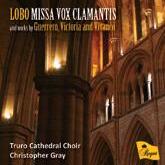
and works by Guerrero, Victoria and Vivanco
The Choir of Truro Cathedral directed by Christopher Gray
REGCD491





Spanish and Portuguese works from the Golden Age of Renaissance polyphony, including masses by Victoria and Lobo and Vivanco’s large-scale eight-part setting of the Magnificat. ‘energised, forward-driving phrasing and the forthright delivery makes for an exciting performance .’ Gramophone
Music from the Golden Age

The Choir of York Minster directed by Robert Sharpe, David Pipe (organ)
REGCD488
A wide-ranging survey of the development of sacred choral works from immediately before the reign of Queen Elizabeth I to the early Jacobean period following.
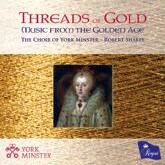
‘A radiant recording of glorious music’ Early Music Review
The Choir of St Patrick’s Cathedral, Dublin directed by Stuart Nicholson, David Leigh (organ)


REGCD504
Music by past and current Directors of Music, Stanford’s extended setting of St Patrick’s Breastplate, and Philip Moore’s anthem All wisdom cometh from the Lord, celebrating Dublin-born Jonathan Swift.
The Choir of Birmingham Cathedral directed by Marcus Huxley, David Hardie (organ)
REGCD490

A collection of favourite anthems for the church’s year, including three works written over the last twenty years for Birmingham Cathedral, here receiving their first recording.

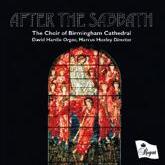
REGENT RECORDS, PO Box 528,Wolverhampton, WV3 9YW Tel: 01902 424377 www.regentrecords.com (with secure online ordering). Retail distribution by RSK Entertainment Ltd, Tel: 01488 608900, info@rskentertainment.co.uk. Available in the USA from the Organ Historical Society www.ohscatalog.org.

